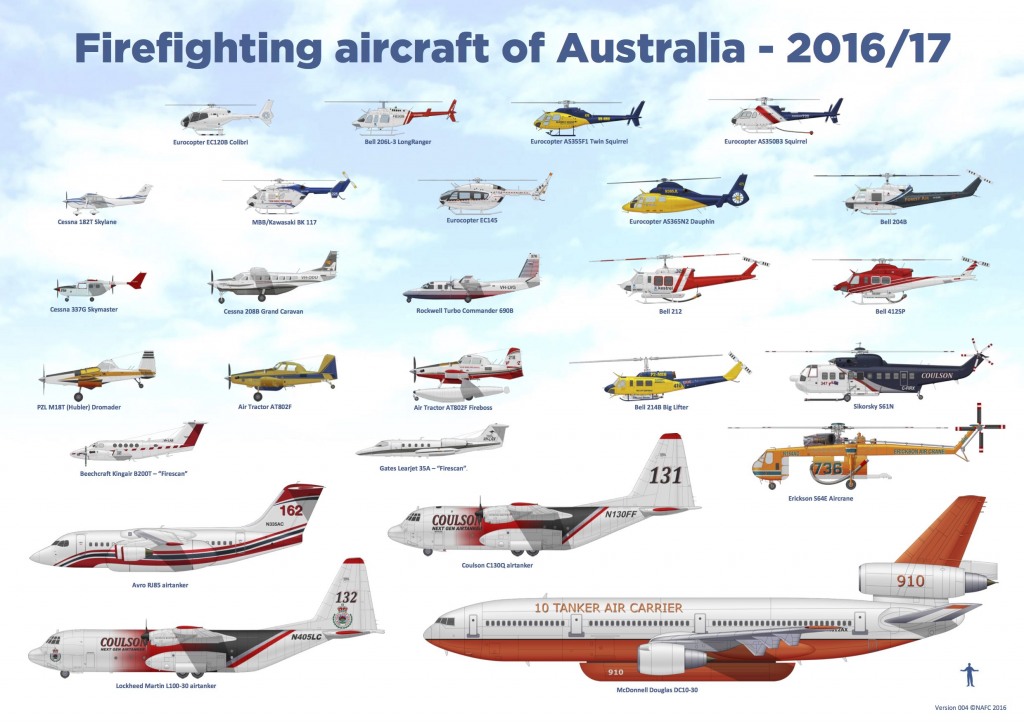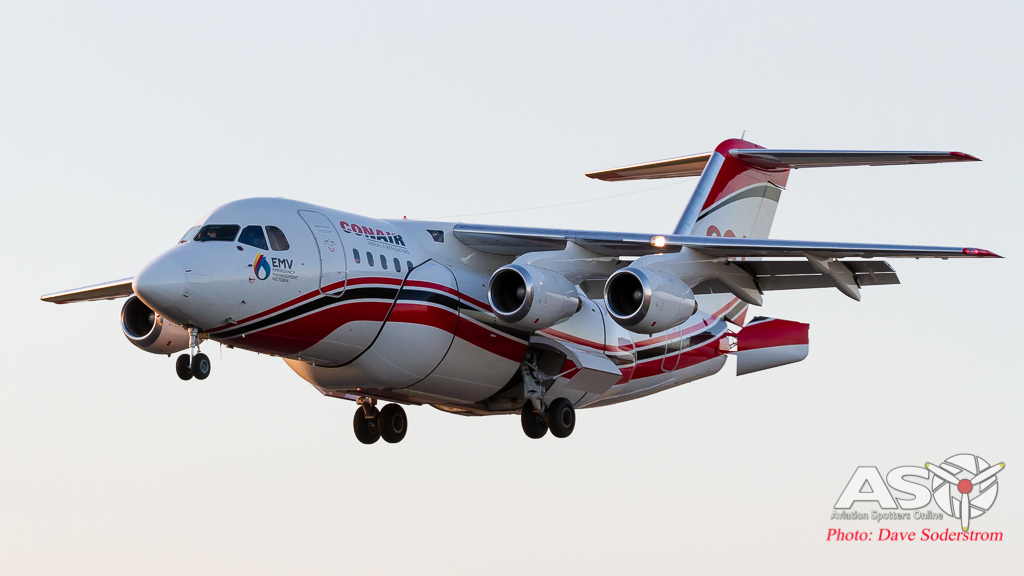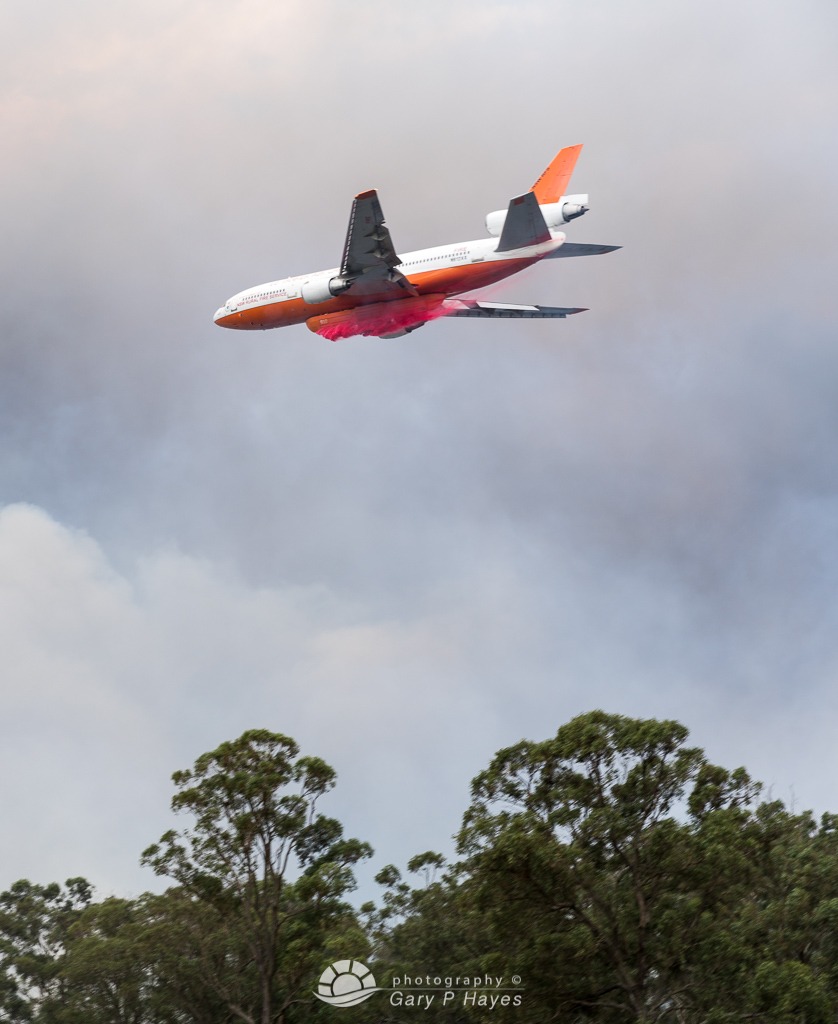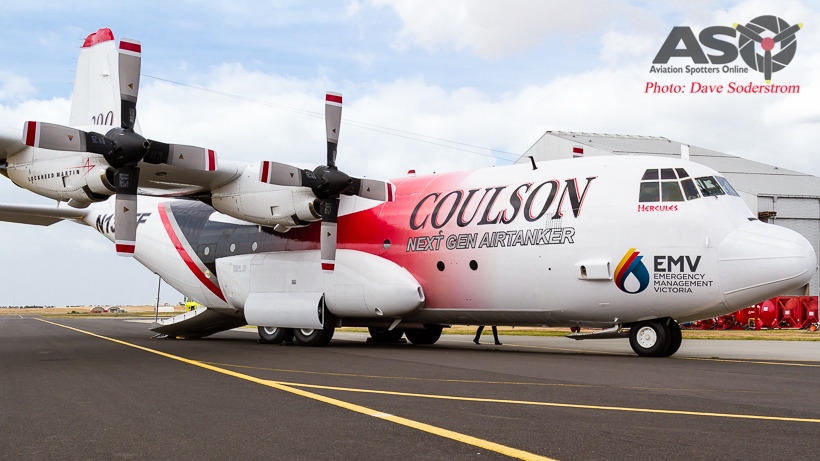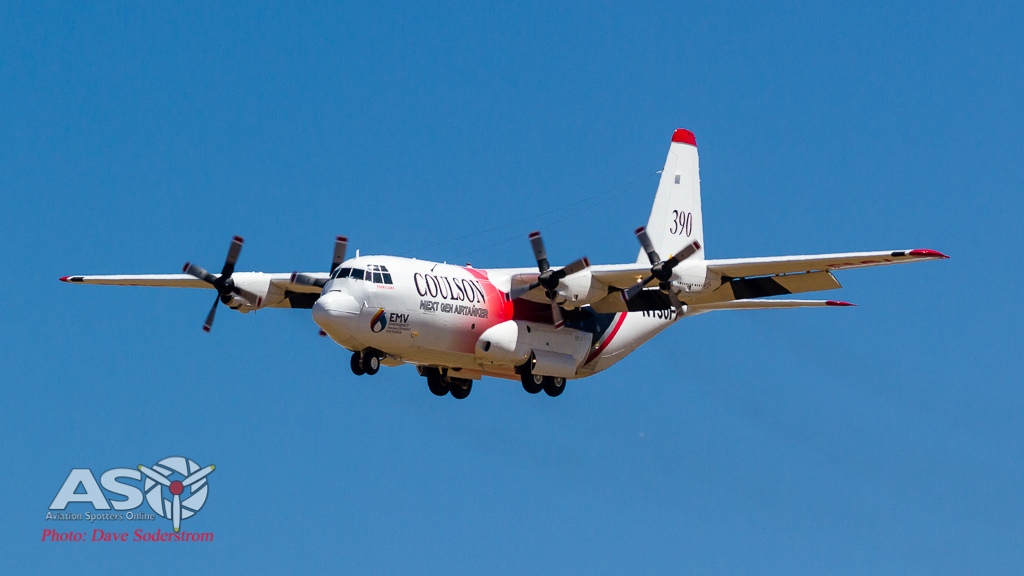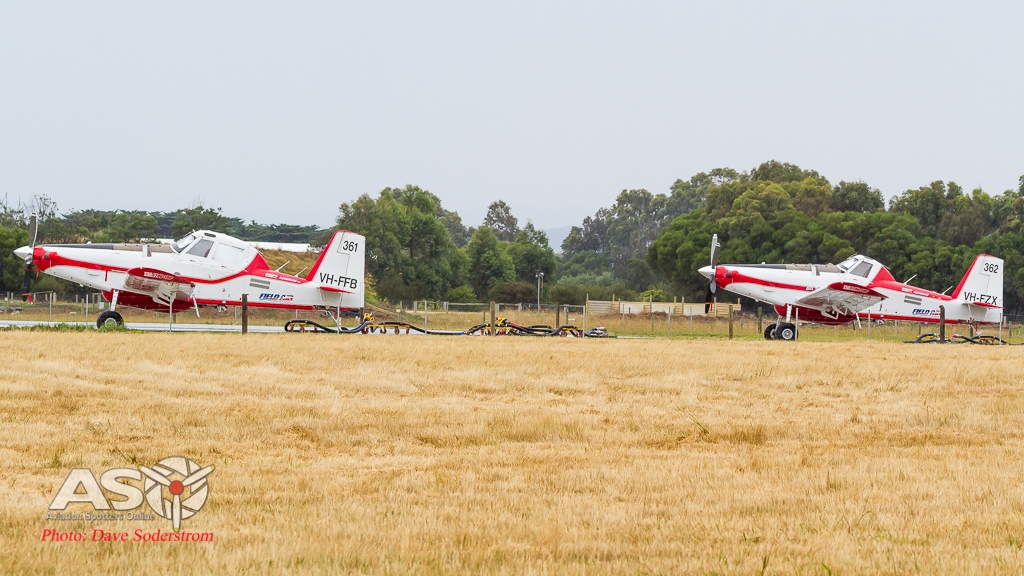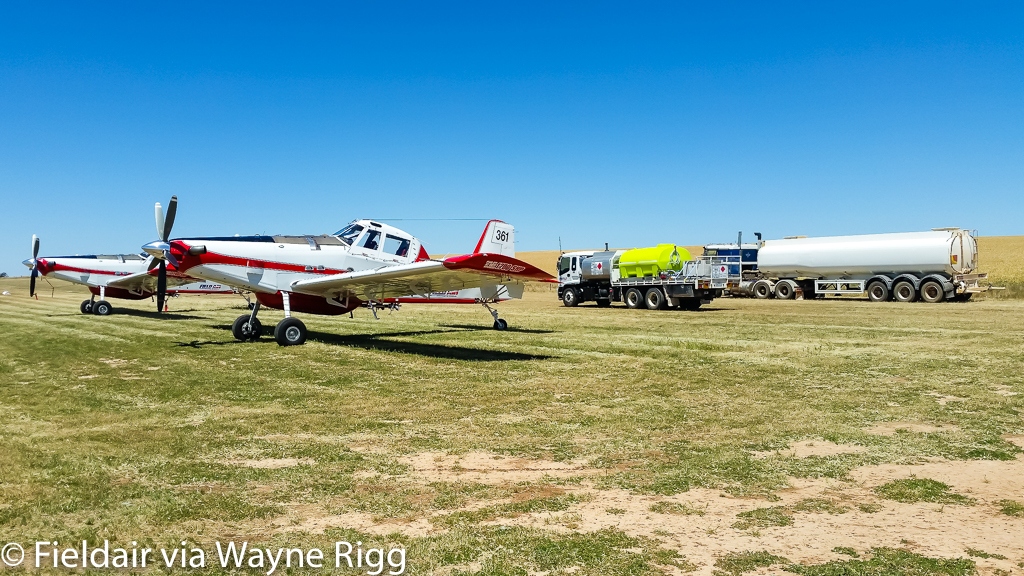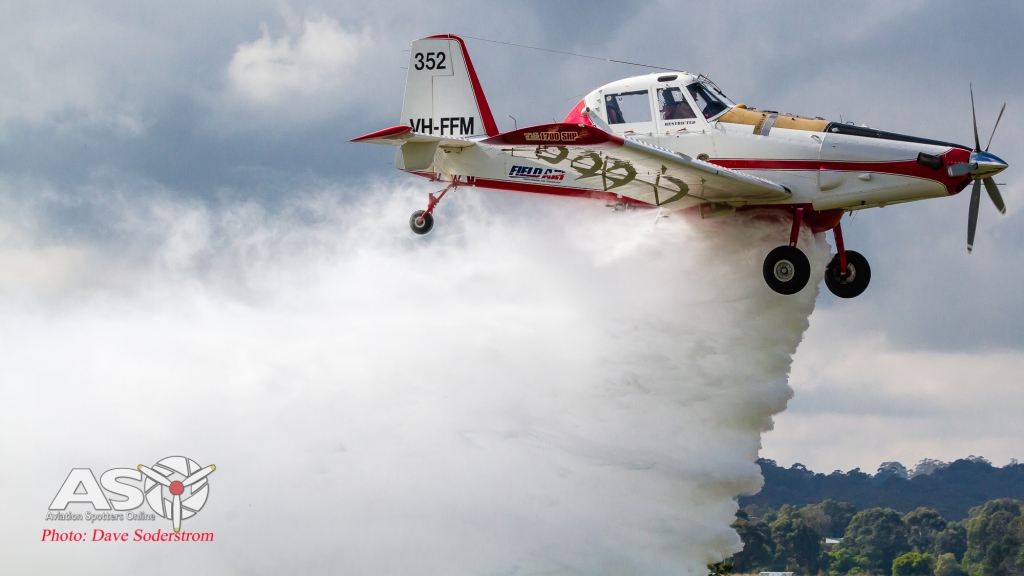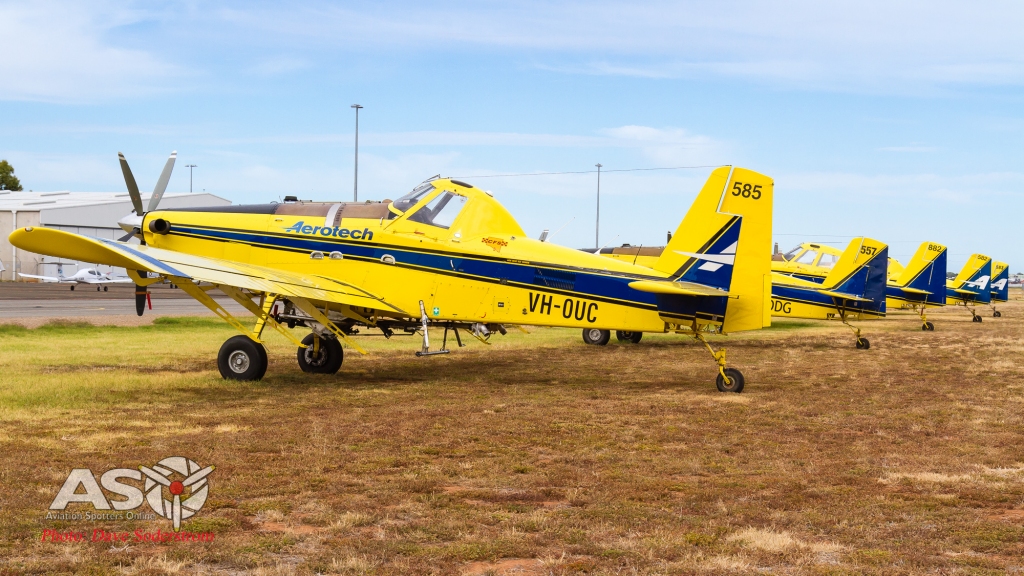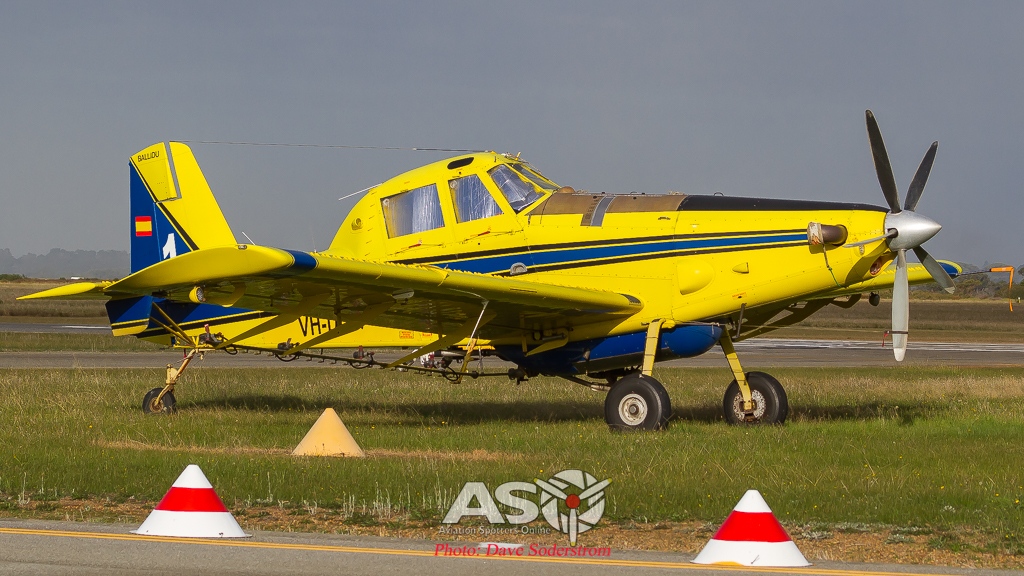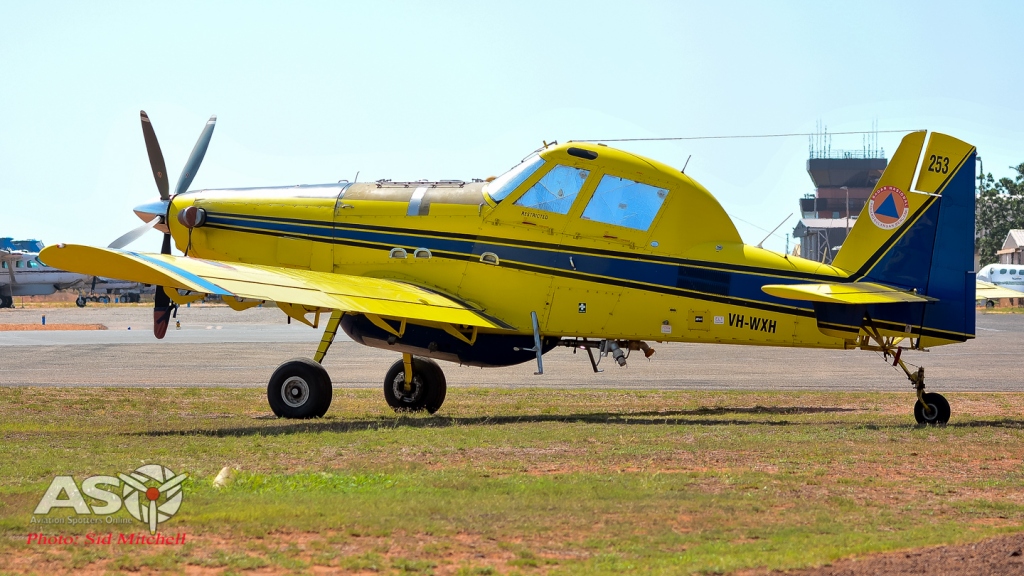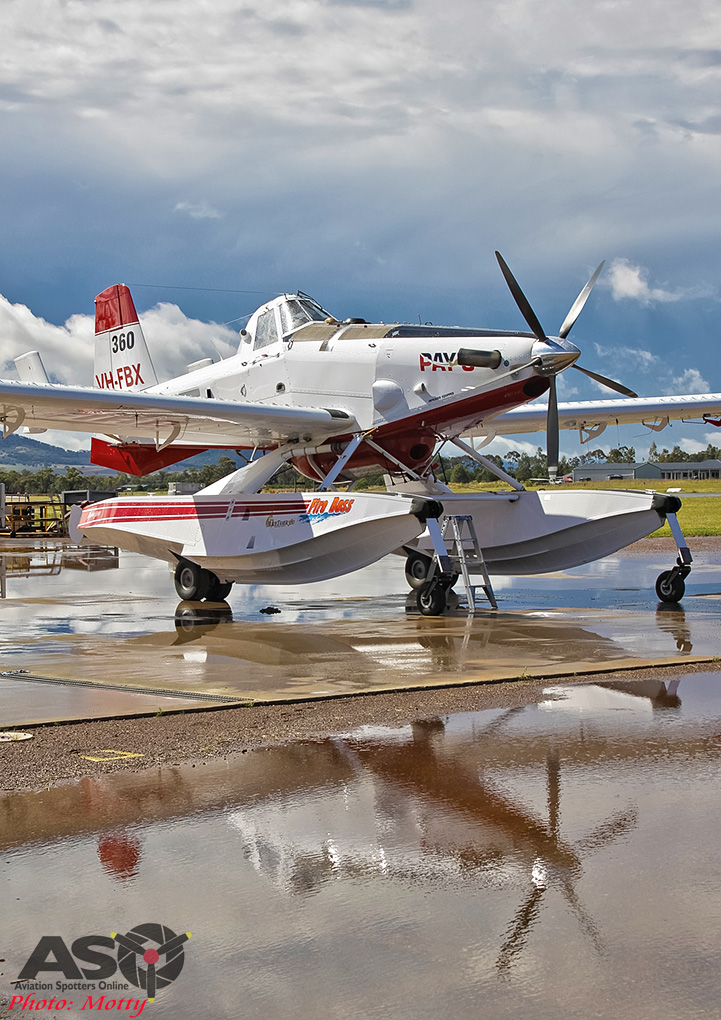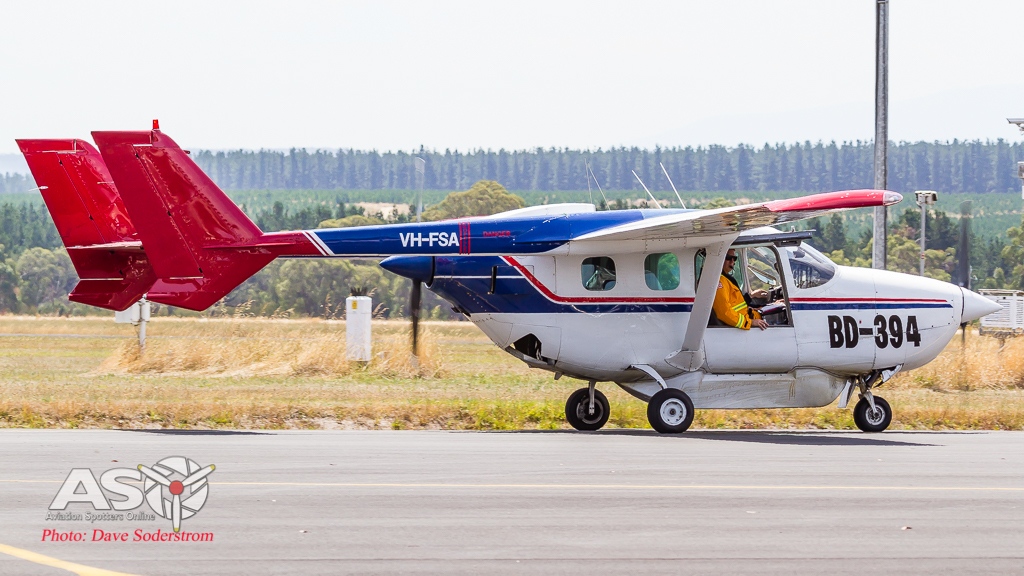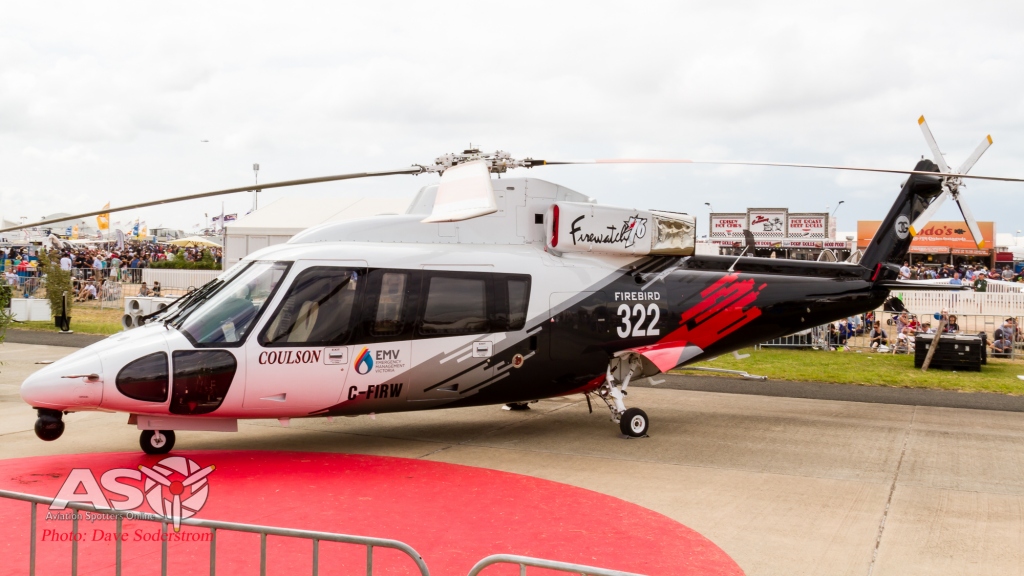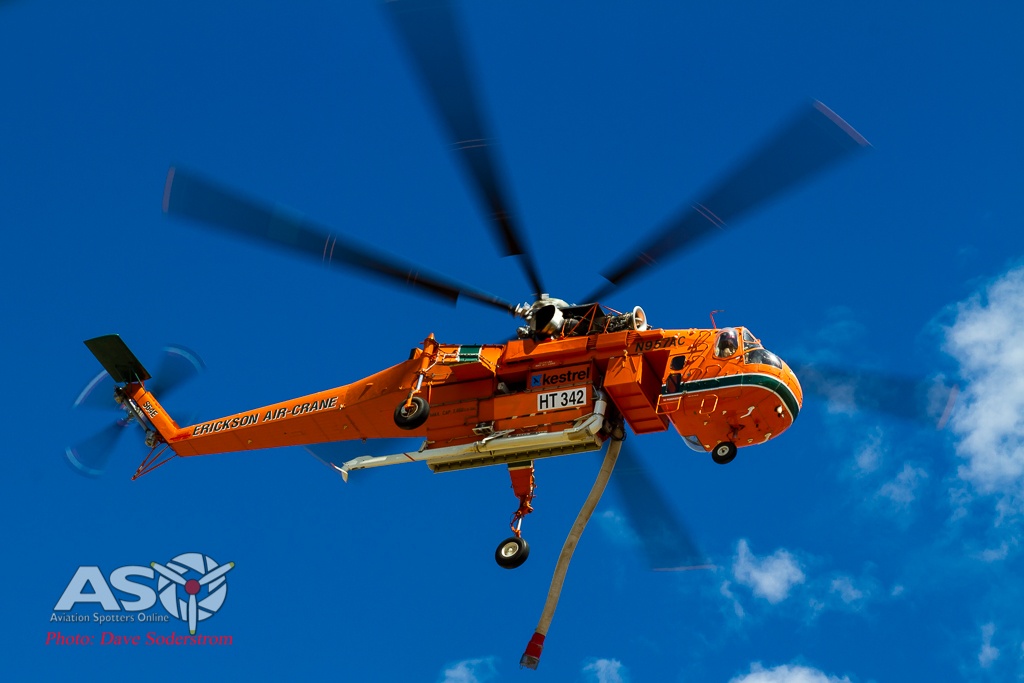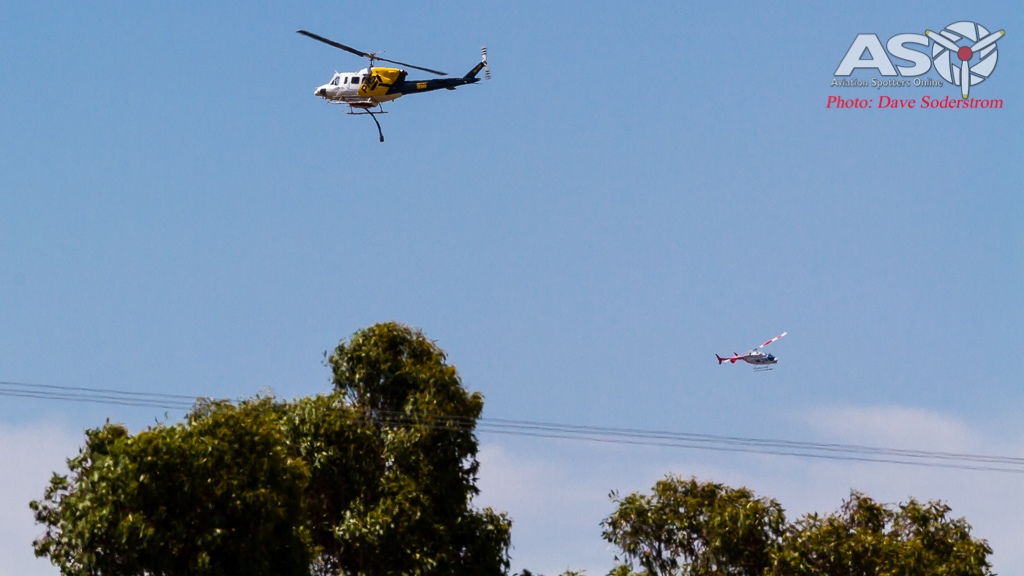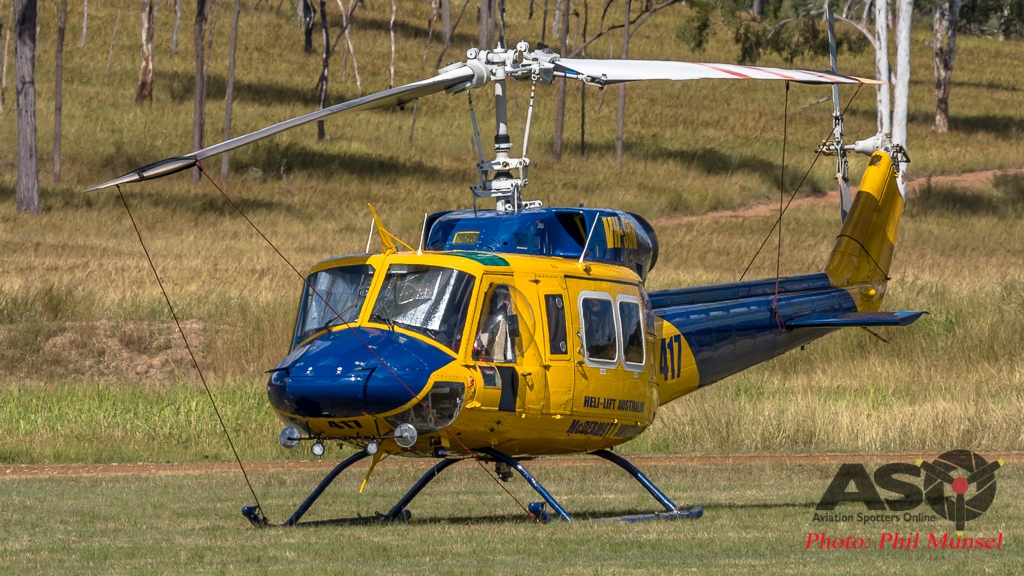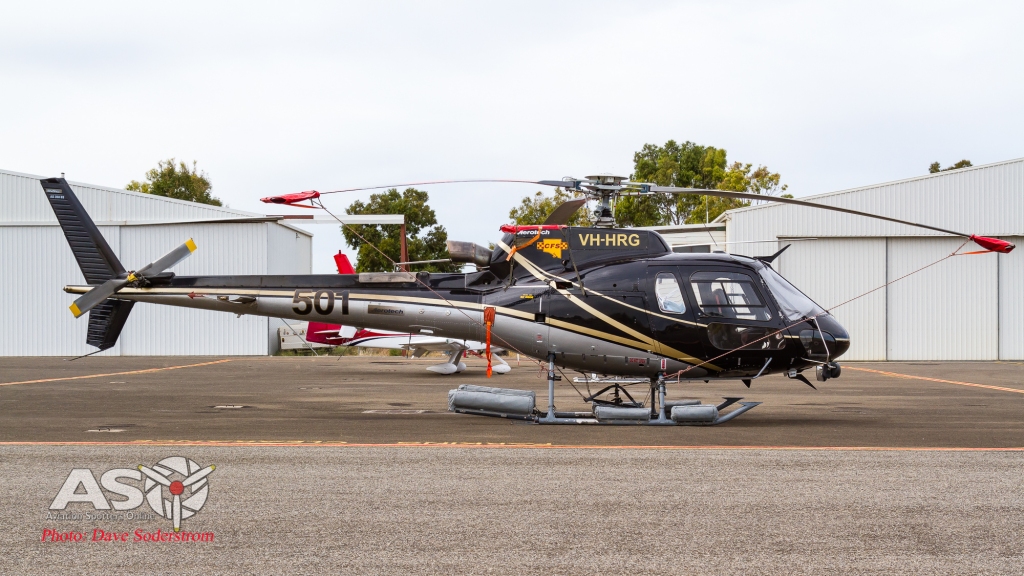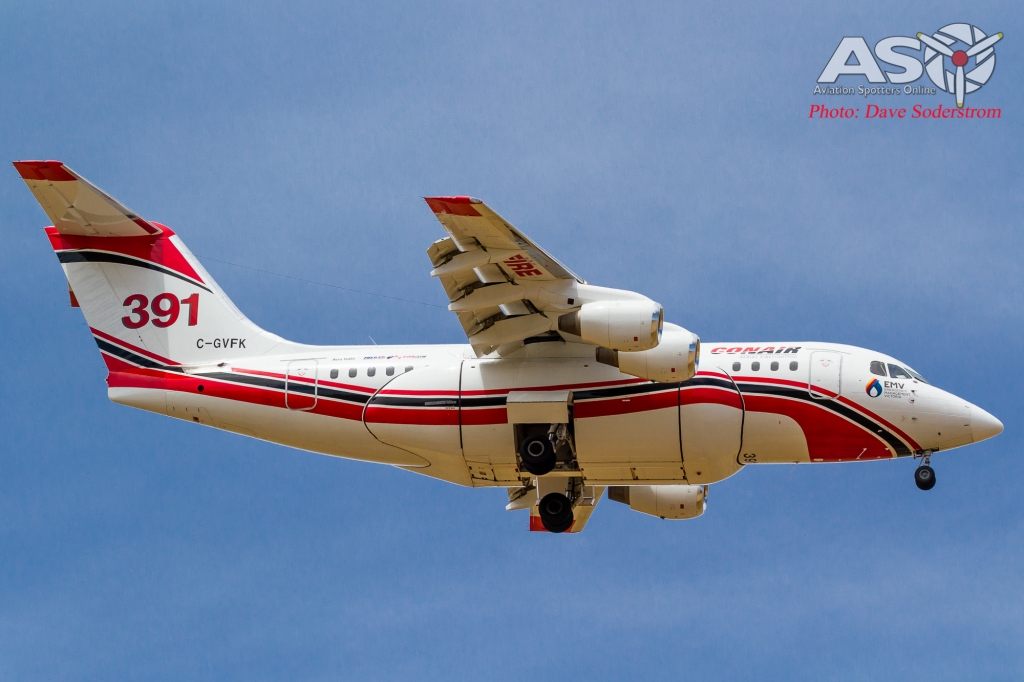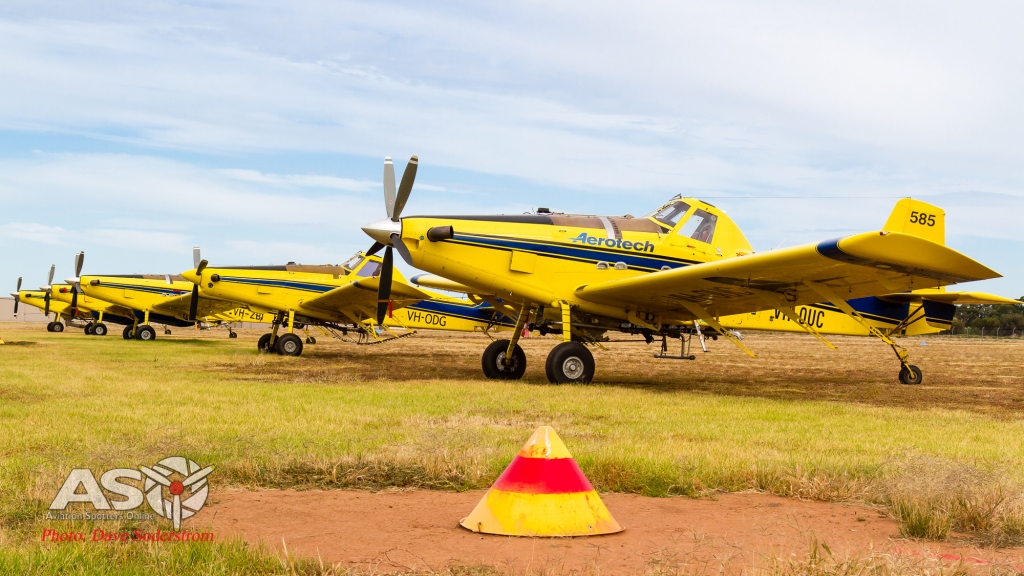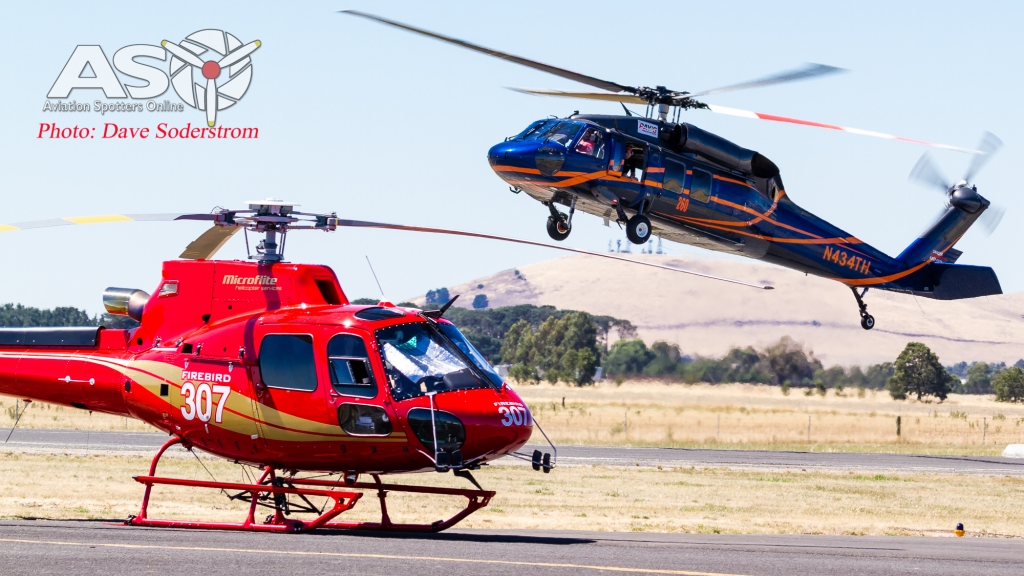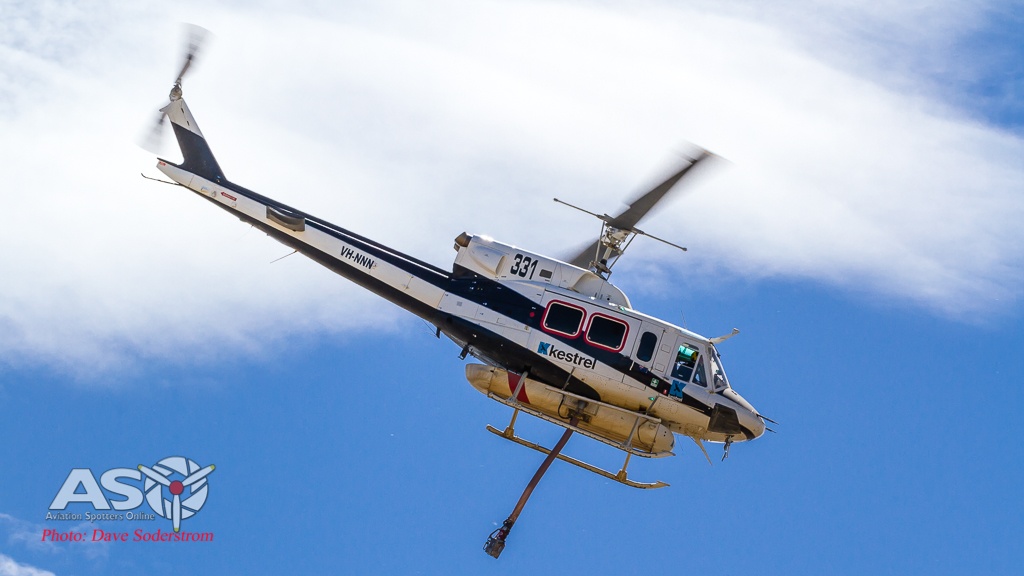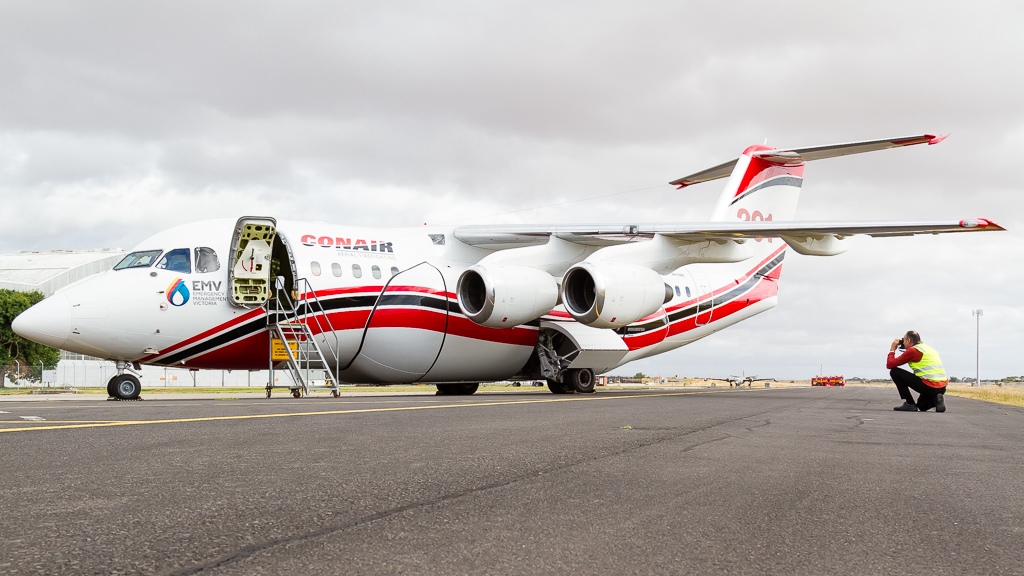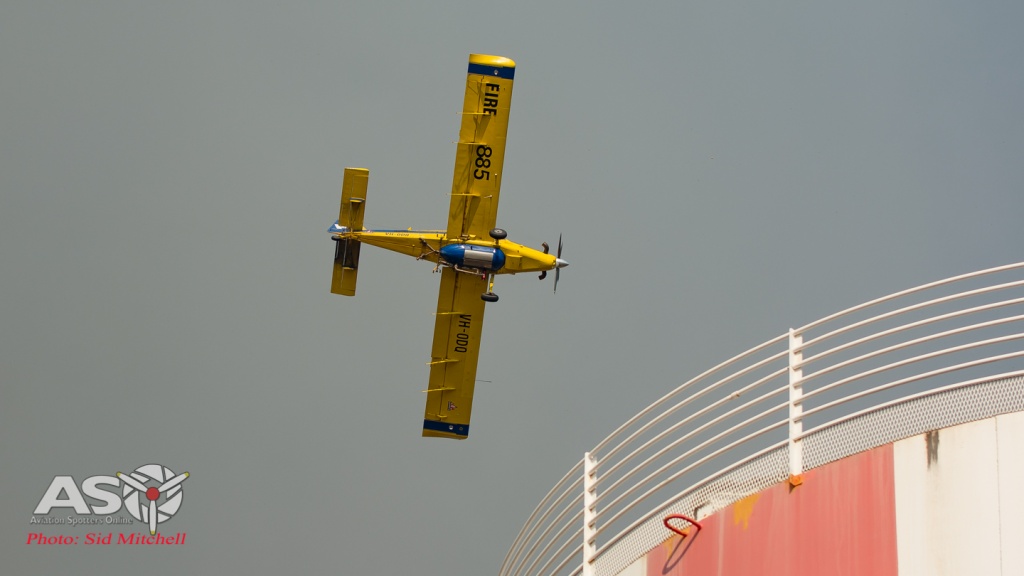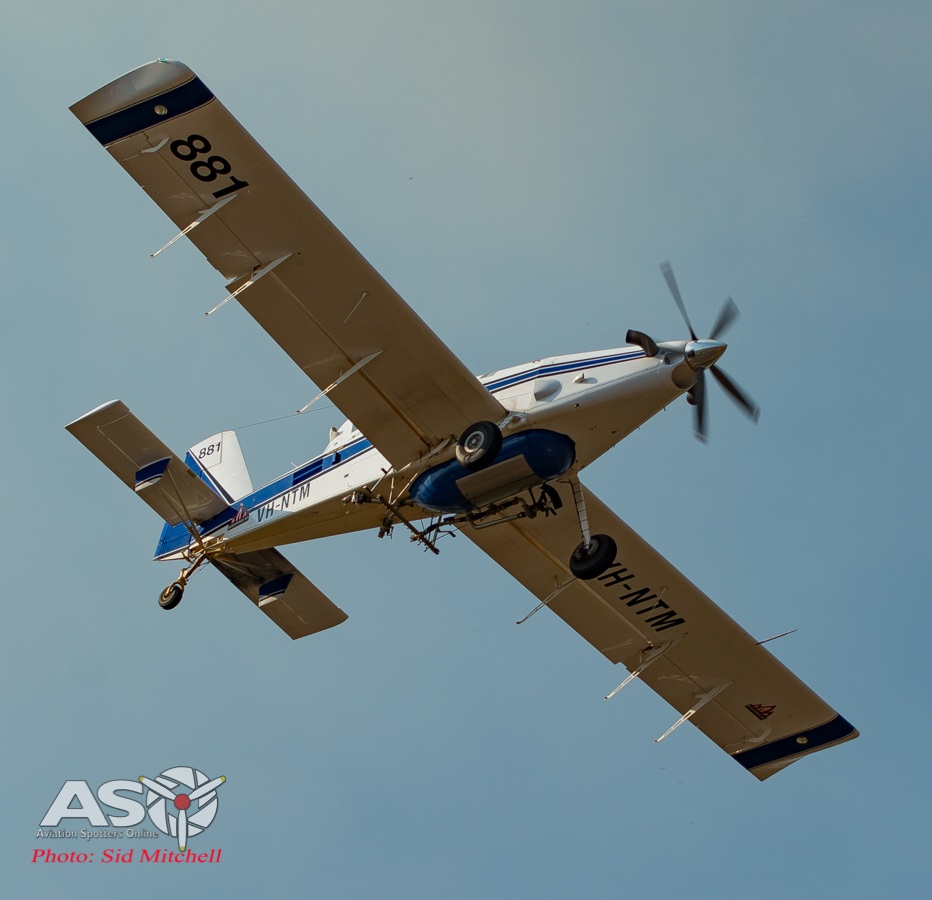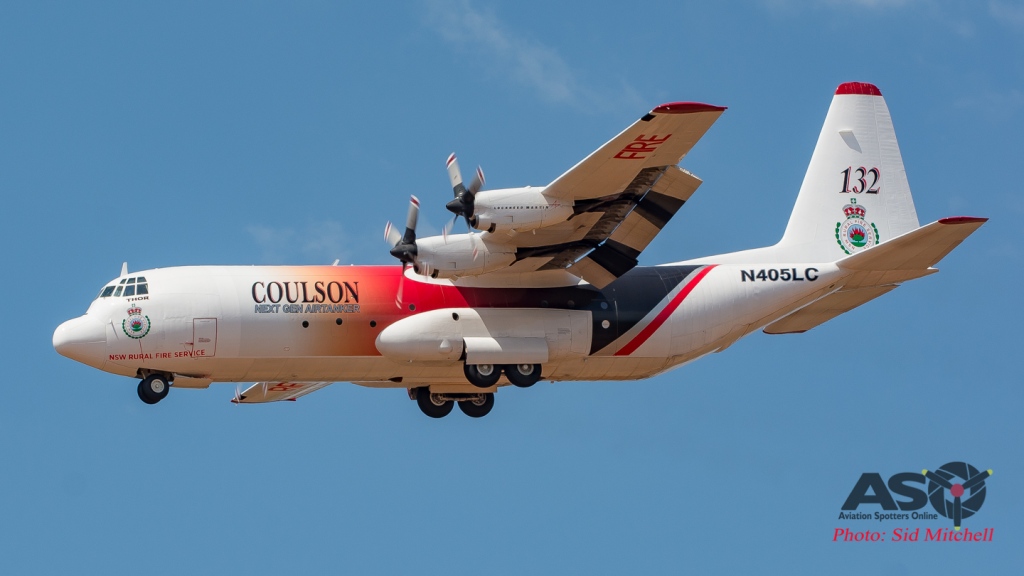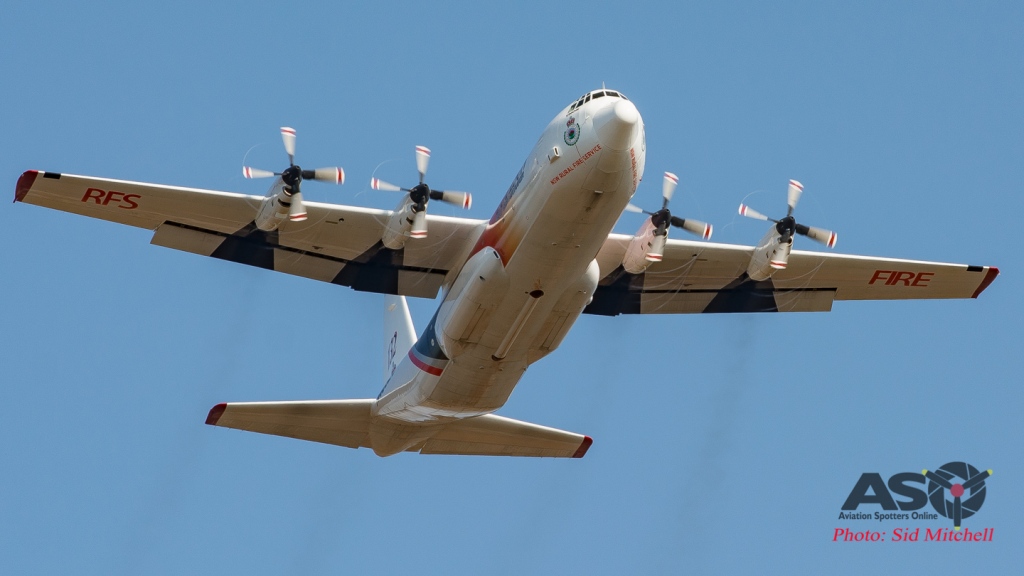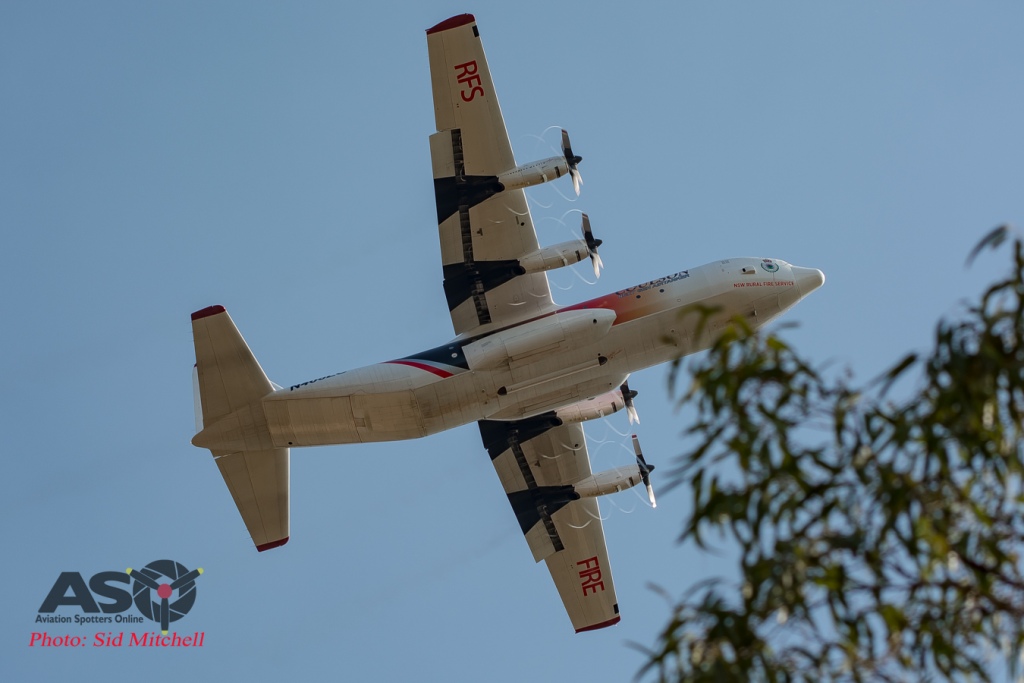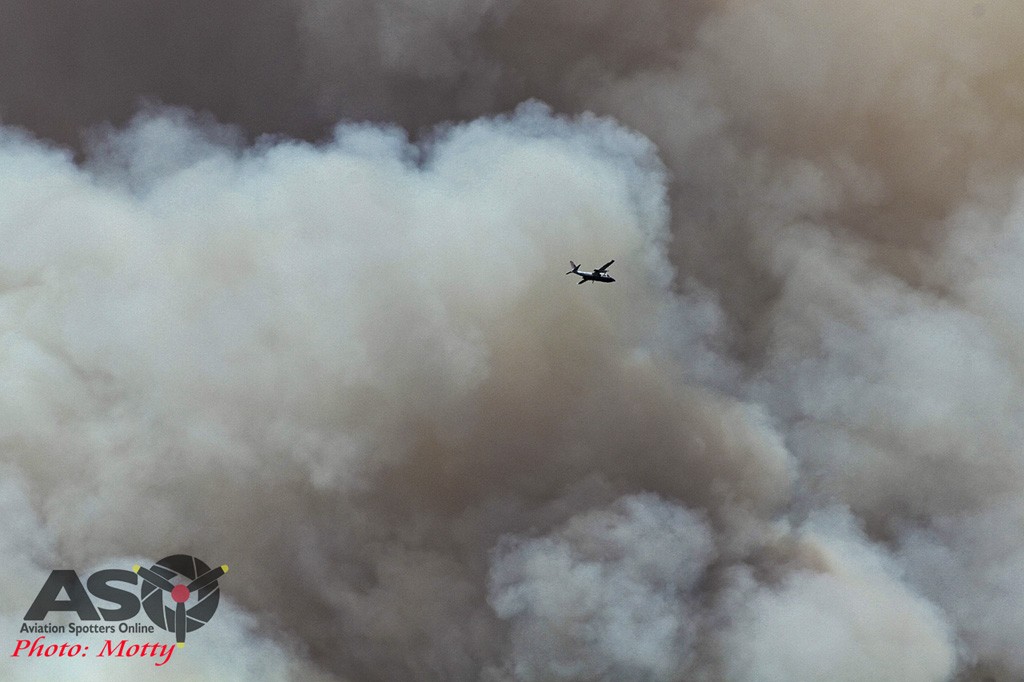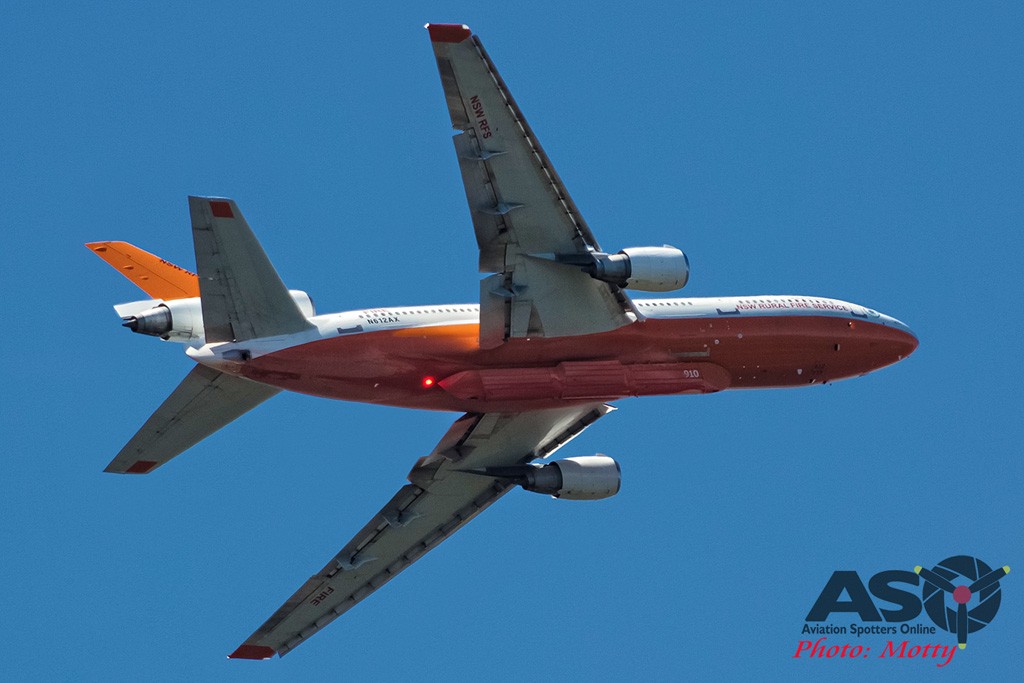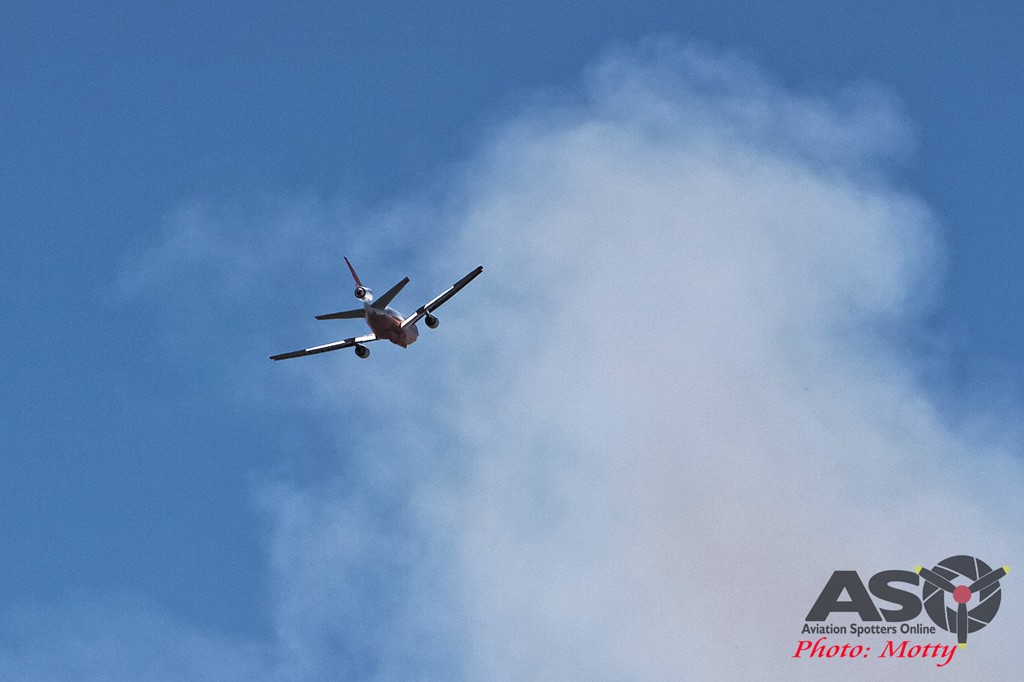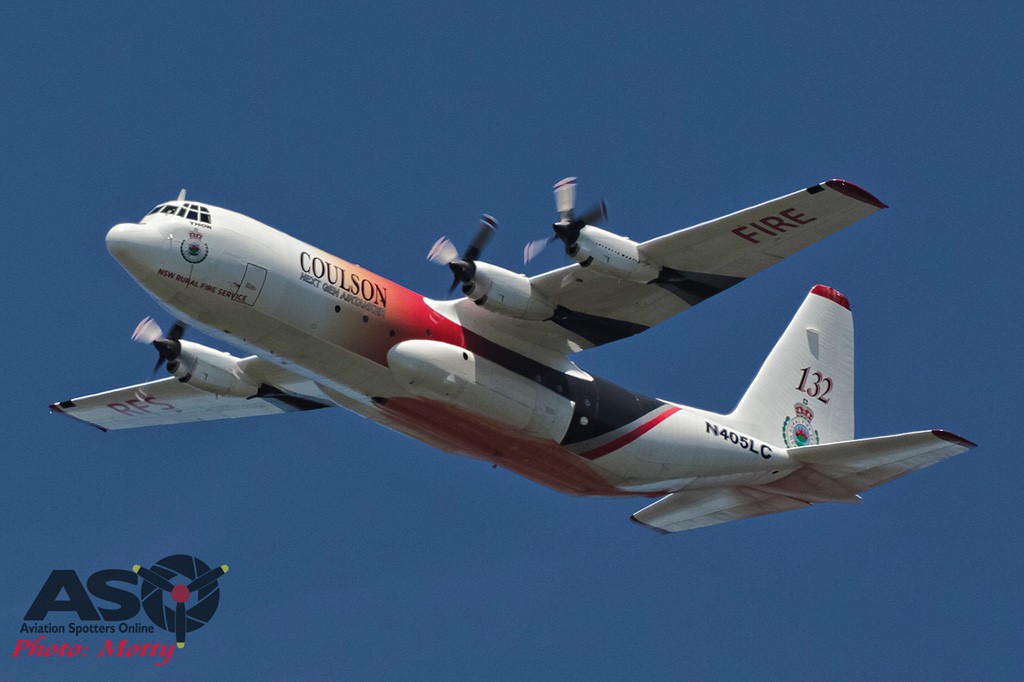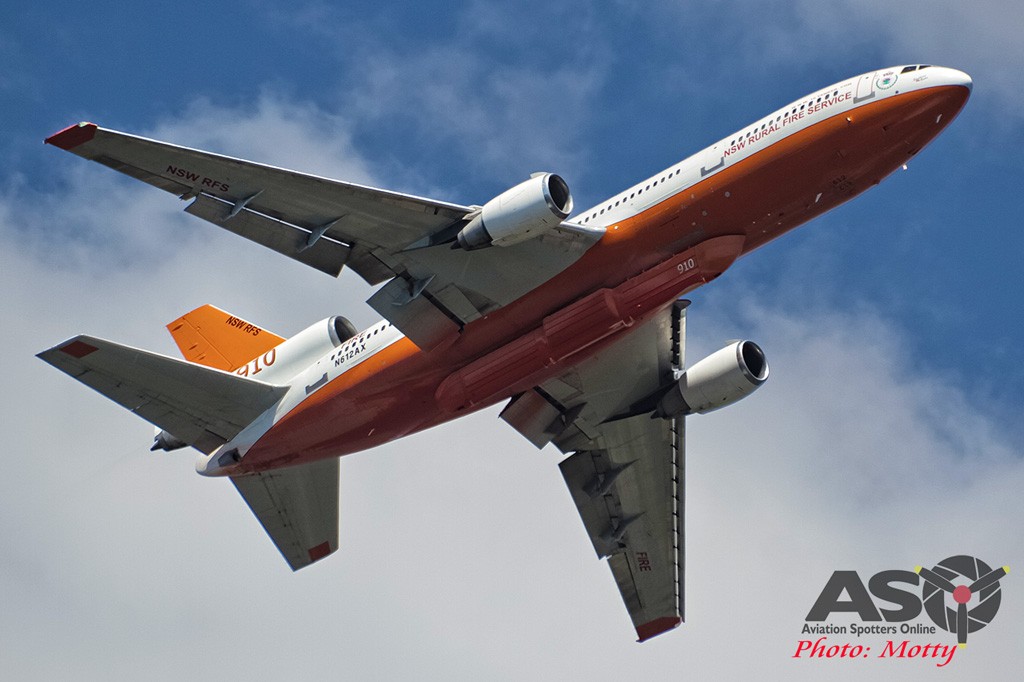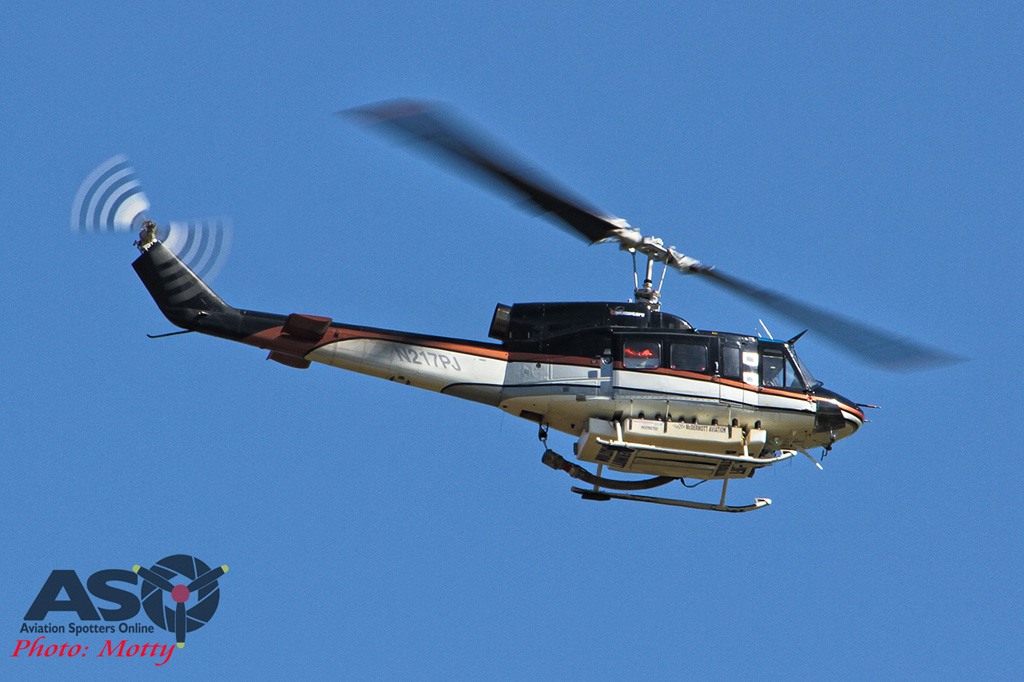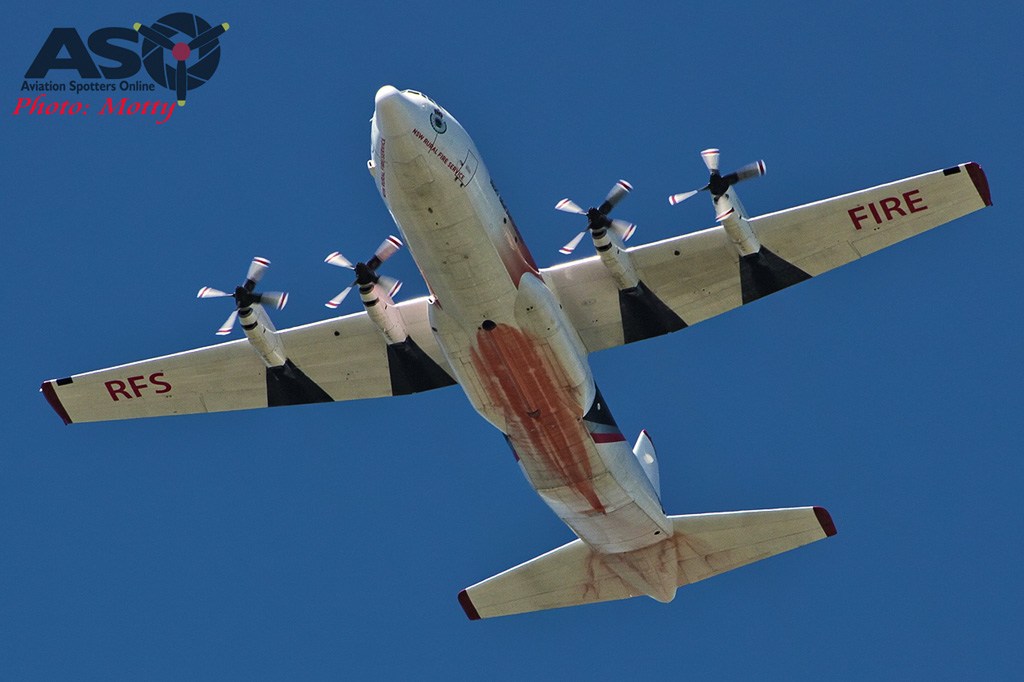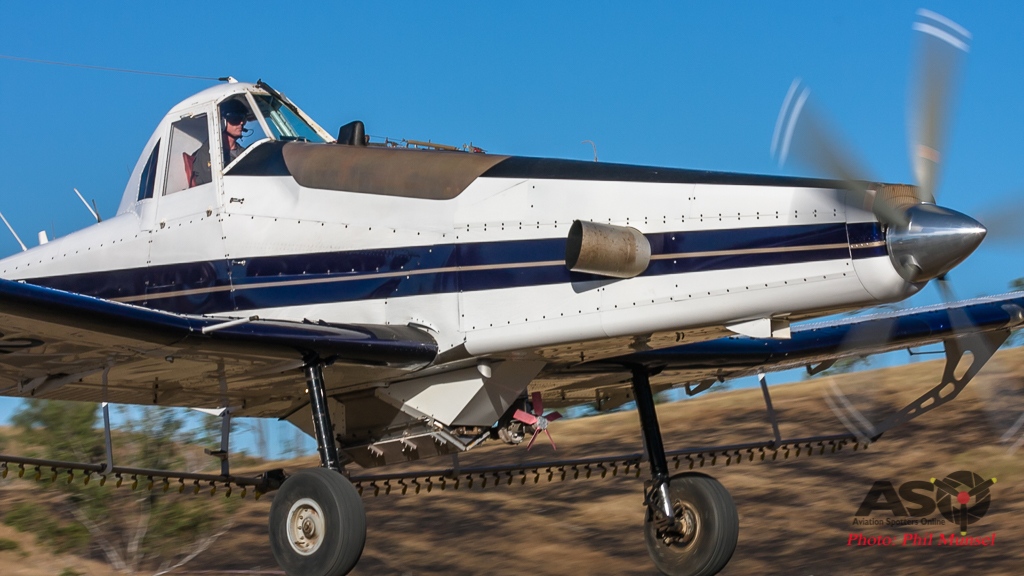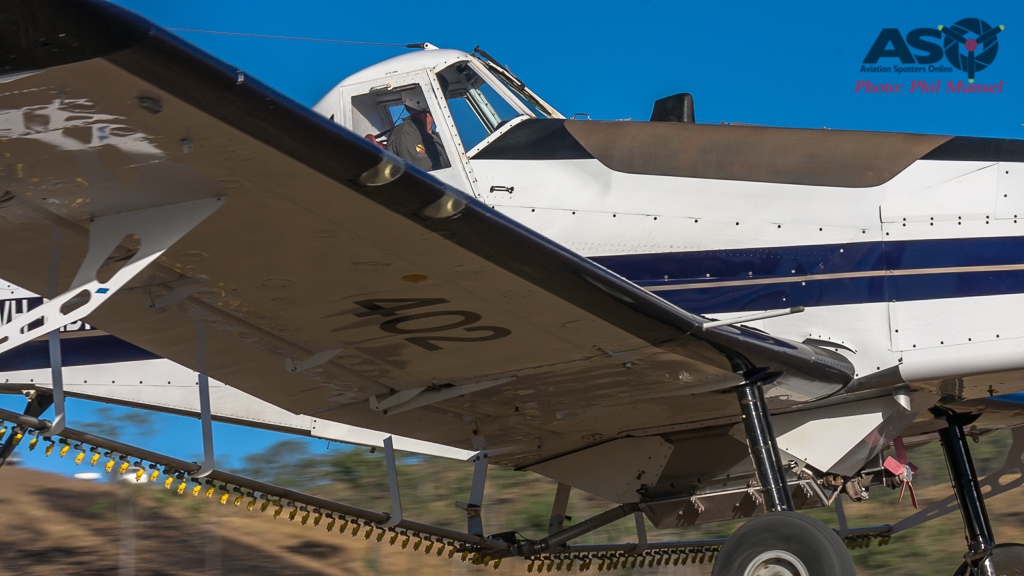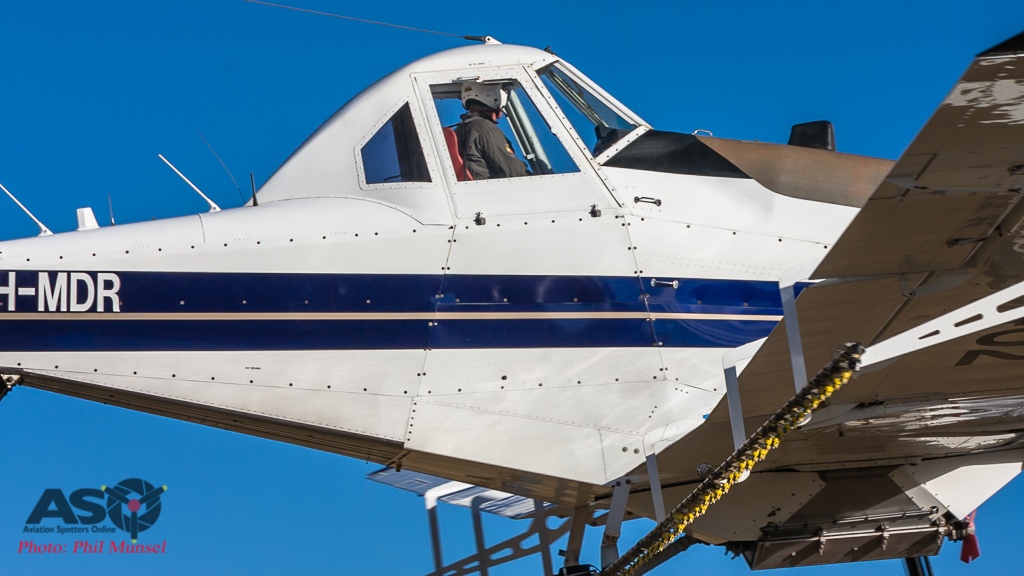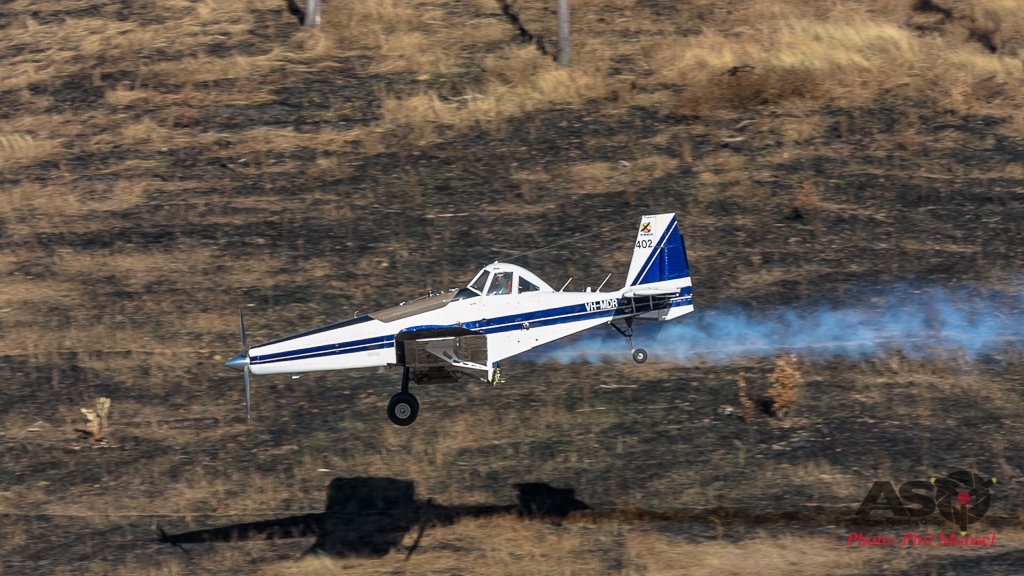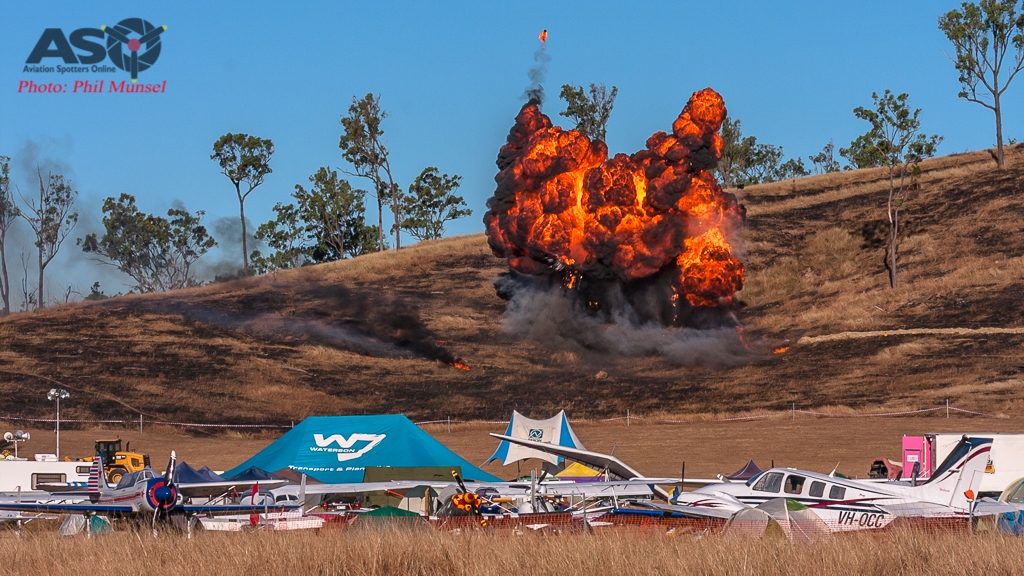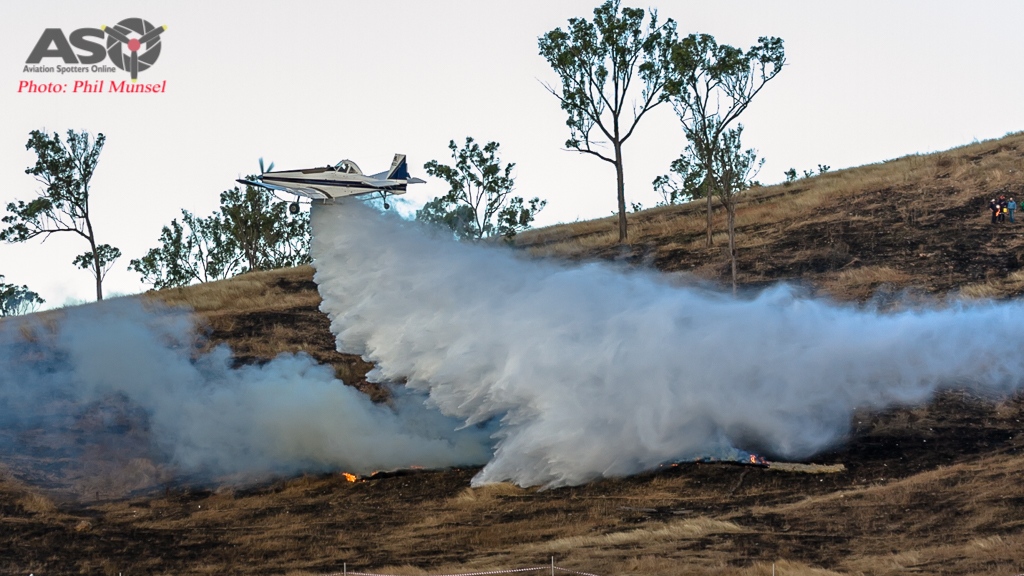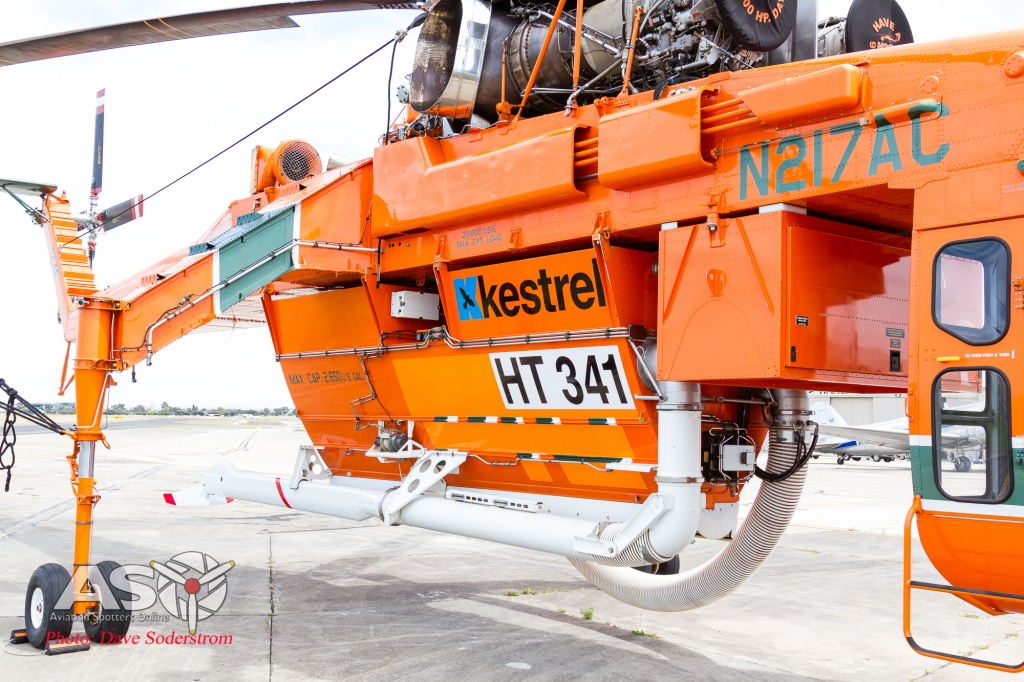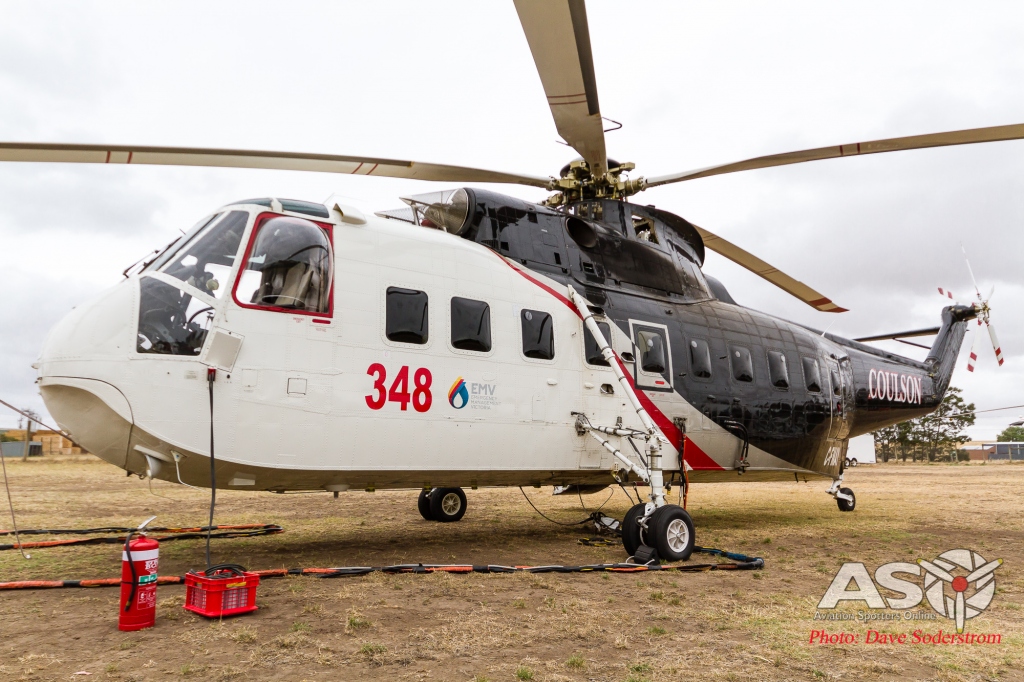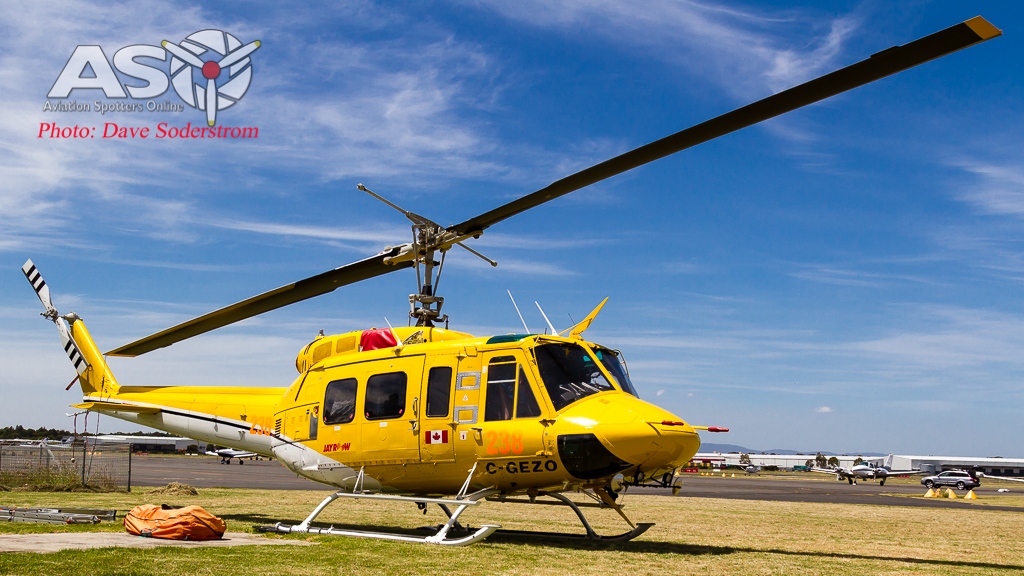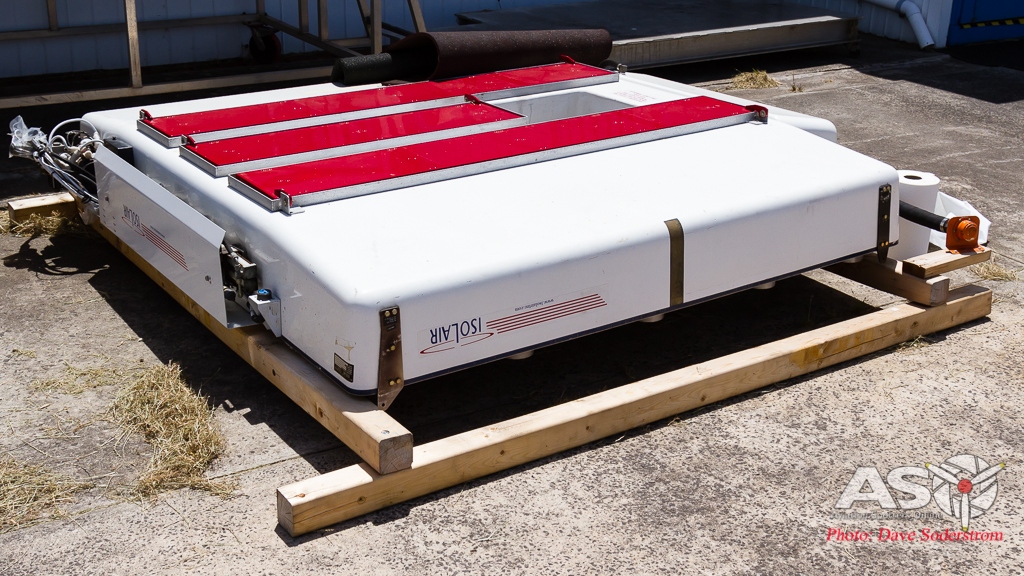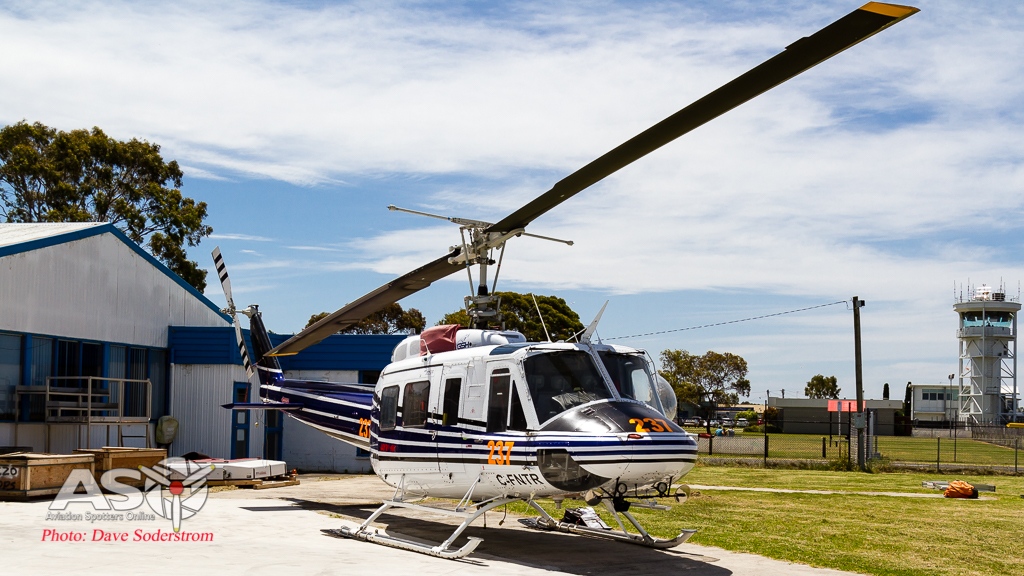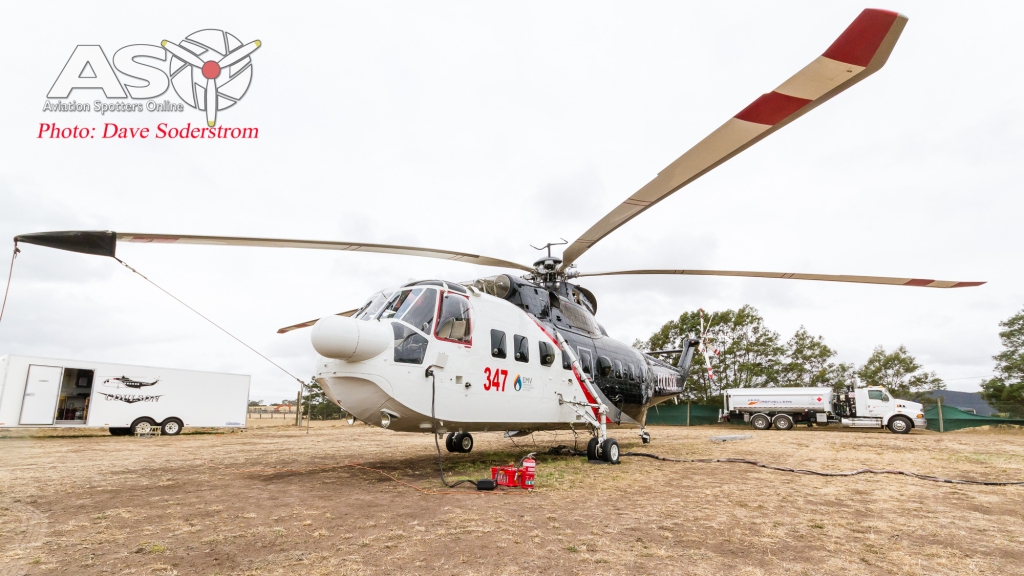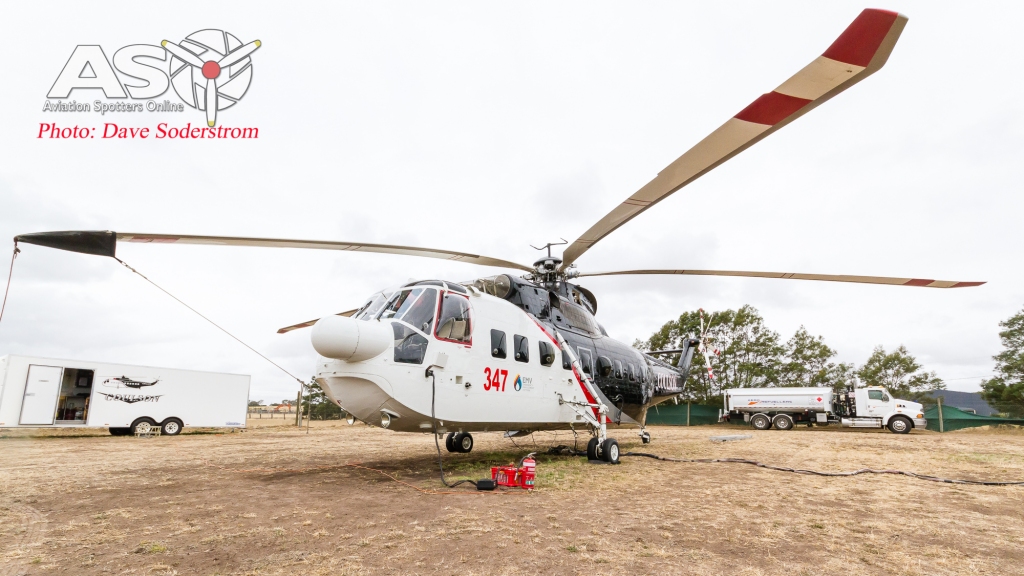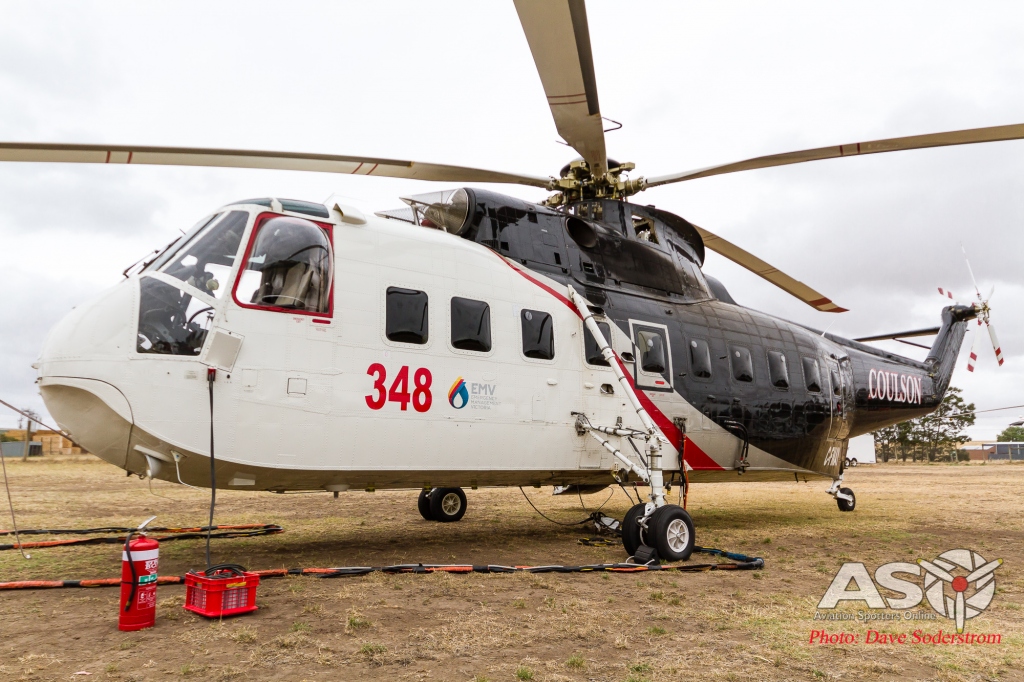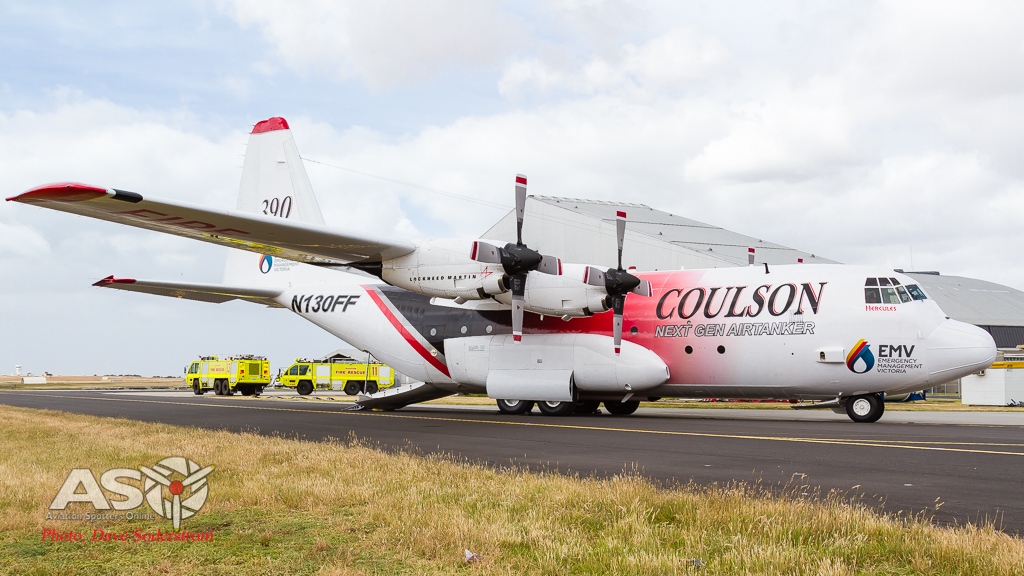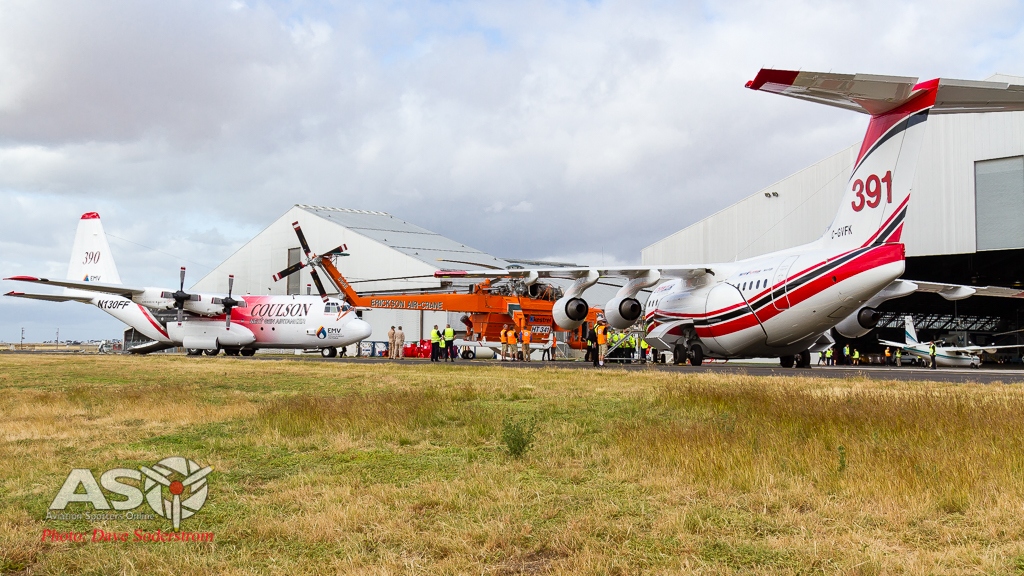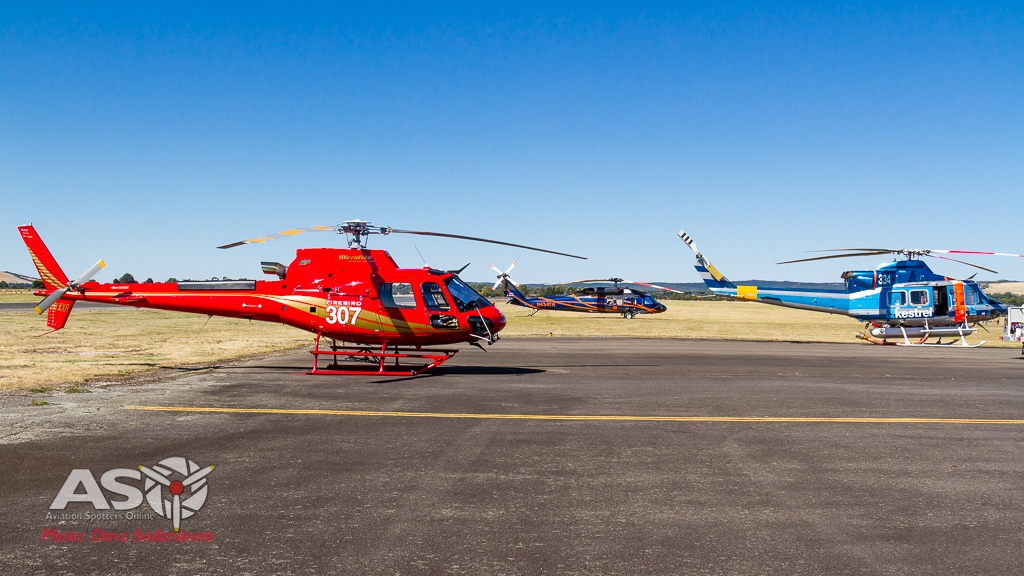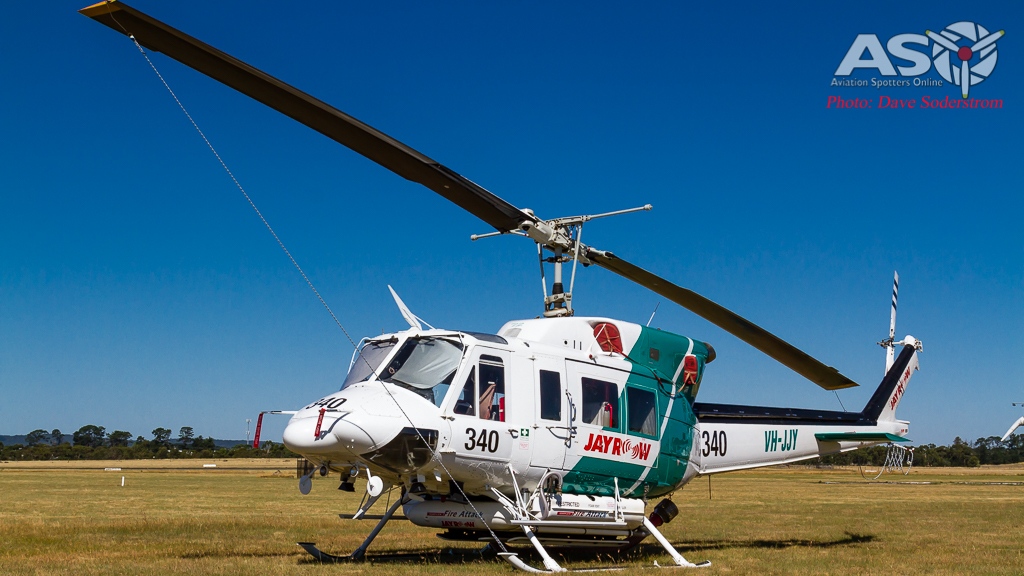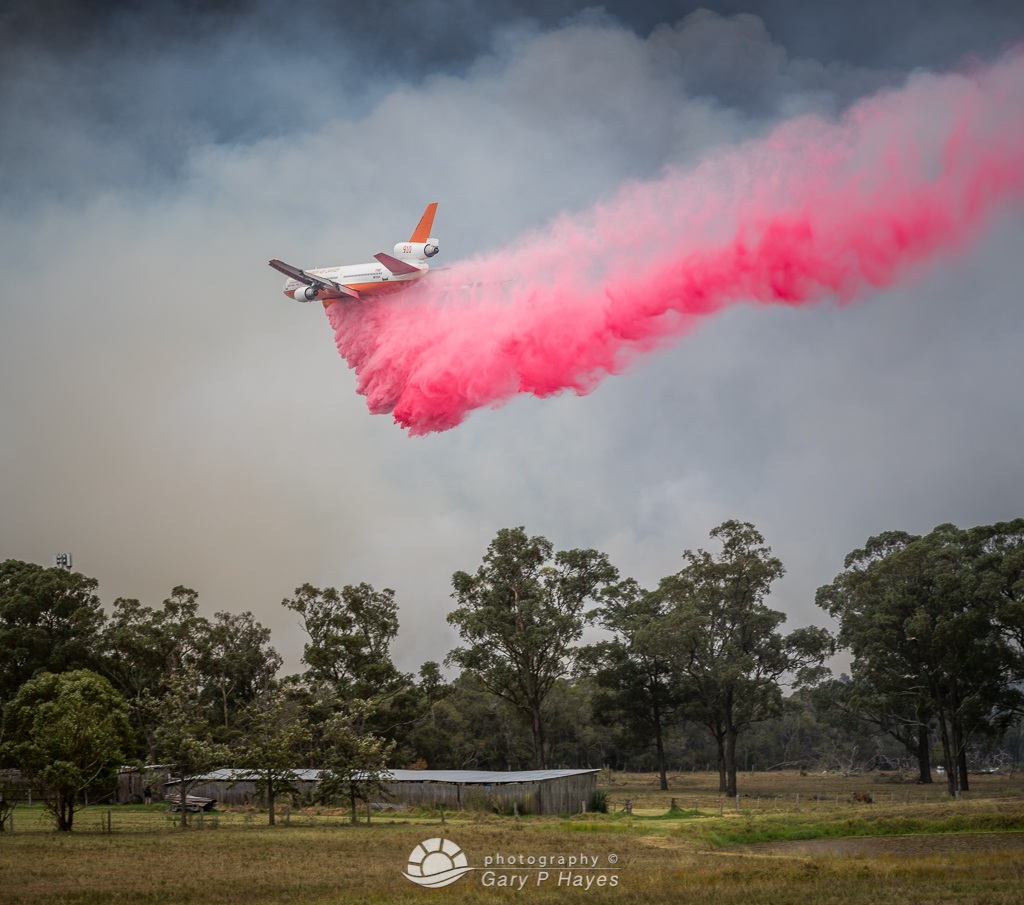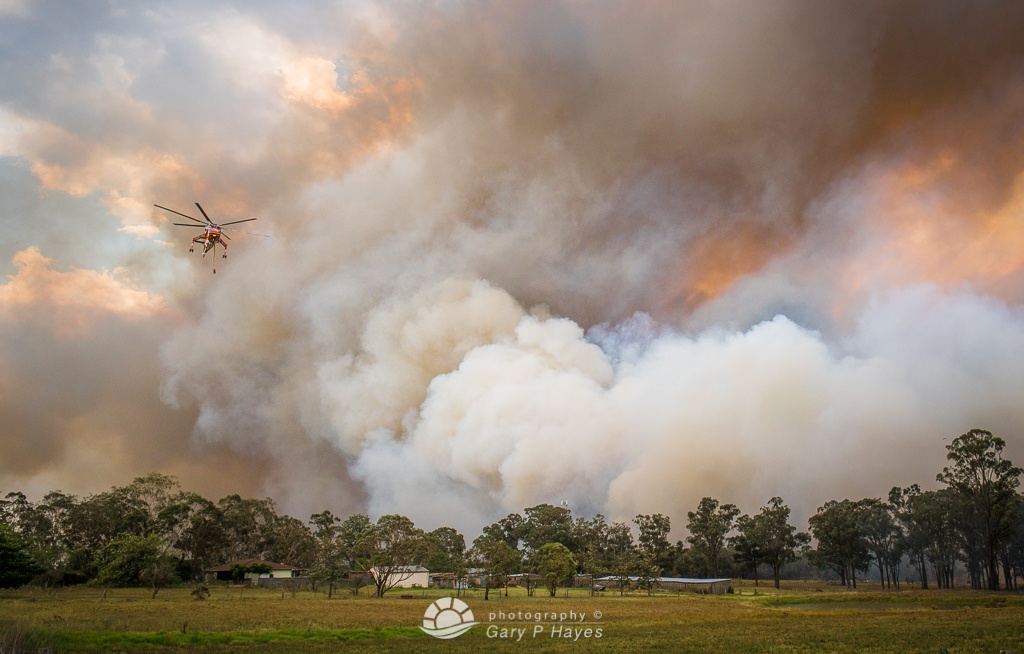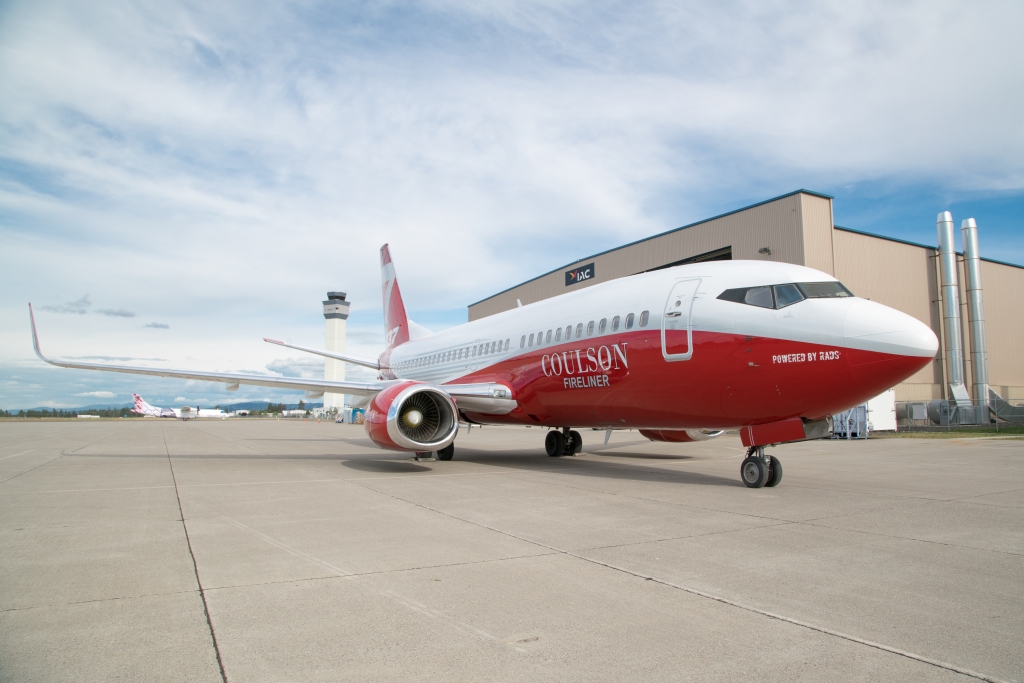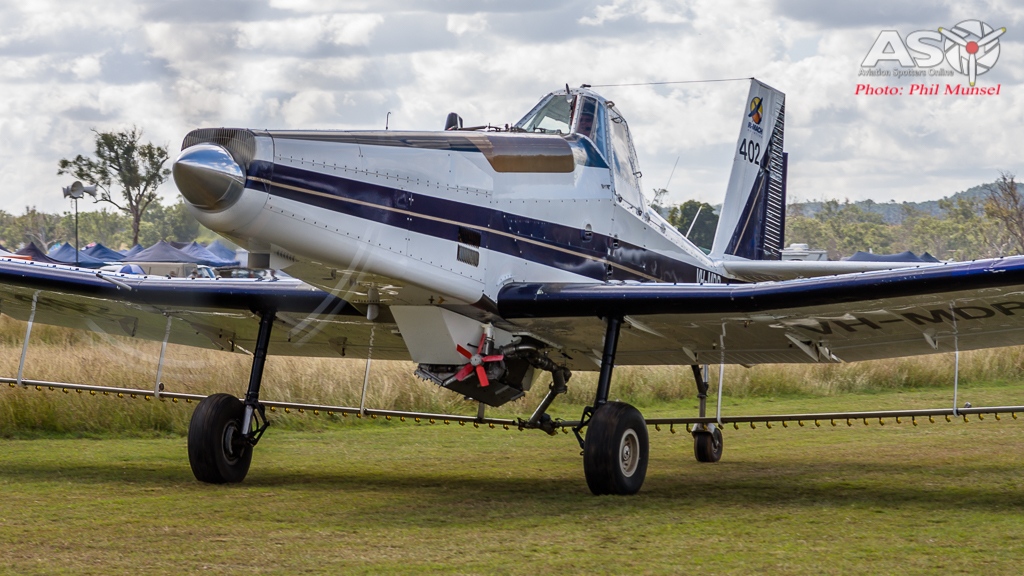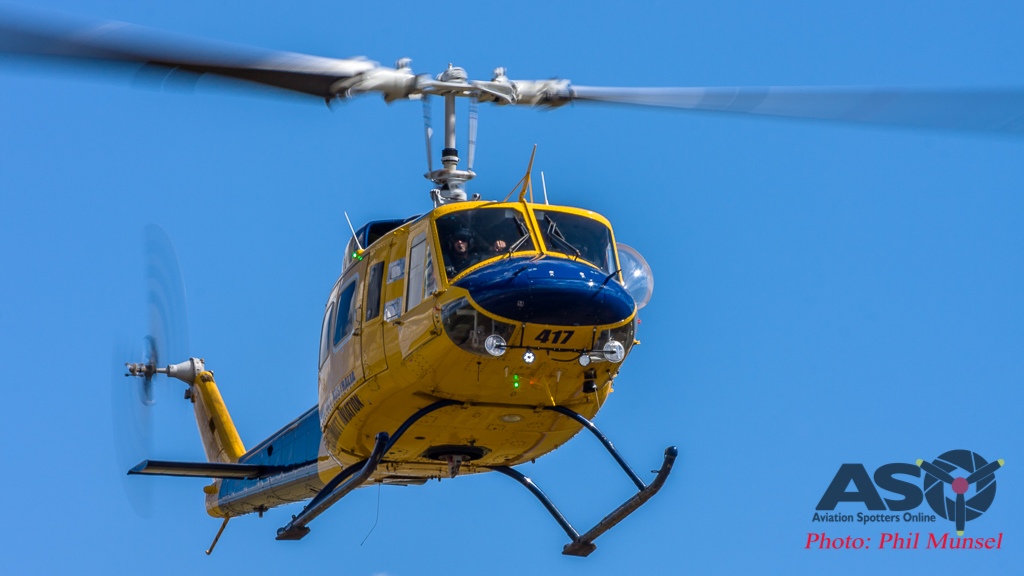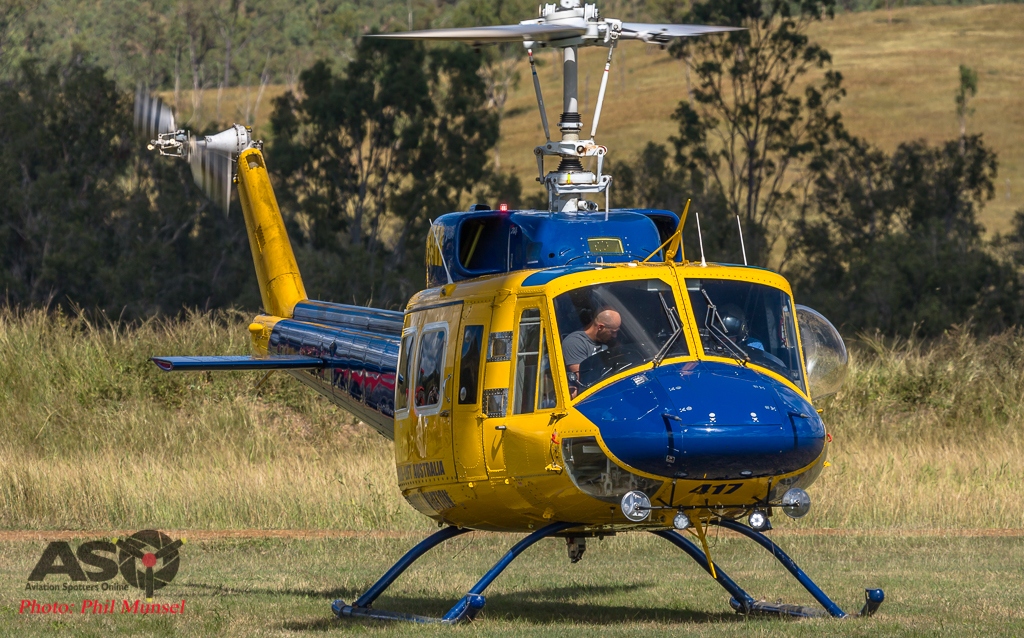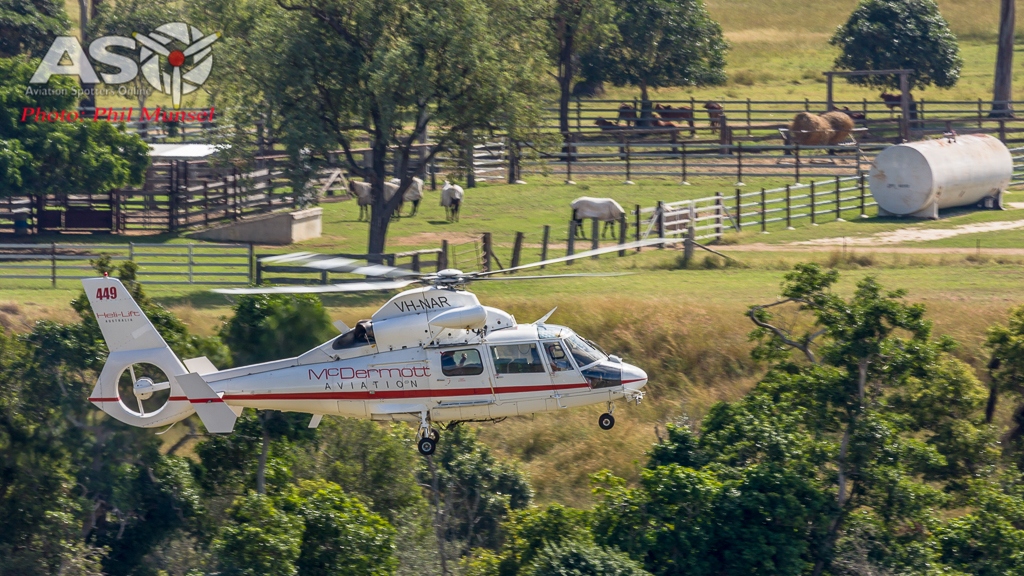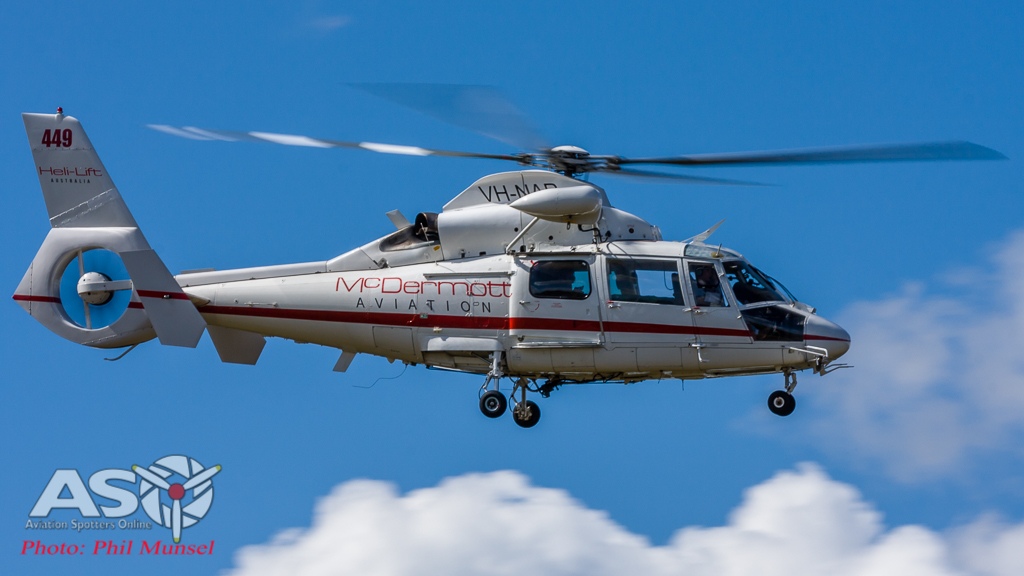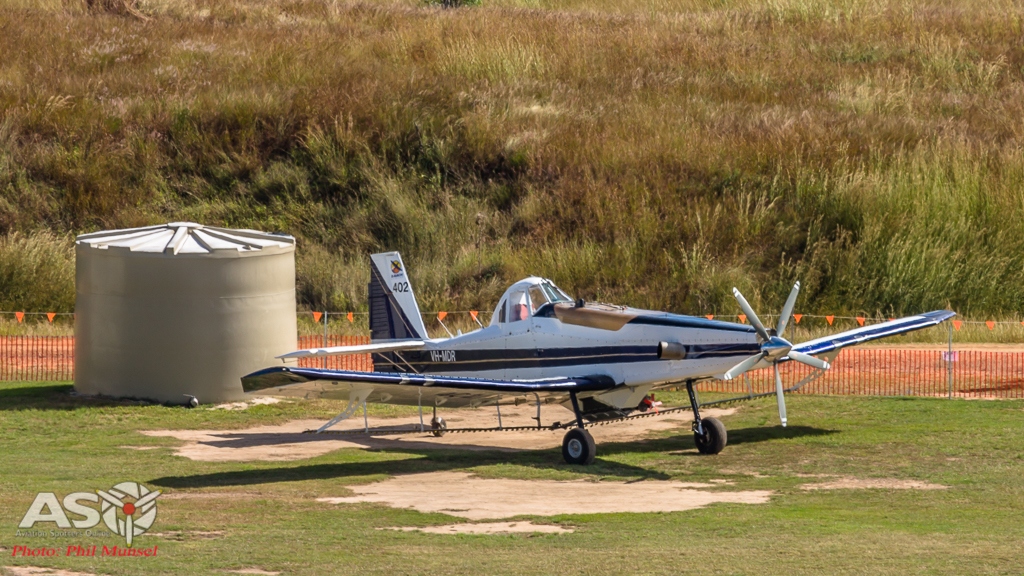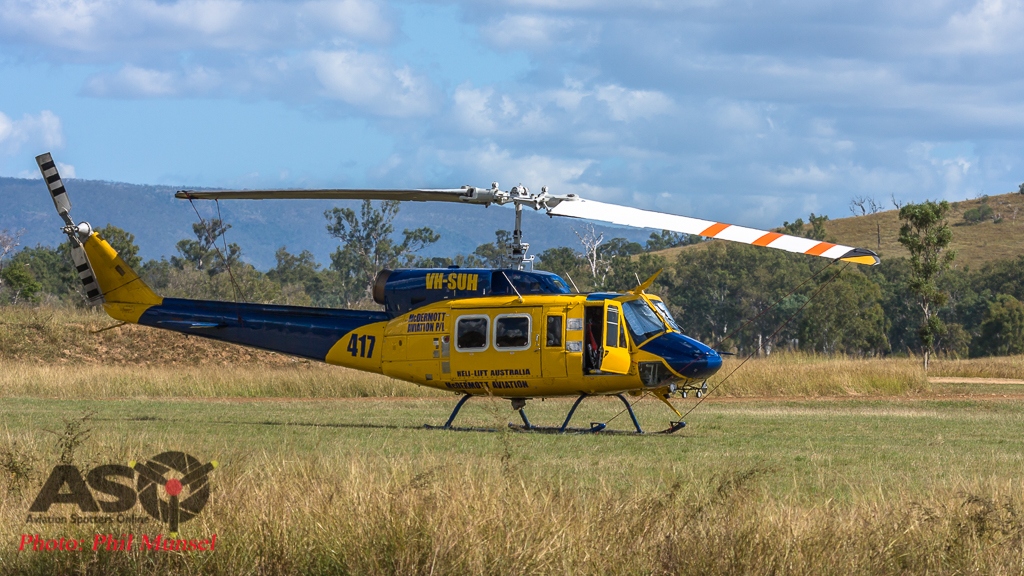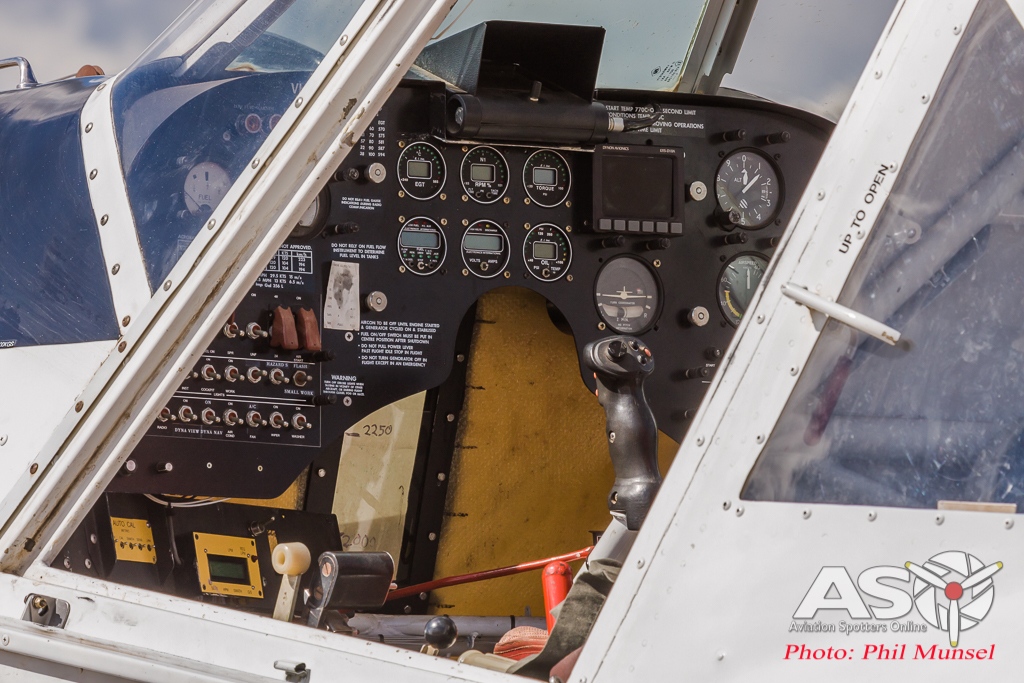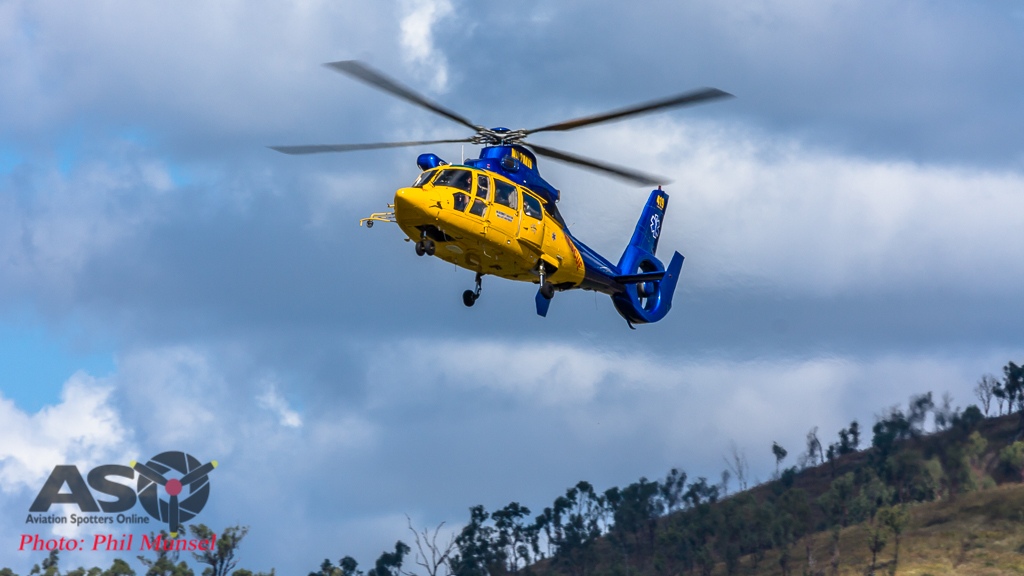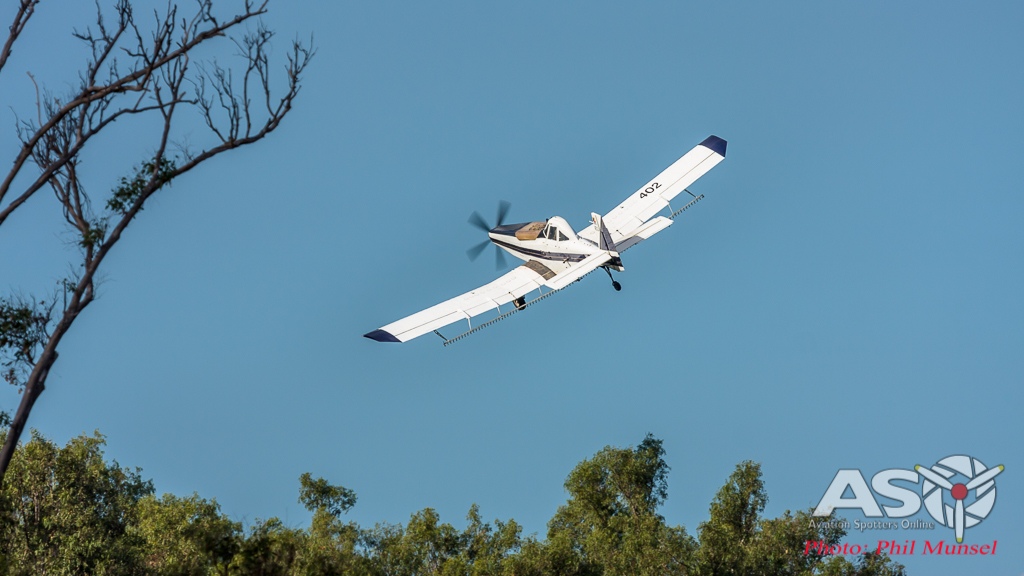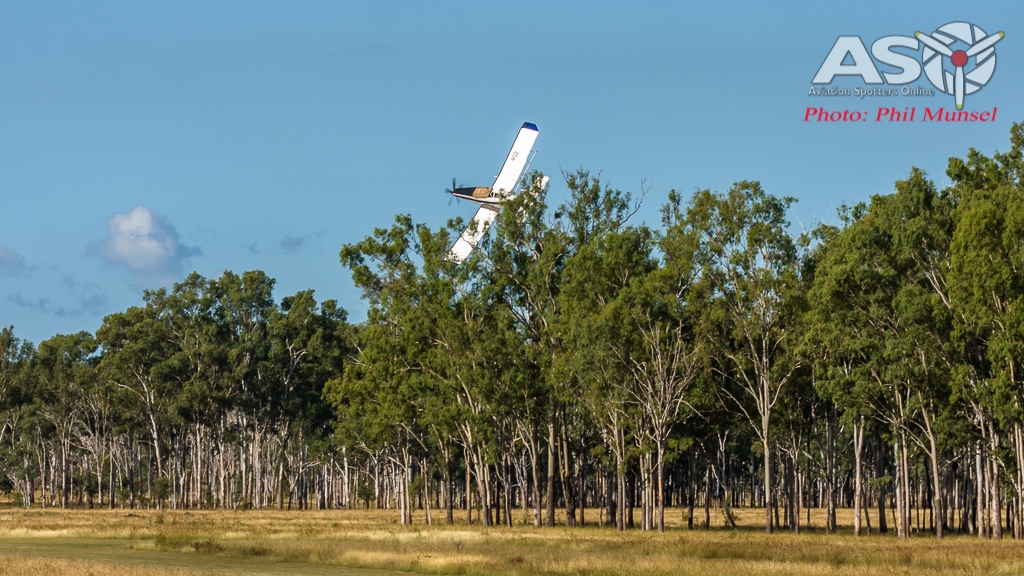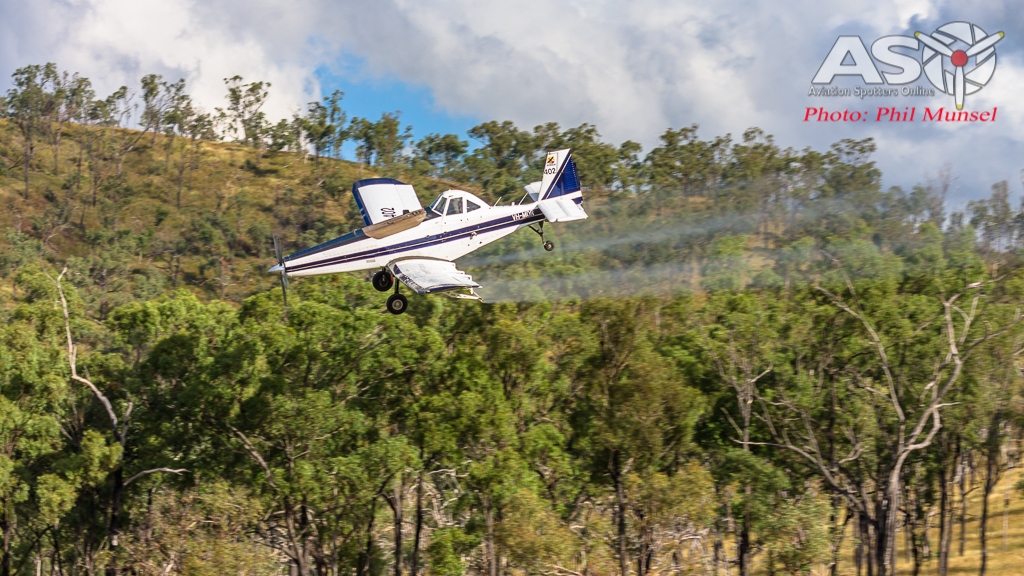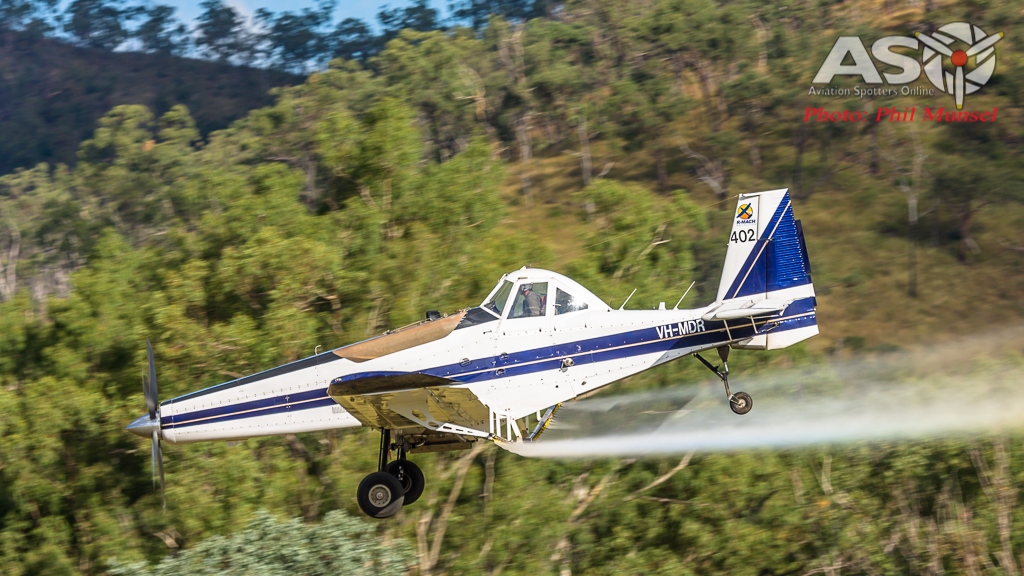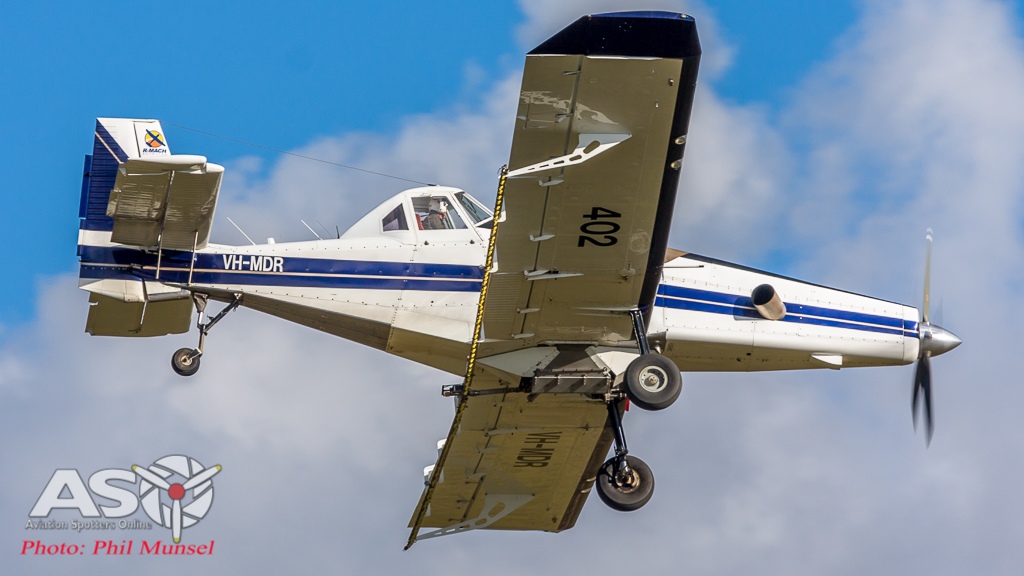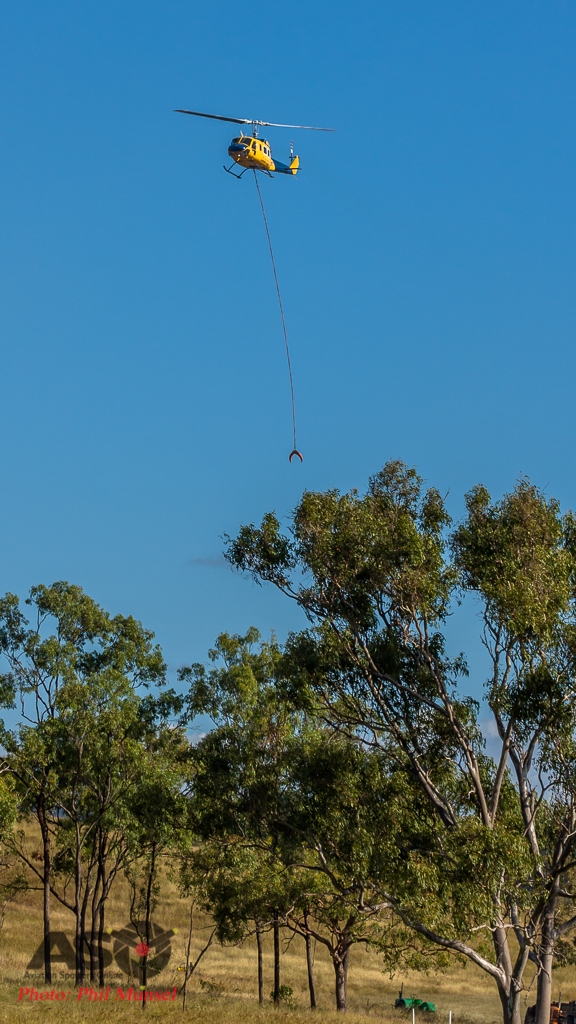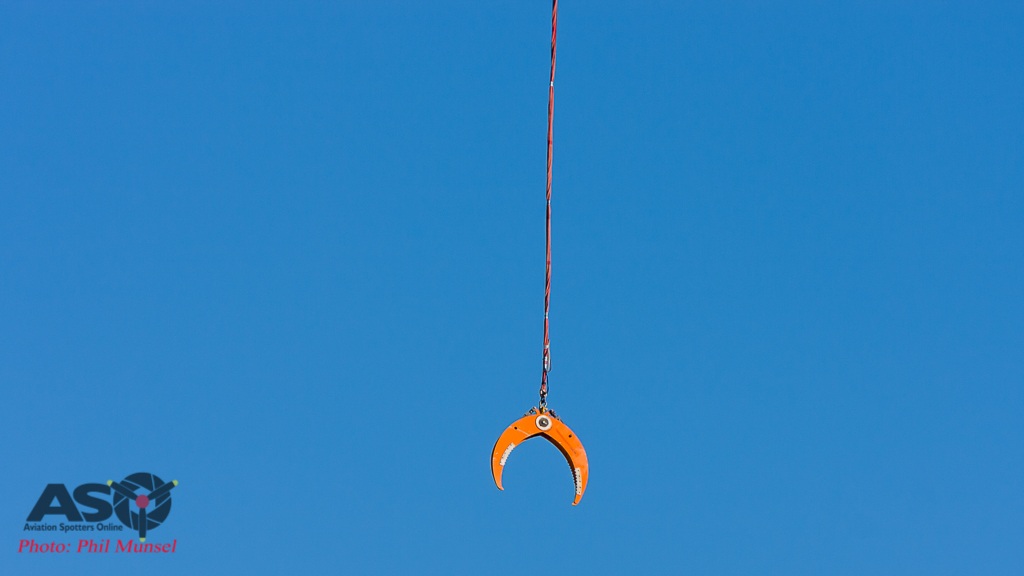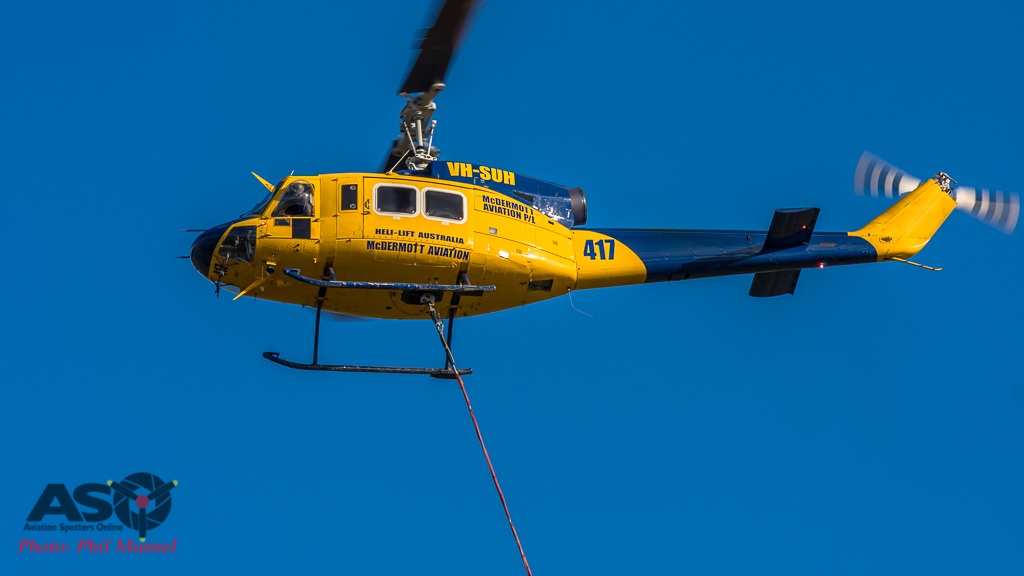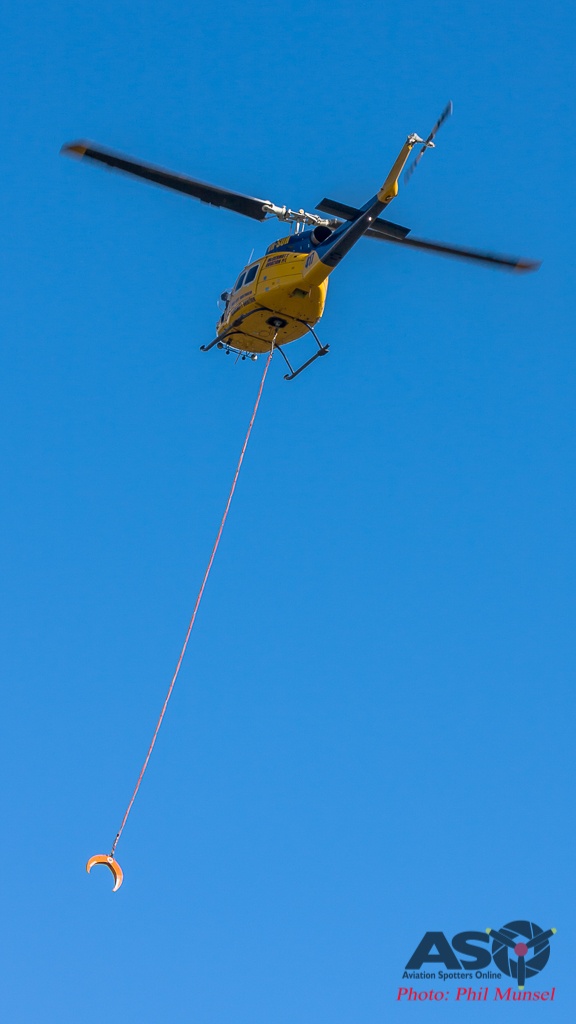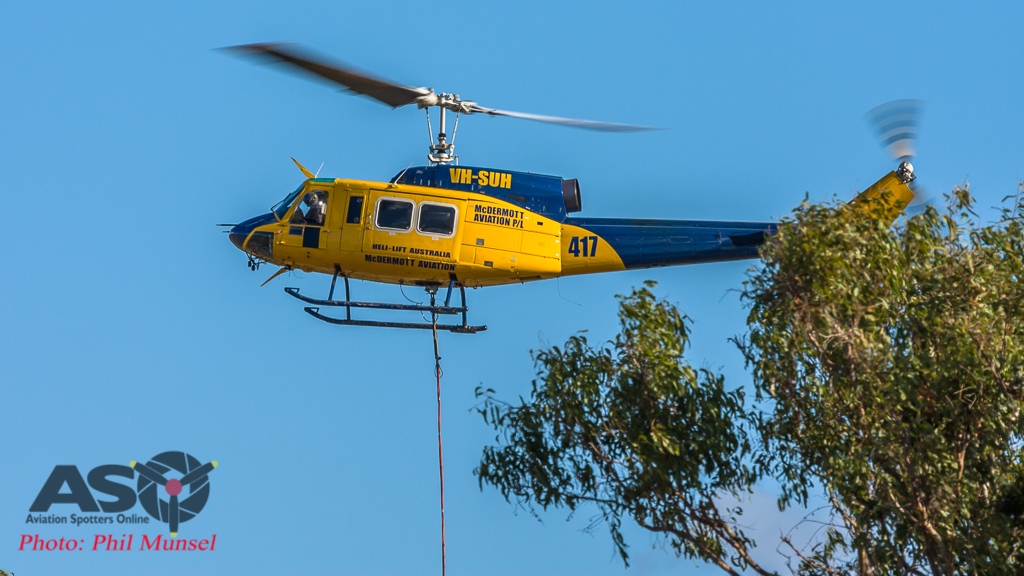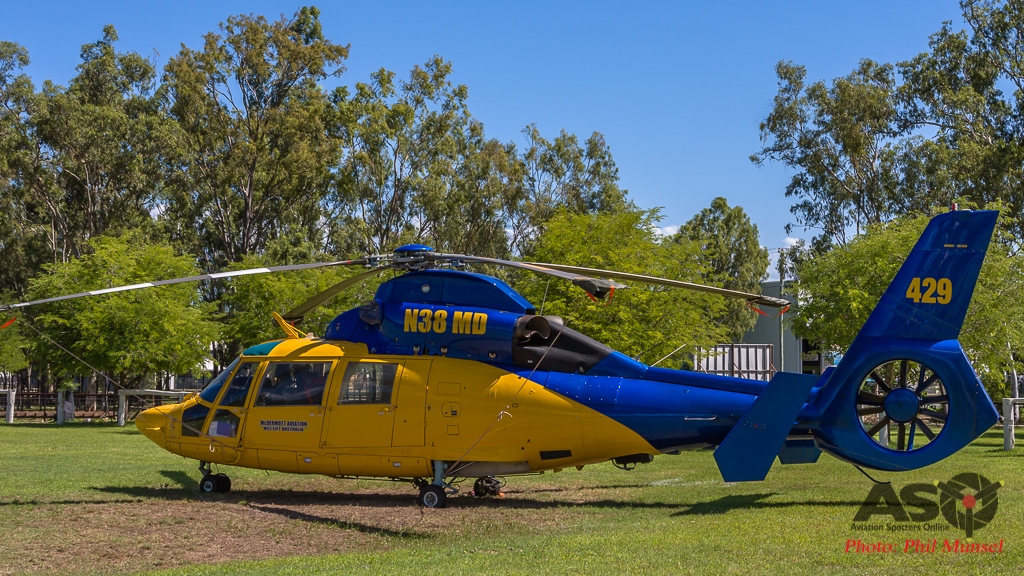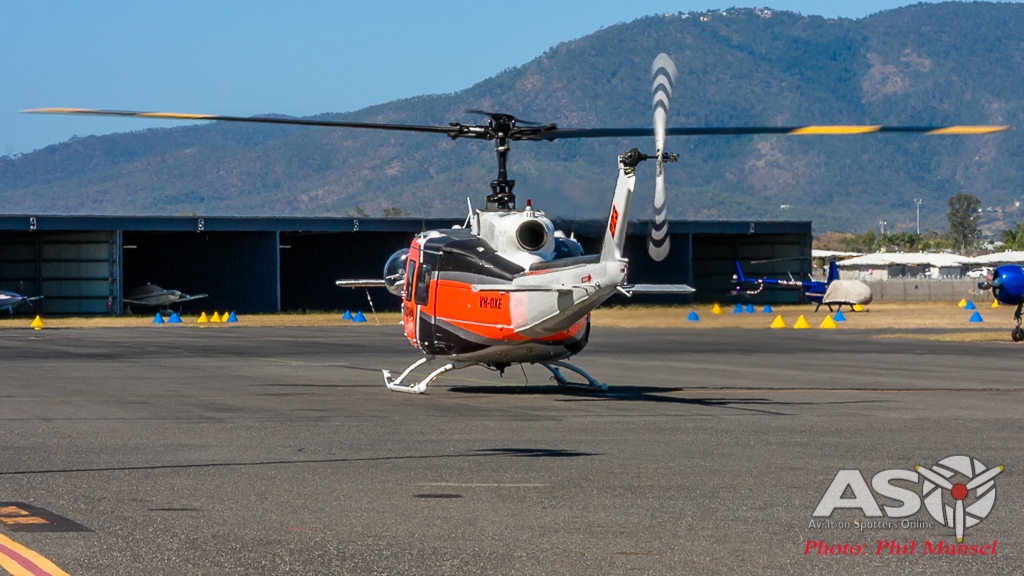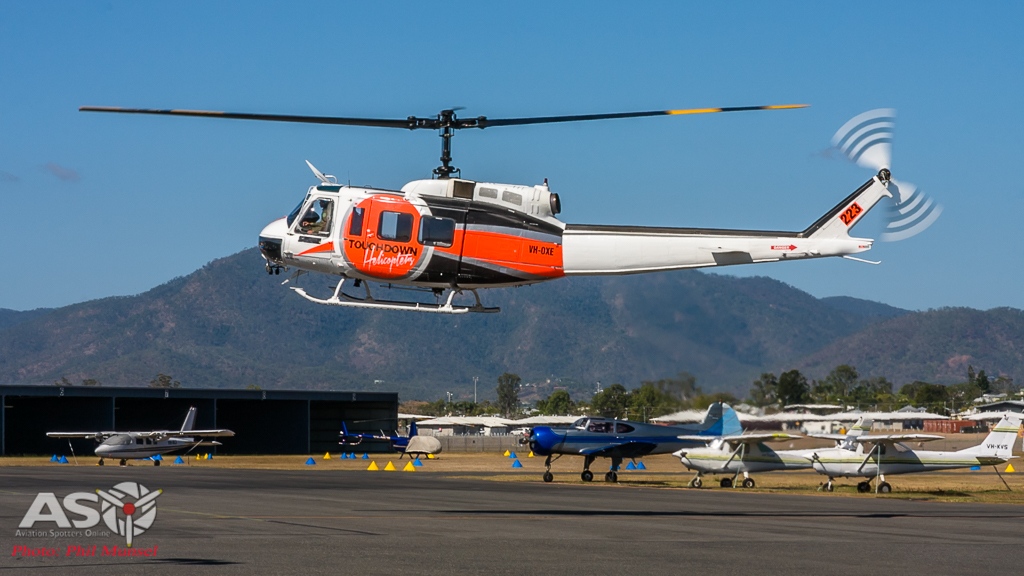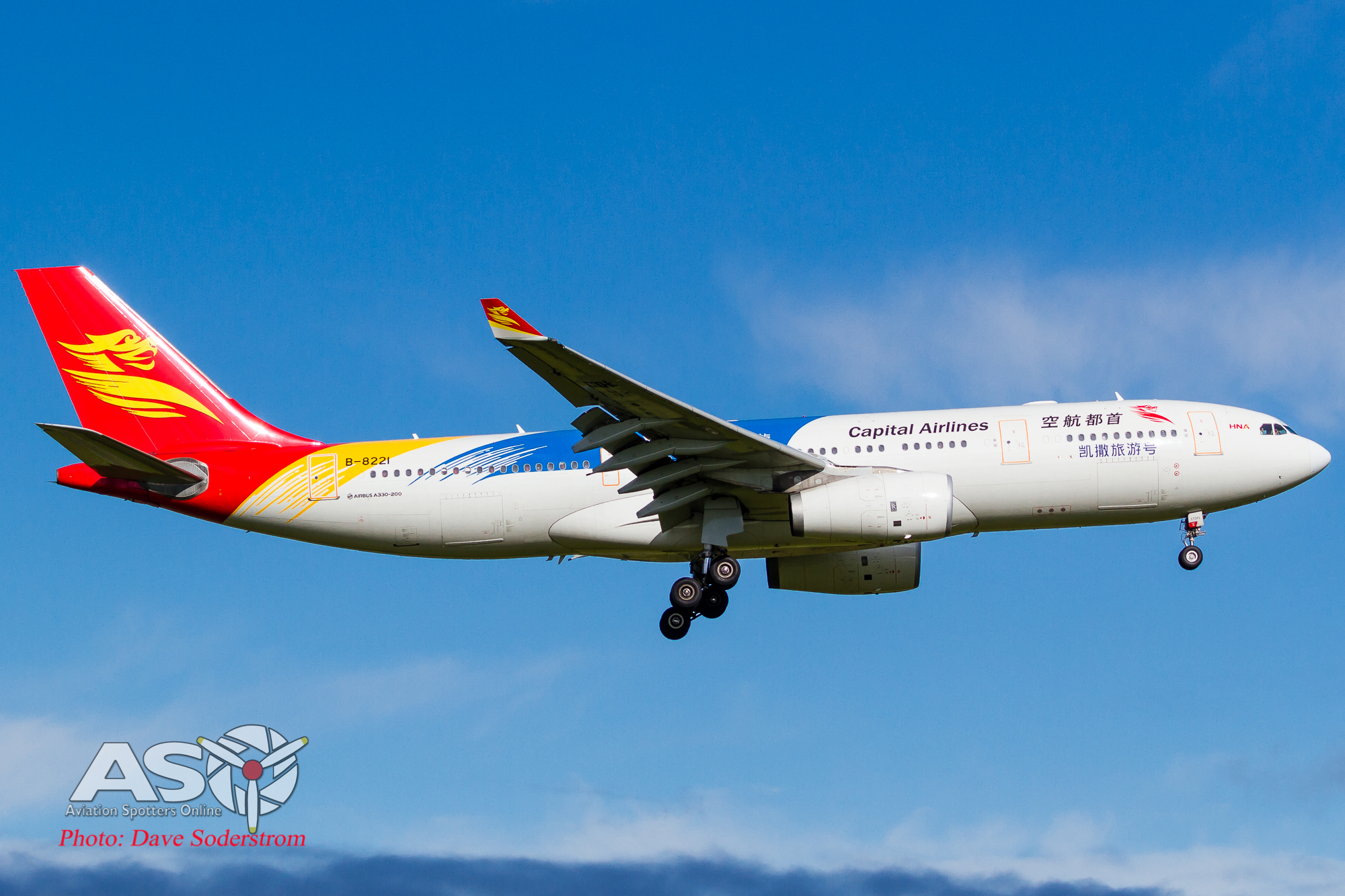They are a permanent fixture around Australia now, with fixed wing and rotary wing aircraft being stood up across the country to protect our assets. The practice of aerial fire management isn’t exactly new, Royal Australian Air Force Westland Wapiti biplanes were used by the Victorian Forest Commission in the late 1920’s.
Of course fire fighting with these large scale aircraft isn’t feasible nor suitable in some areas, which is why many other different types are tasked to a variety of roles. A mixed fleet of rotary and fixed wing aircraft operate with ‘buckets’ to accomplish their fire fighting roles. This season again new types have been trialed and used by various agencies to improve the delivery of fire suppression. The roles of the aerial fleet have expanded and continues as newer, more efficient and safer ways are developed. The ways in which information is gathered on fire and emergency activities, enable improved management of them, which minimizes the risk to crews on the ground and air and of course to lower asset losses is constantly being tweaked.
The Kains Flat Fire in western NSW started in the worst conditions seen in many years.The RJ-85 is returning for another drop while two helicopters try to keep up with the spotter helicopter to the right. This photo was taken only 4 hours after the fire started.
This season roles included; firebombing, air attack supervision, incident observation, (air observing) incident mapping, winching & rappelling, transport, aerial ignition, aerial drip torch and sling loads. A new role this season saw a new trial in Victoria starting February where Coulson Aviation brought their knowledge and experience of night fire suppression operations to trial and evaluate them out of Ballarat Airport. The ‘safe system of work’ is designed to gain an endorsement of these operations as part of standard operations in the future.
The two helicopters used in the trial, S-61 (Helitak 347) will be used to carry out firebombing operations in tandem with the S76 (Firebird 322) which will be used for reconnaissance. The S-67 was debuted at Avalon Airshow where its crew were on hand to explain the system and trial. This isn’t the first time the S-76 has been in Victoria however, with the type operating along side the DC-10 as part of the evaluation trial in 2010. The Night Fire Suppression Operations (NFSO) – Aviation Trial is done in partnership with Forest Fire Management Victoria, CFA, National Aerial Firefighting Centre (NAFC) the Civil Aviation Safety Authority (CASA) and Coulson Aviation.
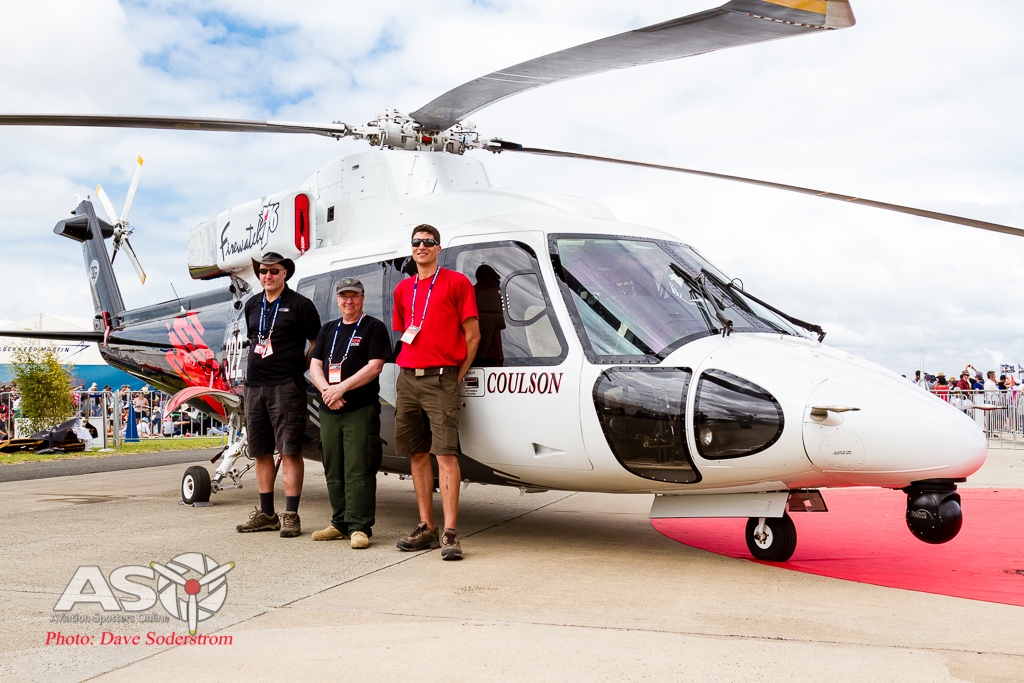
Coulson’s S-76 crew stand proudly beside their aircraft at this years Avalon Airshow.
Craig Lapsley from Emergency Management Victoria (EMV) stated, ‘Victoria has been operating night vision goggles and night vision infrared systems since 2010 to conduct night aerial incendiary operations, surveillance and data collection. The night-time aerial firebombing trial is an extension of this and will build upon knowledge of night vision technology in fire operations and test its capability for future use in Victoria’.
Each state and territory has its own unique challenges with regard to terrain, distances and organizational structures. Hence why each state issues its own contracts to suit the local requirements. All the aircraft on the contract though are managed as part of a larger network by the National Aerial Firefighting Centre. NAFC is designed to coordinate the nation’s fleet and to assist with deployment via a resource sharing arrangement as needed, if needed, in other states, as it did again this season. Aircraft in NSW were tasked to Victoria and Victorian to NSW and Aircraft in Victoria were tasked to South Australia.
RJ-85 overflies the Kains Flat fire looking at the line it will take. Below is a major Power Substation, which was saved from the fire.
Aviation Spotters Online has again been spending a lot of time with the various aircrews around Australia this fire season. As part of the NAFC organization fire bases around the country were as follows:
Australian Capital Territory
- Hume Helibase
New South Wales
- Bankstown
- Camden
- Richmond
- Norwa
- Scone
- Grafton
- Forbes
- Goulburn
- Orange
- Taree
- Tumut
- Armidale
- Moruya
- Wagga Wagga
- Gunnedah
- Hume Helibase
Queensland
- Archerfield
- Meandarra
- Cooroy
South Australia
- Claremont
- Port Lincoln
- Naracoorte
- Mt Gambier
- Millicent
- Brukunga
Tasmania
- Launceston
- Hobart/Cambridge
Victoria
- Stawell
- Moorabbin
- Mansfield
- Avalon Airport
- Ovens
- Bairnsdale
- Latrobe Valley
- Ballarat
- Casterton
- Bendigo
- Managalore
- Colac
- Essendon
- Albury
- Benambra
- Benalla
- Olinda
- Heyfield
- Shepparton
- Horsham
- North West
- Healsville
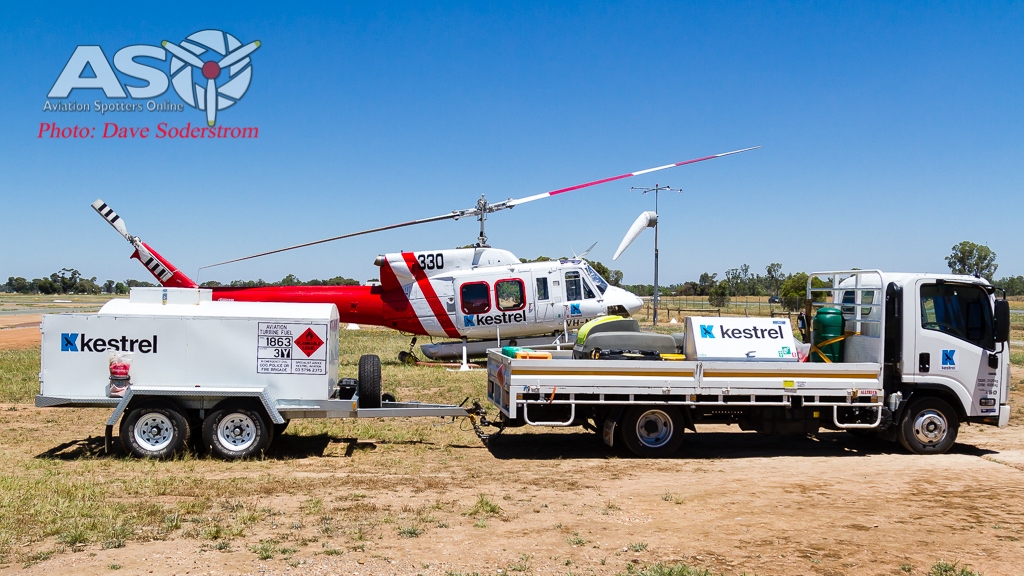
Kestrel Aviation’s Helitak 330 on station at Shepparton in Victoria’s North East this season is seen with ground support equipment.
Western Australia
- Jandacot Airport
- Albany
- Busselton
- Bunbury
- Serpentine
- Manjimup
- Esperance
Northern Territory
- Batchelor

Aircare Aviation’s AT-802 VH-WXH is owned by the Moree based company and is seen here in the Northern Territory.
Fixed wing aircraft used for fire bombing will be assigned a type number based on their water carrying capacity and design features, as specified below:
| Type | Engines | Water carrying capacity |
| 1 | Multi engine | Greater than 11,356 litres |
| 2 | Multi engine | Between 11,356 and 6,813 litres inclusive |
| 3 | Multi engine | Less than 6,813 litres |
| 4 | Single engine | Greater than 2,270 litres |
| 5 | Single engine | Less than or equal to 2,270 litres |
Large fixed wing fleet
As we reported in our previous round up of the 2015-2016 season here: http://aviationspottersonline.com/fire-fighting-assets-in-australia-20152016-season/ the growth and continued maturity in the types, roles and their uses continues to expand. This season we saw many aircraft locally operated again assisted with types and airframes from overseas operators. Again the Very Large Air Tanker (VLAT) from 10Tanker Air Carrier operating the DC-10 returning to be based at RAAF Richmond, New South Wales, alongside a Larger Air Tanker (LAT) Coulson Aviation operated L-100-30 Hercules is the primary large scale air attack aircraft based in New South Wales. In Victoria the Government tasked the Conair/Field Air operated RJ-85 and a Coulson Aviation C-130Q to head their local LAT operations.
This season Victoria and New South Wales again led the rest of the country with the contracting of VLAT and LAT fire bombers. The VLAT DC-10 arrived into R.A.A.F Richmond to start its contract to operate in conjunction with the NSW Rural Fire Service in October 2016.
10 Tanker Air Carrier the operator of the aircraft who operate out of their home base in Albuquerque, New Mexico developed the aircraft into what is now a very capable platform. The company is contracted to supply DC-10s to operate across Arizona, California, Colorado, Idaho, Nevada, Utah, South Dakota, Montana, New Mexico, Oregon, Texas, Washington and Wyoming as well as Alberta, Canada and of course Australia.
The company has three operational DC-10 VLATs with other airframes in storage (a fourth is under conversion) which as demand increases can be converted to tanker configuration. The company flew aircraft Bomber 910 to RAAF Richmond this season, the same airframe as last season arrived on October 30th from its routing from Albuquerque via Santa Maria, Honolulu and Pago Pago.

Bomber 910 makes a drop on the Kurri Kurri Fire, 10 Tanker Air Carrier President and CEO Rick Hatton, said he expects the companies next Tanker 914 to be finished with the modification process in June, including the incorporation of their Next Gen tank controller.
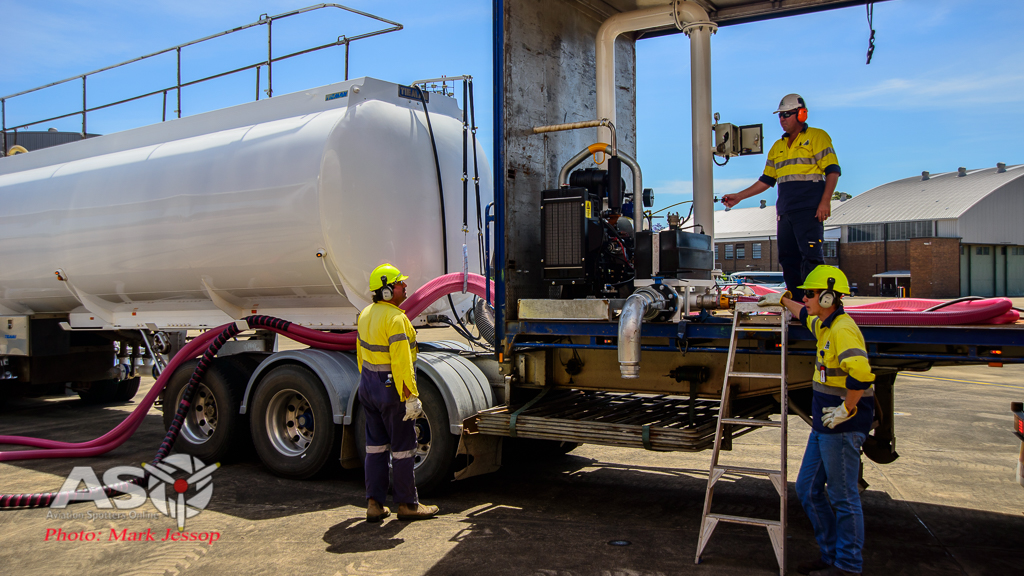
Refilling the tanks on firebombers especially VLATs and LATs requires special and dedicated equipment. The equipment is adaptable to the type of fire attack and the requirements laid out by fire crews on the ground.
Conair in conjunction with Ballarat based company Field Air again contracted a BAe RJ85 to operate as part of Victoria’s LAT aircraft operation. This season is the third in which the two companies have brought this aircraft to work here. The change this season was the aircraft its self. This time Canadian registered C-GVFK. Field Air in conjunction with Conair have the aircraft based at Avalon Airport firebase. This location is chosen at it allows for rapid deployment in Victoria while not clashing with airline traffic operating out of the main airport Tullamarine. As has happened previously the RJ wasn’t used exclusively in Victoria, the aircraft was called into use in New South Wales with the aircraft being positioned at Albury airport in support of the fire attack North of the border.
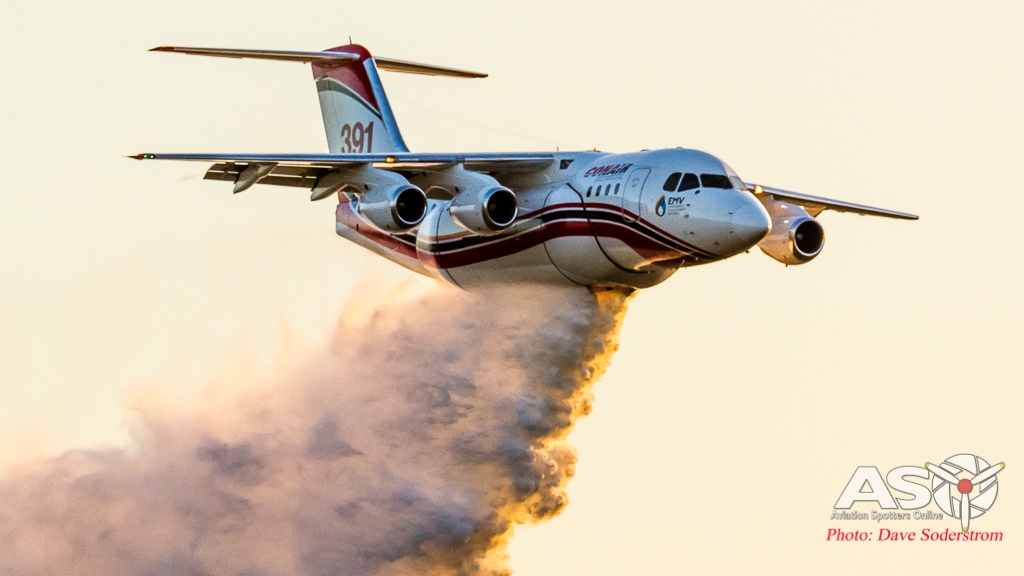
Bomber 391 preforms an evening drop in front of the crowd at the Australian International Air Show at Avalon Airport.
Bomber 391, pulls away after a drop on the Kains Flat fire in the New South Wales west this year. The red stains on the belly is from the Phos Chek retardant .
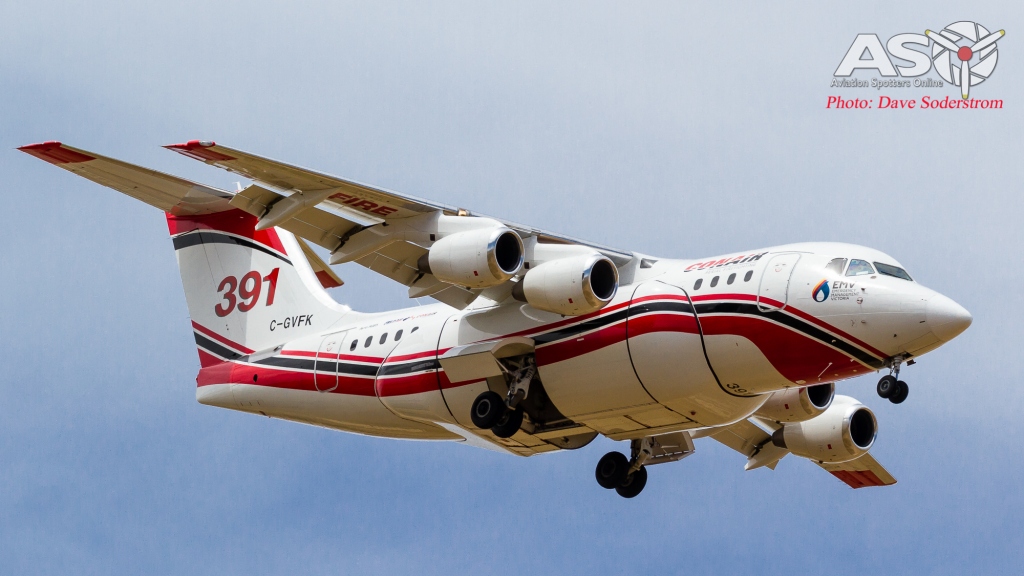
C-GVFK is one of a total of seven Avro RJ85s in service as airtankers, with an eighth aircraft under conversion ready for the 2017 fire season.
RJ85 Overview:
- Type 1 Airtanker
- Primary role: Firebombing
- Two pilots when firebombing
- Conair constant flow firebombing system 11,350 litre retardant capacity
- Cruise speed (loaded) 680 km/h
- Typical cruise altitude (loaded) 18,000 feet
- Typical runway required 1,650m Max runway required (full load hot day) 1,950m
- 28.6 length, 26.3m wingspan
- 42,200 kg gross weight
- 4 x Honeywell LF507-1F turbo fan engines
- Fuel consumption 3200 litres/h of
- Jet-A1 2+ fire agency radios
- Satellite tracking

Emergency Management Victoria whom Field Air and Conair contract the aircraft are proud of the RJ85’s performance a fact proven time and time again.
Stephen Holding Business Manager of Field Air took the time to sit down and give some insights, ” The LATs in Vic had a busy season with a number of deployments interstate as shown in the image attached. The RJ85 and C130Q have now done active firebombing in VIC, NSW, TAS, SA and WA over the course of the past three seasons – demonstrating the versatility and national capability of these LAT aircraft. The RJ85 worked out of Airbase Avalon and Airbase Richmond – and temporary airbase Albury on a number of different occasions including a very busy week right at the season’s end working fires in the Victorian High Country by which time the C-130Q and DC10 had both returned to the USA.”
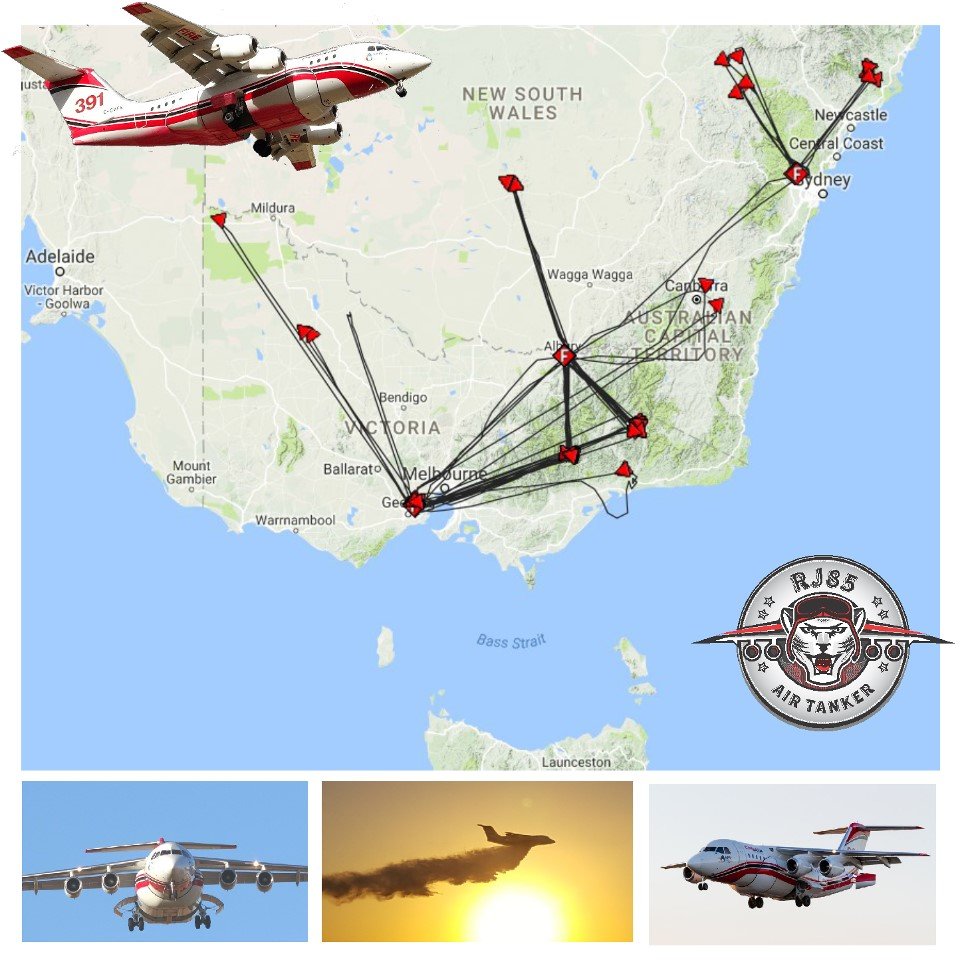
This graphic shows the RJ85’s work and where the aircraft operated this season. Graphic credit to Field Air.
The Coulson Name is featured a lot when it comes to aerial firefighting in Australia. The company has operated Lockheed Hercules aircraft in Victoria and New South Wales now for a couple of years. Established in 1985 Coulson Aviation traces its routes back to the family business of logging in British Columbia, Canada. The company has continued to grow and now has a large fleet of aircraft which are deployed across Canada, USA and Australia to name a few. As its operations grew so did the need to establish a local entity in Australia so in 2010 Coulson Aviation PTY was established in Australia to coordinate its operations.
The company shows no signs of slowing down either. Coulson has announced the purchase of six 737-300’s and intends to convert them into 4,000-gallon “Fireliner” air tankers with the first one ready for trialling at the end of this year.. Britt Coulson Coulson’s Vice President of Aviation said they saw an opportunity when Southwest Airlines made a decision to replace their 737-300’s with new 737-Max.The first conversion has started, with a freshly painted 737 scheduled to roll out of the paint shop in Spokane on May 22, 2017. The next step is to add the gravity-based tanks which will have the same technology used on their C-130’s.

Coulson’s first Boeing 737 Fireliner N617SW is a former Southwest Airlines Boeing 737-3H4 fitted with winglets. (Photo from Coulson)

Coulson’s first Boeing 737 Fireliner N617SW is a former Southwest Airlines Boeing 737-3H4 fitted with winglets. (Photo from Coulson)
This Season saw the company deploy L-382G which is the civilian versions of the military, Lockheed C-130H-30. Coulson was contracted by the NSWRFS to deploy this aircraft at RAAF Richmond on the outskirts of Sydney. N405LC ‘Bomber 132’ is designed and certified modification to the L100 to integrate a 4,300 US gallon firebombing system. This system is a derivative of the well regarded Aero Union RADS 1 firebombing tank. A 15,450 litre load of fire retardant solution can be carried on board the aircraft. The GPS linked computer controlled firebombing system delivers a constant flow of fire retardant or suppressant to the target area. The flexibility of the L100 design is a reason why it’s a successful fire fighting platform with a full retardant load on a 45 degree Celsius day the aircraft requires a 1,950m runway. Shorter runways can be utilized with a lighter load or on cooler temperature days. The aircraft is able to stay in communication with both air and ground support equipment, oil the fire ground thanks to its sophisticated communication and tracking equipment.
L100-30 Overview:
- Type 1 Airtanker
- Primary role: Firebombing
- Other roles: Transport
- Two pilots and one flight engineer
- RADS-XXL constant flow firebombing system 15,450 litre retardant capacity
- Cruise speed (loaded) 545 km/h Typical cruise altitude (loaded) 12,500 feet T
- Typical runway required 1,600m
- Max runway required (full load hot day) 1,950m 34.4m length,
- 40.4m wingspan
- 68,000 kg gross weight
- 4 x 4,500HP Allison 501‐D22A turbo prop engines
- Fuel consumption 2,650 litres/h of Jet-A1
- 2+ fire agency radios,
- Satellite tracking
The second Coulson Lockheed Hercules on contract this season is a C-130Q variant. This aircraft was originally built to a United States Navy configuration as a EC-130Q. The Navy requirement for a communications relaying aircraft to relay information during a national crisis saw the airframe modified for this role. After the service with the Navy the airframe also spent a period of time with the National Air & Space Administration (NASA). Coulson fitted a 15,450 litre tank which can be loaded with a fire retardant solution. The GPS linked computer controlled firebombing system delivers a constant flow of fire retardant or suppressant to the target area.
The C-130Q N130FF and named ‘Hercules’ operated as ‘Bomber 390’ this season while on contract with the Victorian Government through the Emergency Management Victoria (EMV) establishment.
C-130Q Overview:
- Type 1 Airtanker
- Primary role: Firebombing Other roles: Transport
- Two pilots and one flight engineer
- RADS-XXL constant flow firebombing system
- 15,450 litre retardant capacity
- Cruise speed (loaded) 545 km/h
- Typical cruise altitude (loaded) 12,500 feet
- Typical runway required 1,600m
- Max runway required (full load hot day) 1,950m
- 30.3m length, 40.4m wingspan
- 68,000 kg gross weight
- 4 x 4,500HP Allison T56-A-16 turbo prop engines
- Fuel consumption 2,650 litres/h of Jet-A1
- 2+ fire agency radios, Satellite tracking
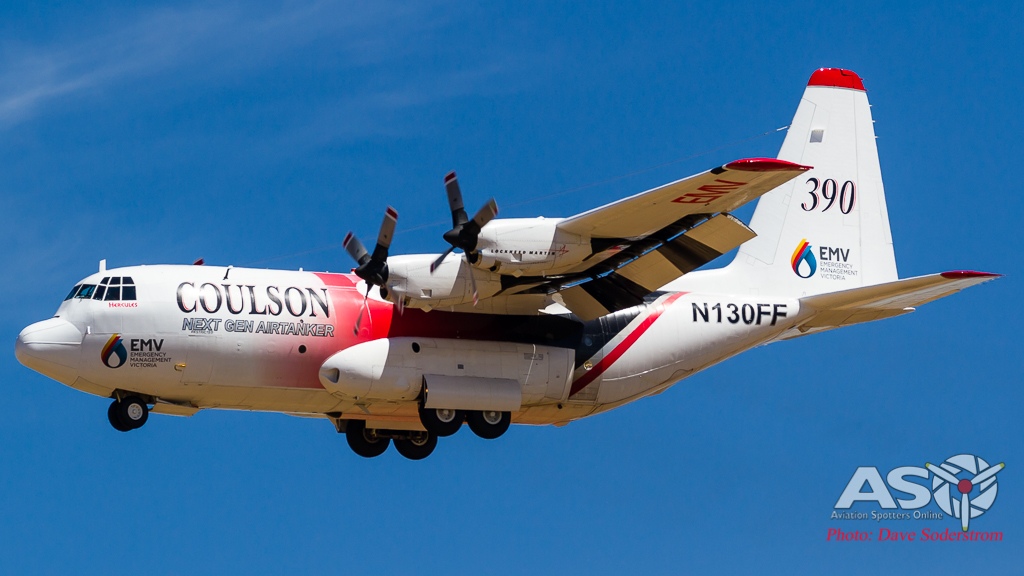
N130FF is seen on arrival, in Avalon at the commencement of its contract to Emergency Management Victoria.
Coulson also announced this year to add a second C-130Q to its fleet. The “new” Tanker 134 is the second C-130Q that they have acquired and should be ready to go in approximately four years. The airframe has recently been relocated after years of storage to a new facility where the overhaul and modification of the airframe will be done.
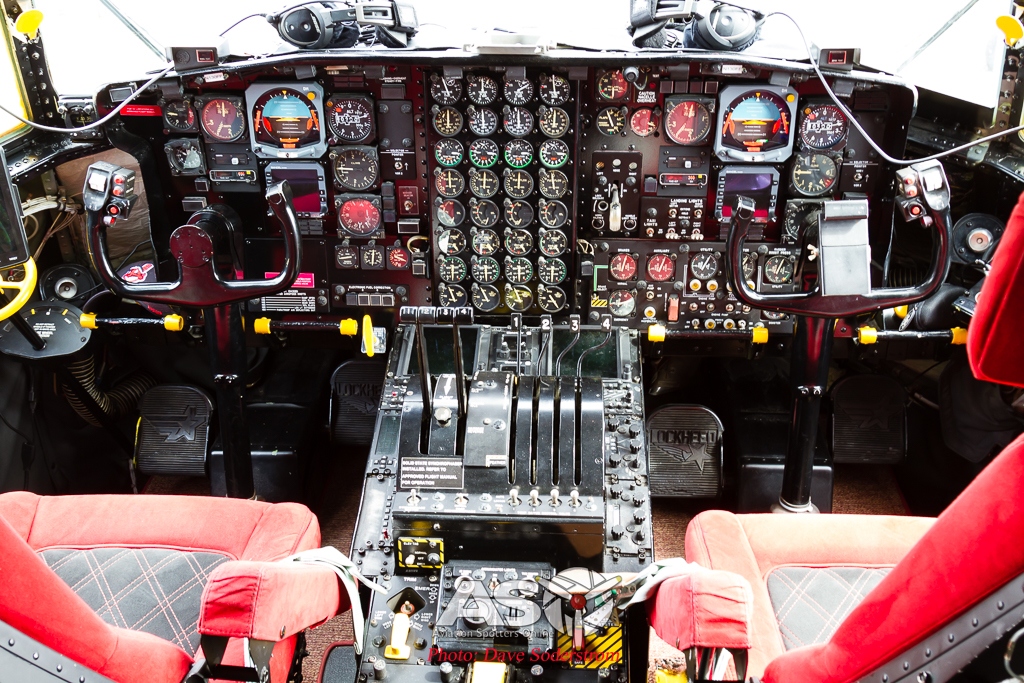
It’s all steam powered in the cockpit of N130FF with a few modern concessions to aid in Navigation and Fire operations.
Small fixed wing fleet
Most numerous of the mixed wing fleet are the Air Tractor with some thirty-nine in the AT-802F and AT-802F Fireboss float equipped versions on contract across Australia this season. The Air Tractor with its 3200 litre tank capacity and agility make it the main weapon of attack. The Air Tractor 802F is a development of the smaller versions and has been designed for fire fighting operations. The aircraft is agile, accurate and is extremely reliable thanks to its rugged agricultural design and powerful Pratt & Whitney PT6A-67AG turbine engine. Due to its agricultural design heritage the aircraft can operate from unprepared strips in forward operating areas to and is able to drop its payload, low and slow, and right where it’s needed to knock down the bushfire or suppress fires in heavier forested areas.

Air Tractors are known for their reliability, flexibility and dependability hence they form a vital part of the Fire Bombing fleet across Australia.

Field Airs, VH-FFM or Fire Fighting Machine, is the latest version of the AT-802F. The advanced version has an increase in horse power to 1300 hp among a host of other modern features to enhance the design of the aircraft.
The Air Tractor AT-802 is available in four different versions:
- Single seat AT-802A which is designed for the demands of Agriculture.
- Single and tandem seat AT-802F are designed for the aerial fire fighting role.
- Single and tandem seat AT-802F Amphibious Scooper Air Tanker, fitted with floats.
- Tandem seat AT-802U Utility Irregular Warfare Aircraft, which is designed as an armed surveillance platform.
The Australian distributor for the sale and marketing of the Air Tractor in Australia, Field Air, based in Ballarat not only sell and support the type here in Australia they also operate a fleet of aircraft on contract and ‘Call When Needed’ Single Engine Air Tankers (SEATs). Five of the AT-802F ‘Advanced’ aircraft are in operation with the company.
Stephen Holding, noted a new concept that was implemented in Victoria this season.
The new concept with what was termed “Harvest Bombers”.
Stephen when onto to explain, “Field Air was pleased to be involved with this concept. Our involvement was a pair of Air Tractor AT-802F SEATs at both Nhill and Ouyen – so four aircraft in total. The aircraft started their contracts earlier than a typical season with the intent to provide aerial firebombing support to communities and brigades as the grain harvest got underway in the Mallee and Wimmera. As part of the concept, we were asked to provide “turnkey” support by way of a mobile support truck and driver capable of providing both refuelling and aircraft loading support. The aircraft were stationed on “Pre Determined Dispatch” otherwise known as PDD enabling them to be launched early in a true initial attack role with the aim of keeping small fires small and protecting communities and yet to be harvested crops. The four SEATs were supported by a medium helicopter also working under the same concept in the Wimmera/Mallee.”
The feedback from the Wimmera/Mallee communities regarding the “Harvest Bomber” concept was overwhelmingly positive. The concept has given local communities faith in a concept that works and hopefully continues.
Air Tractor AT-802 Overview:
- Single Engined Air Tanker
- Call sign “Bomber”
- Single pilot crew 3200 litre capacity
- 7250 kg gross weight
- Drop speed 200 km/h
- Cruise speed 350 km/h
- 11 m length, 18 m wingspan,
- P&W PT6A turboprop engine 1350-1600 HP
- Fuel consumption 280 litres/h of Jet A1
- Gen II Fire Retardant Dispersal System
- Fire retardant or fire suppressant
- 4+ Radios &
- Satellite tracking
Aerotech based in South Australia introduced the Aerotech 1st Response program in 1990 aimed at providing the specialist aerial fire fighting and marine oil spill control equipment to the South Australian Government Emergency Service agencies. As time and technology have progressed Aerotech continues to upgrade their equipment. Currently the fire bombers have or are being fitted with the Trotter Gen II Fire Doors. It is a sophisticated on-board technology, which allows the bomber pilots to choose the requested coverage level and amount of load to be dropped, enabling pinpoint accuracy. Aerotech operates eleven AT-802F aircraft alongside 602 and 502 versions of the Air Tractor.
PZL M18T (Hubler) Dromader
Another Agricultural design turned firefighter the Dromader has been in service for many years now. With its powerful and reliable Honeywell TPE-331 Engine the aircraft the aircraft is able to take on board 2375 litres of either fire retardant or a fire suppressant solution.
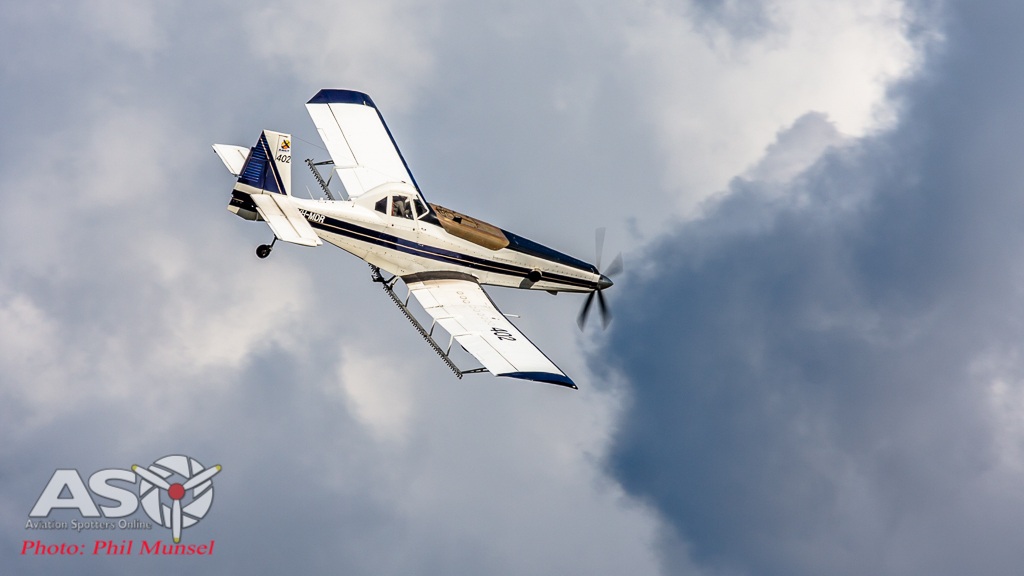
PZL-Mielec M-18B Dromader, VH-MDR operated by R-Mach Aviation shows of its large wing which provides great lift and the ability to maneuver over the fire ground.
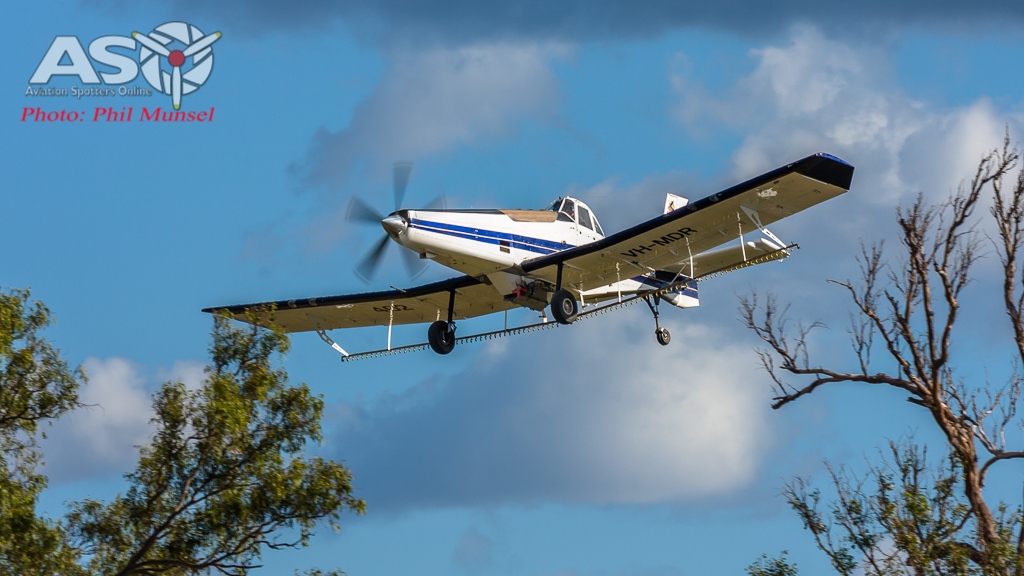
PZL-Mielec M-18B Dromader, VH-MDR operated by R-Mach Aviation shows its under wing set up where it is configured for fire bombing and aerial application spraying.
- Single Engined Air Tanker
- Call sign “Bomber”
- Single pilot crew
- 2375 litre capacity
- 5300 kg gross weight
- Drop speed 160 km/h
- Cruise speed 230 km/h
- 11.3 m length, 18 m wingspan
- Honeywell TPE-331-11 turboprop engine, 1100 HP
- Fuel consumption 240 litres/h of Jet A1
- Fire retardant or fire suppressant
- 2+ fire agency radios
- Satellite tracking
Specialised Role Types, Caravans, Commanders & Skymasters
Many types are employed in dedicated roles including but not limited to, transport of general freight, Fire crews and Passengers, incident mapping Air Attack supervision and fires spotting duties.
The Cessna Grand Caravan can carry up to 12 passengers with greater luggage capacity. The aircraft is very well suited to remote operations in Australia, with its rugged construction and is noted for the types excellent short field performance and good payload. Powered by one of the most reliable turbine engines ever made, the Pratt and Whitney PT6 Turboprop. The PT6A engine family remains the world’s most popular engine in its class and is one of P&WC’s greatest success stories.
This season three Caravans were on contract through the NAFC, one each in New South Wales, South Australia and Victoria. Operated by Pay’s Aerotec and Vortex Air respectively. The three aircraft carried out tasks including the movement of fire crews, and are in some cases fitted with sophisticated communication and tracking equipment which enables crews on the ground to be relayed information on fire movements and behavior.

Vortex Air based at Moorabbin Airport operates two Cessna Grand Caravans and are used during the fire season for transport of personal to active fire grounds. VH-POV, Birddog 387 is seen rotating from Essendon Airport.
208B Grand Caravan Overview:
- Call sign “Birddog”
- Primary role: air attack supervision
- Other roles: reconnaissance / utility aircraft
- Single engine, turbo prop, high wing
- Single pilot, nine passengers
- 3950 kg gross weight
- Cruise speed 300 km/h
- 12.7 m length, 15.8 m wingspan,
- 675 HP Pratt & Whitney PT6A-114A Turbo shaft engine
- Three bladed constant speed reversible propeller
- Fuel consumption 175 litres/h of Jet-A1
- Day, night and instrument flight
- Up to 6 hours endurance
- 2+ fire agency radios
- Satellite tracking
The Rockwell Turbo Commander 690B is a twin engine, high wing, passenger transport aircraft. The Turbo Commander is used by fire agencies primarily for aerial supervision of airtanker operations. Other roles include supervision of fire operations, fire detection, reconnaissance and utility missions carrying the pilot and up to five passengers or crew depending on the mission It is well suited for the role of aerial supervision with its high wing offering excellent visibility from the front seats, and the ability to slow down and loiter in the fire area. When working as a ‘Birddog’ the main responsibility for the crew is to supervise aerial fire fighting operations and to collect intelligence information about a fire and pass it on to the incident management team.
The Turbo Commander also takes on the role of ‘Bird Dog’ on fire grounds as a lead aircraft for Large and Very Large Air Tankers. When working as a ‘Birddog’ the main responsibility for the crew is to supervise aerial fire fighting operations and to collect intelligence information about a fire and pass it on to the incident management team. An on board air attack supervisor will direct air tankers where and how to drop their load on the fire. Another role is acting as the lead aircraft, to direct the activities of the air tankers by both verbal target descriptions and by physically leading the drop profile to show the airtanker where to fly and to identify hazards and landmarks. In some circumstances the Turbo Commander can be used to lead the airtanker through its drop pattern and generate a smoke marker trail at the required drop location.
Again New South Wales and Victoria saw the types employed to work in conjunction with the DC-10, RJ85 and Hercules types on contract.
Commander Overview:
- Call sign “Birddog”
- Primary role: air attack supervision
- Other roles: reconnaissance / utility aircraft.
- Twin engine, turbo prop, high wing
- Single pilot, 5 passengers
- 4650 kg gross weight
- Typical cruise speed 500 km/h
- Typical cruise altitude 18,000 feet
- 13.5 m length, 14.2 m wingspan
- 2 x 717 HP Garrett TPE 331-10 engines
- Fuel consumption 300 litres/h of JetA1
- Day, night and instrument flight
- More than 3.5 hours endurance
- 2+ fire agency radios
- Satellite tracking
- Smoke trail generator
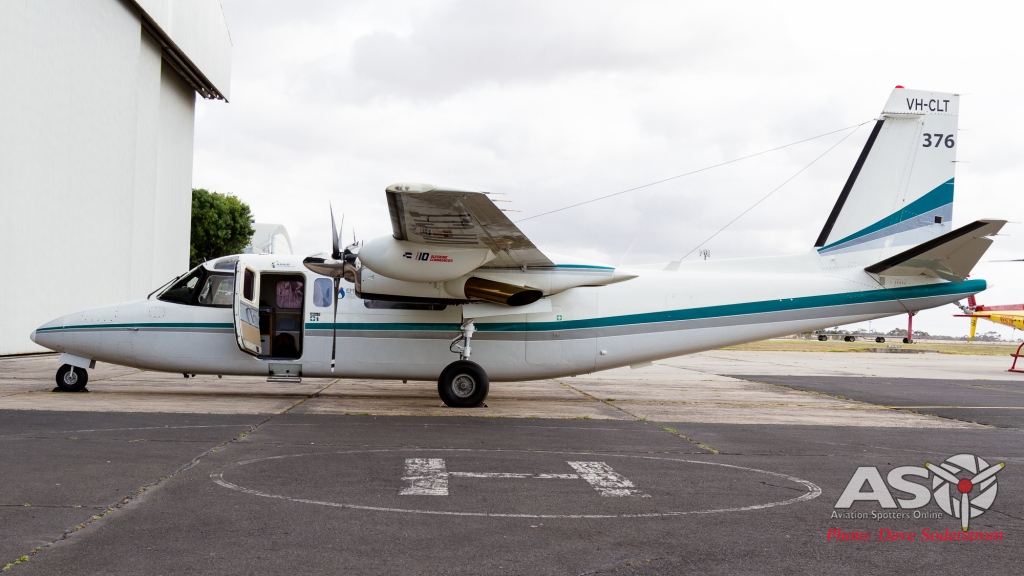
Commander 690A, VH-CLT part of the Tasman Seafood’s fleet was operated in the Birddog role this season, as Birddog 376.
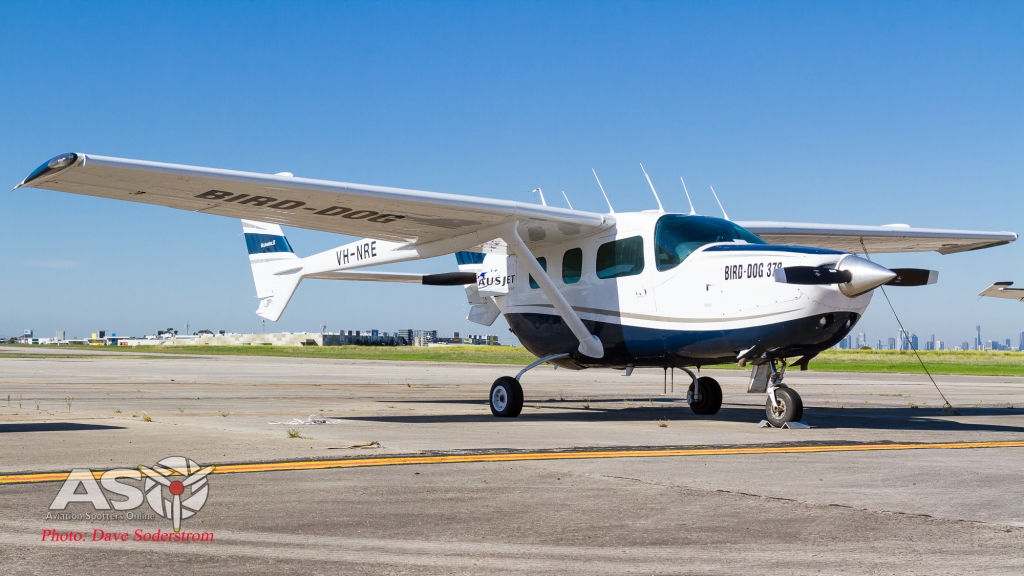
VH-NRE is a Cessna 337G operated by Australasian Jet based at Essendon. The aircraft flies as Birddog 378.
Cessna 337 Overview:
- Call sign “Birddog”
- Primary role: air attack supervision
- Other roles: reconnaissance / utility aircraft.
- Twin engine, turbo prop, high wing
- Single pilot, 5 passengers
- 4650 kg gross weight
- Typical cruise speed 500 km/h
- Typical cruise altitude 18,000 feet
- 13.5 m length, 14.2 m wingspan
- 2 x 717 HP Garrett TPE 331-10 engines
- Fuel consumption 300 litres/h of JetA1
- Day, night and instrument flight
- More than 3.5 hours endurance
- 2+ fire agency radios
- Satellite tracking
- Smoke trail generator

VH-RGE, Cessna U206F operated by Australasian Jet flies as Firespotter 382. This important role allows crews on the ground and air to deliver a fire attack in a timely and efficient method.
Cessna 206 Stationair Overview:
- Single Engine High wing Call sign “Fire spotter”
- Reconnaissance / utility aircraft
- Single Engine High wing
- Call sign “Fire spotter”
- Single Pilot five passengers
- Capacity: five passengers
- Length: 8.61 m wingspan 10.97 m
- Max. takeoff weight 1,632 kg
- 1 × Lycoming IO-540-AC1A air-cooled flat-six engine, 300 hp (224 kW)
- Cruise speed: 263 km/h
Rotary Wings
The rotary fleet is also an integral part of fire operations in Australia, so let’s break down the types and their respective roles. The rotary fleet this year saw new types and new technology as mentioned previously deployed. The rotary fleet continues its grown and evolution as new types are introduced to prove their capabilities. The usual types including Squirrels, 212/412 and Aircranes were deployed around the country with the results we have come to expect from these well established types. The new kid on the block this season and one which was not only visually impressive, also proved operationally impressive was the Timberline/Pay’s UH-60A Blackhawk
Rotary wing aircraft capable of firebombing will be assigned a Type based on their internal payload and water carrying capacity, as specified below.
| Type | Internal payload | Water Carrying capacity |
| 1 | 2,268 kg or greater | 2,650 litres or greater |
| 2 | Between 1,134 kg and 2,267 kg inclusive | Between 1,135 litres and 2,649 litres inclusive |
| 3 | Between 544 kg and 1,133 kg inclusive | Between 380 litres and 1,134 litres inclusive |
| 4 | Less than 544 kg | Less than 380 litres |
Timberline Sikorsky UH-60A Blackhawk
Pay’s Air Services this year brought a new type to Australia a converted ex US Army UH-60A Blackhawk Operated in conjunction with Timberline Helicopters based at Sandpoint, Idaho in the USA, the helicopter N434TH in its extremely attractive blue and orange livery operated this season as Helitak 260. Deployed from Pay’s Scone base in the New South Wales the aircraft was out showing its capabilities and was soon in action working in NSW and Victoria on fires.
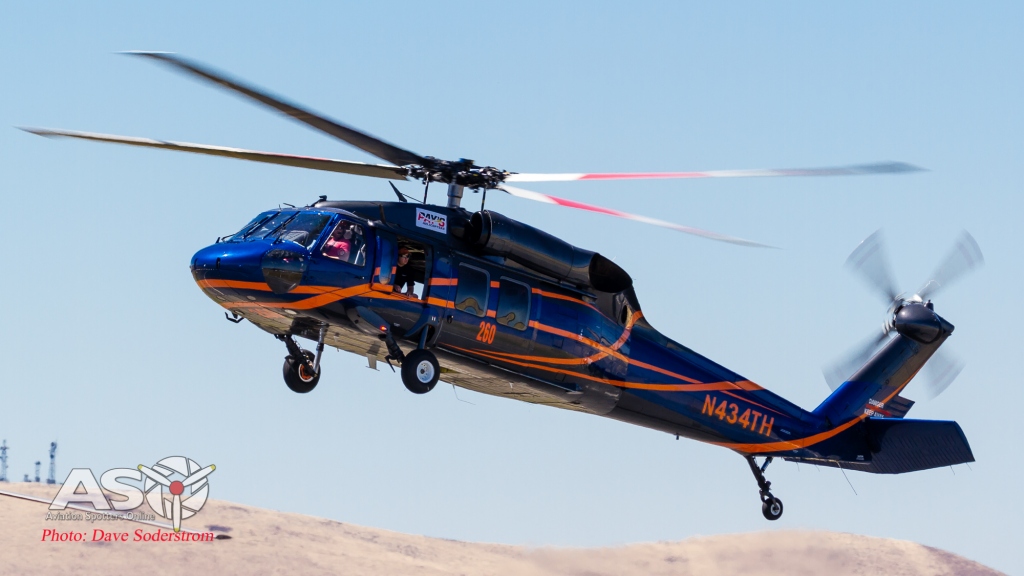
UH-60A Blackhawk N434TH arrives at Ballarat Airport to support operations during the extremely high temperatures that were predicted for the week in early January 2017

Operated by Timberline crews and a Pay’s Aviation crew member operated the Blackhawk across the east coast this season with great results.
Coulson Sikorsky S-76A
The two helicopters used in the night ops trial, S-61 (Helitak 347) will be used to carry out firebombing operations in tandem with the S-76 (Firebird 322) which will be used for reconnaissance. The S-67 was debuted at Avalon Airshow where its crew were on hand to explain the system and trial. The Night Fire Suppression Operations (NFSO) – Aviation Trial is done in partnership with Forest Fire Management Victoria, CFA, National Aerial Firefighting Centre (NAFC) the Civil Aviation Safety Authority (CASA) and Coulson Aviation.
Erickson S-64E Aircrane
A regular feature across Australia is the now well established Erickson Air Cranes. Six of the types were deployed this season with them being in based as follows:
- S-64E N217AC/740 ‘Malcolm’ based in Essendon
- S-64E N218AC/734 ‘Elsie’ based at Bankstown
- S-64E N957AC/748 ‘Ichabod’ based at Moorabbin
- S-64E N154AC/739 ‘Georgia Peach’ based Serpentine
- S-64E N164AC/747 ‘Incredible Hulk’ based at Brukunga
- S-64E N194AC/741 ‘Delilah’ based at Bankstown
The Aircrane is well established across the country as a Type 1 class helicopter, the payload is the heaviest of all helicopters that were on contract this season. The type’s ability to haul 7,500 litres of water or a mixed load of Phos-Chek MVP-F which is a medium viscosity retardant makes it extremely versatile on large scale fires. The Aircranes ability to be loaded on the hard-standing, draw water via its Ram Scoop Hydrofoil or its hover snorkel give the type unrivaled flexibility. The pilots can choose from eight different computerized coverage drop levels to maximize the suppression on the fire front. The Aircrane can and does also get operated with its tank removed and using a long line and Bambi bucket.
When speaking to one of the Erickson crew chief’s it was interesting to note that many people still don’t understand the capabilities offered by these aircraft. The ability to draw water from static water sources i.e. Dams and should the need arise and to maximize turn around’s the ability to draw sea water via the Hydrofoil scoop can dramatically reduce the first spread as the Air Crane is very flexible for the task at hand. Something the crew chiefs were keen to emphasize after this year’s fire season.
S-64E Aircrane Overview:
- Call sign “Helitak”
- Primary role: Firebombing
- Other roles: Heavy lifting
- Twin engine heavy helicopter
- Two pilots for firebombing operations
- 7560 litre firebombing tank
- 7700 kg realistic external load
- 19090 kg gross weight
- Cruise speed 215 km/h
- Six bladed main rotor
- 26.8m length, 22.0m rotor diameter
- 2 x 4500HP Pratt & Whitney JFTD12A-4A turbo shaft engines
- Fuel consumption 1985 litres/h of Jet-A1
- 2+ fire agency radios
- Satellite tracking
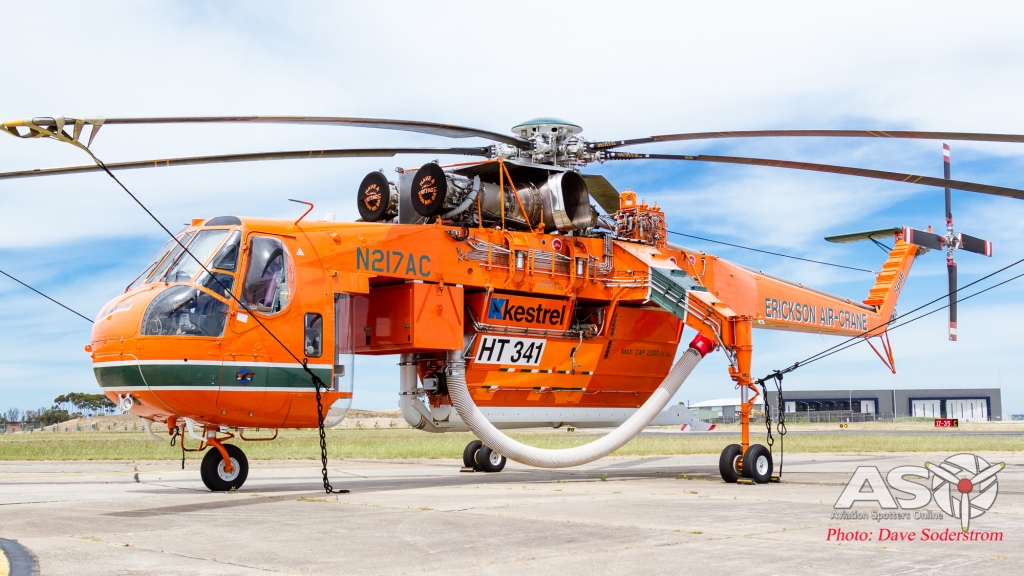
N217AC ‘Malcolm’ S-64E, Erickson Air Crane operated as Helitak 341 this season, operating from Essendon.
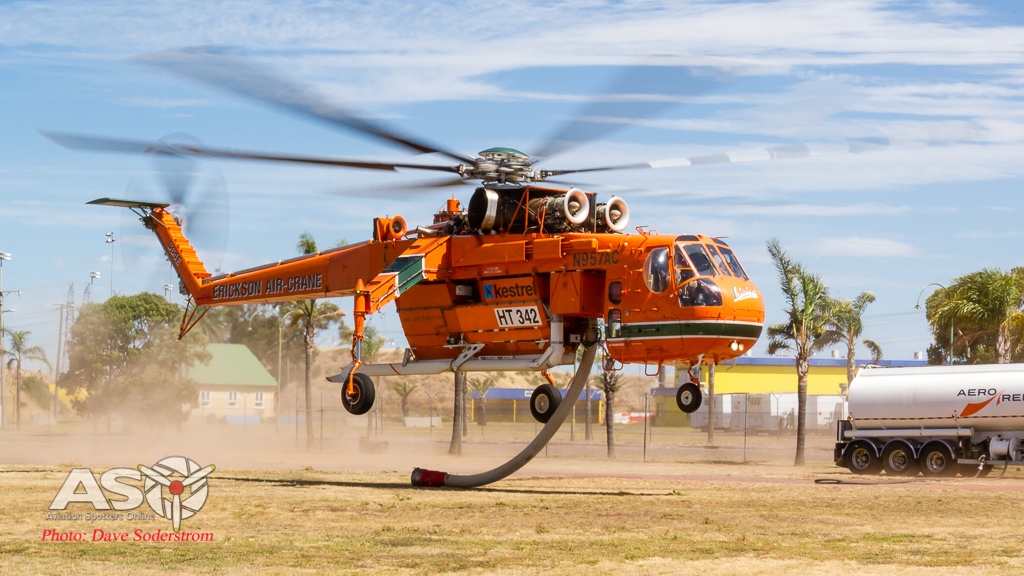
After refuelling the ‘Icabod’ lifts off where it will use the suction line to draw fluid to fight a fire on Melbourne’s outskirts.
N218AC ‘Elsie’ S-64E, Erickson Air Crane operated as Helitak 734 this season, based at Bankstown, seen here working at the Mudgee fire.
Coulson Sikorsky S-61N
Coulson Aviation Sikorsky S-61N ‘Helitak 347’ C-FMAY and ‘Helitak 348’ C-FIRX again took up operating from a base in Colac and Mansfield in Victoria. This type of aircraft has been operating in Australia now for seven years. Equipped with the ability to fly with either a 4000 litre capacity water tank or as a 3000 litre Bambi bucket equipped aircraft. The S-61N is a multi-role aircraft. It can be readily reconfigured from firebombing with a tank too long line operations with a power-fill bucket. It can also be used to transport up to 18 passengers in airline style, comfort or large amounts of cargo inside the aircraft or slung underneath. The S61N is also fitted with a single line rappel system. With this rappel system the aircraft is used to insert fire fighting crews into areas too remote to quickly access by road or foot.
S-61N Overview:
- Call sign “Helitak”
- Primary roles: Firebombing, fire crew insertion
- Other roles: Transport, utility
- Twin engine helicopter
- Coulson single line rappel system
- Single pilot, up to eighteen passengers
- 4000 litre firebombing tank
- 9980 kg gross weight
- Cruise speed 225 km/h
- Five bladed main rotor
- 21.95m length, 18.9m rotor diameter
- 2 x 1500HP General Electric CT58-140 turbo shaft engines
- Fuel consumption 625 litres/h of Jet-A1
- 2+ fire agency radios
- Satellite tracking
Bell Helicopters 204/205/206/212/214 & 412
The Bell line of Helicopters has been synonymous with fire fighting in Australia for many years. This season was no different and is by the numbers still the most populous around Australia. Some 33 different Bell Aircraft types were noted on the contract as part of the NAFC this season, broken down this included six B206 Long Rangers, two B204 Hueys, six B212, six 412 and thirteen 214B Big Lifters.
Many local long term operators in Australia fly the Bell 212/214 and 412s, Jayrow, Professional Helicopters, McDermott, Forest Air and Kestrel helicopters as examples have flown the type which is ideally suited to the local conditions where the larger type 1 isn’t. The type 2 helicopters are extremely versatile and their excellent handling, lift capacity and flexibility are the reason so many are on contract.
Bell 412 Overview:
- Call sign “Helitak”
- Primary roles: Firebombing, fire crew insertion
- Other roles: Transport, utility
- Twin engine helicopter
- 270kg, 75m ‘Goodrich’ winch or two line rappel system
- Single pilot, up to eleven passengers
- 1400 litre firebombing tank
- 5400 kg gross weight
- Cruise speed 225 km/h
- Four bladed main rotor
- 17.1m length, 14.0m rotor diameter
- 1800HP Pratt and Whitney PT6T-3BF Twin-Pac engine
- Fuel consumption 410 litres/h of Jet-A1
- 2+ fire agency radios
- Satellite tracking
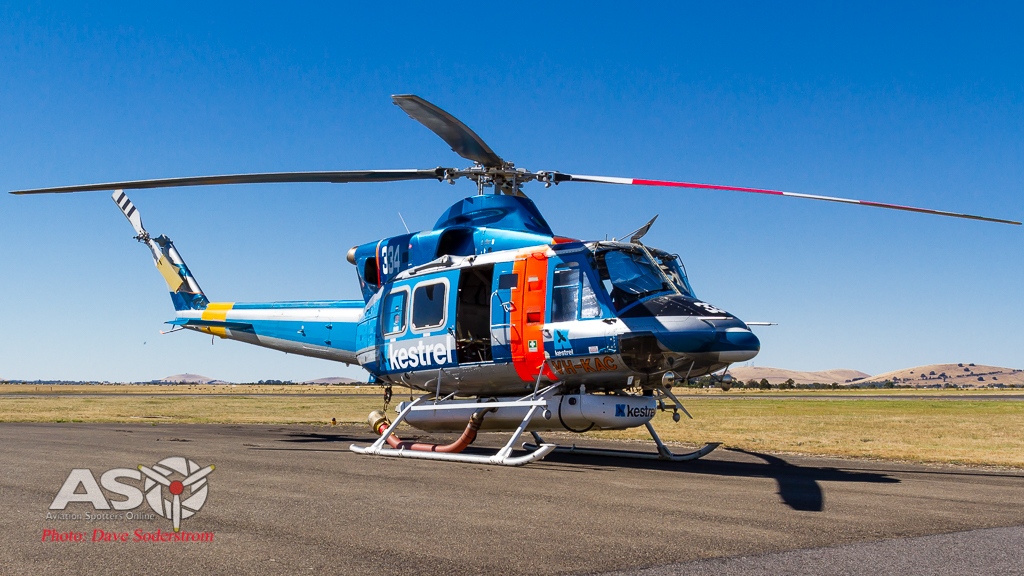
Kestrel Aviation’s Bell 412SP VH-KAC, ‘Helitak 334’ at its Ballarat base in Victoria. This 412 was originally delivered to the Tokyo Metropolitan Police in Japan as JA6635. Flying with them from 1990 until 2009. It came to Australia in 2010. Kestrel have cooperative agreement with Erickson Incorporated, to operate the Erickson S-64 Aircrane in Australia.
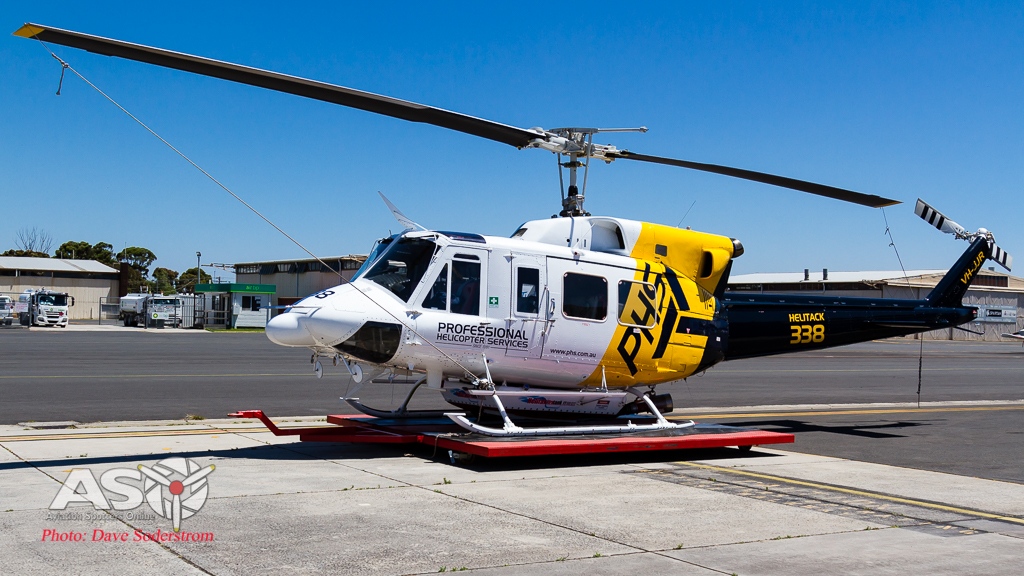
Professional Helicopters acquired several of the Heliserv assets in 2016 which saw the helicopters emerge in a striking new colour scheme. Helitak 338 or VH-JJR was one of them.

Purchased new from Bell by the Royal Thai Army and for a number of years flew as part of the VIP fleet tasked to His Royal Highness Prince Maha Vajiralongkorn. The aircraft was sold on and moved to Australia in 2008 and has been fitted with a 1600 Litre underslung tank, as seen here having been refilled.

McDermott Aviation’s Bell 214 VH-SMI operates as Helitak 418, is seen undergoing maintenance at the companies dedicated helicopter centre at Jandakot.
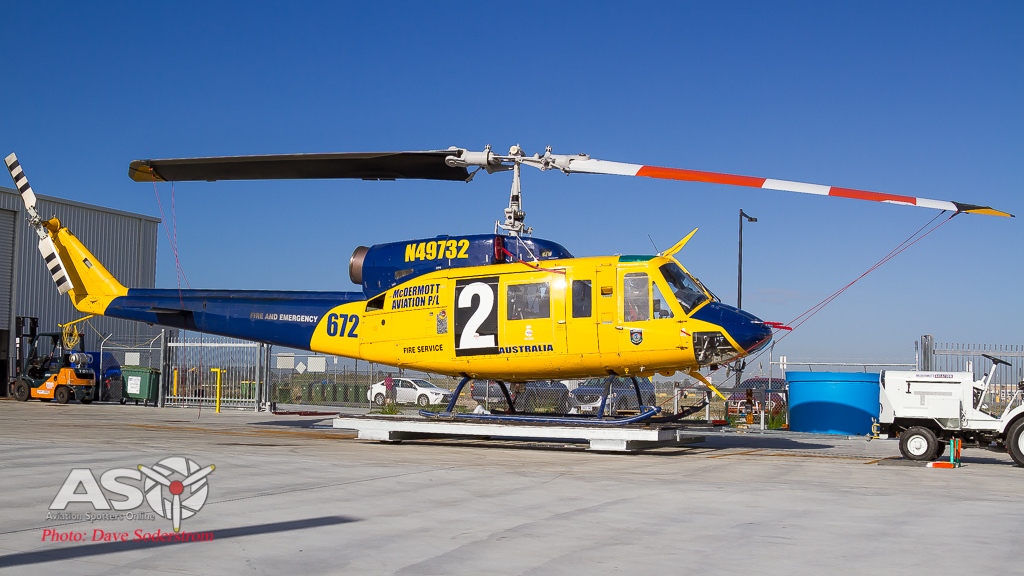
McDermott Aviation’s Bell 214 N49732 operating as Helitak 672, is seen undergoing maintenance at the companies dedicated helicopter centre at Jandakot.
214B Big Lifter Overview:
- Call sign “Helitak”
- Primary role: Firebombing
- Other roles: passenger / cargo transport
- Single engine helicopter
- Single pilot, up to 14 passengers
- 2650 litre firebombing tank capacity
- Cruise speed 240 km/h
- Two bladed main and tail rotors
- 6300 kg maximum take-off weight
- 17.7 m length, 14.7 rotor diameter,
- 2950 HP Lycoming T5508D turbo shaft engine
- Fuel consumption 600 litres/h of Jet-A1
- 2+ fire agency radios
- Satellite tracking

McDermott Aviation’s Bell 214 N281JL operating as Helitak 335 is seen departing Bendigo Fire base heading out to fight a fire.
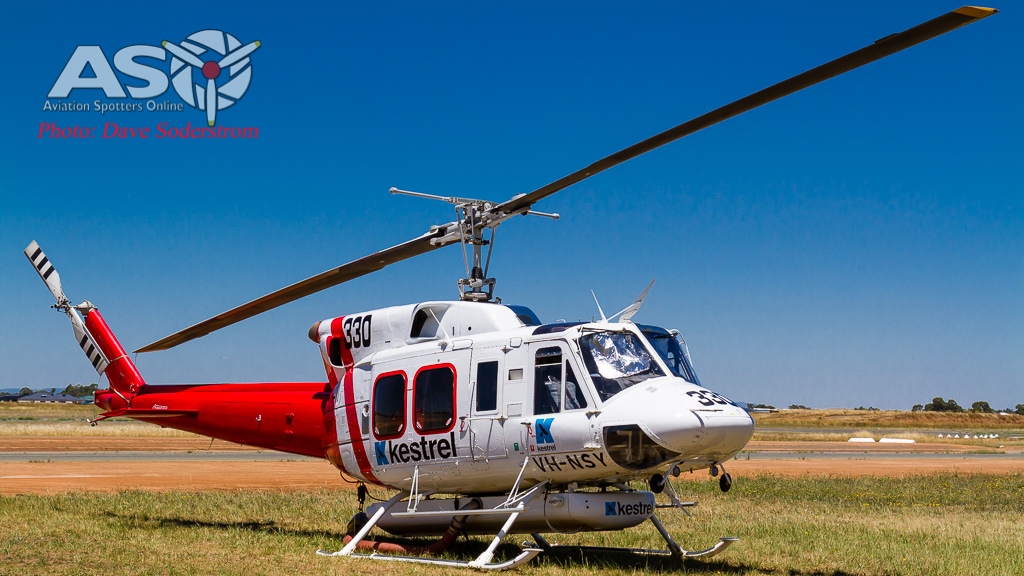
Kestrel Aviation’s Bell 212 VH-NSY Helitak 330 is one of several Kestrel operated machines on contract, and is shown here at its Shepparton operating base.
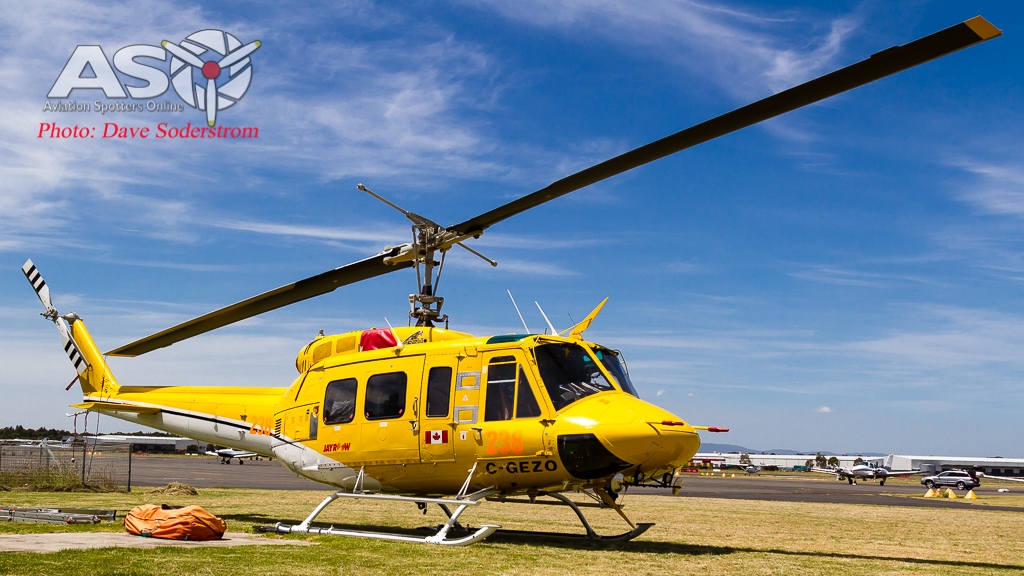
C-GEZO was the second Bell 212 on contract this season that Jayrow lease from Great Slave Helicopter’s.
Bell 212 Overview:
- Call sign “Helitak”
- Primary roles: Firebombing, fire crew insertion
- Other roles: Transport, utility
- Twin engine helicopter
- Two line rappel system
- Single pilot, up to fourteen passengers
- 1477 litre firebombing tank
- 5090 kg gross weight
- Cruise speed 185 km/h
- Two bladed main rotor
- 17.4m length, 14.6m rotor diameter
- 1800HP Pratt and Whitney PT6T-3BFTwin-Pac engine
- Fuel consumption 340 litres/h of Jet-A1
- 2+ fire agency radios
- Satellite tracking
Bell 206L-3 LongRanger Overview:
- Call sign “Firebird”
- Primary role: air attack supervision
- Other roles: reconnaissance / utility
- Single engine helicopter
- Single pilot, six passengers
- 1800 kg gross weight
- Cruise speed 220 km/h
- Two bladed main and tail rotors
- 13.0 m length, 11.3 rotor diameter
- Rolls Royce / Allison C30P Turbo shaft engine
- Fuel consumption 140 litres/h of Jet-A1
- 650 HP available at take off
- 2+ fire agency radios
- Satellite tracking
Bell 205/UH-1H
Bell Helicopters introduced a civilian version of the military UH-1H designated Bell 205A. The main difference e being a derated T5313B engine. This version was aimed for the civilian market of use in Air Freight, Air Ambulance and executive transport. Ironically the 205 variant went into military service when it was licenced produced for the Japanese (by Fuji-Bell) and Italian (by Agusta-Bell) for their respective armed forces and in the Agusta version also for civilian service. This season Great Salve Helicopters a Division of Discovery Air based in Etobicoke Ontario, Canada have provided a single 205B and a Bell 212 on lease to Victorian operator Jayrow Helicopters based in Moorabbin.
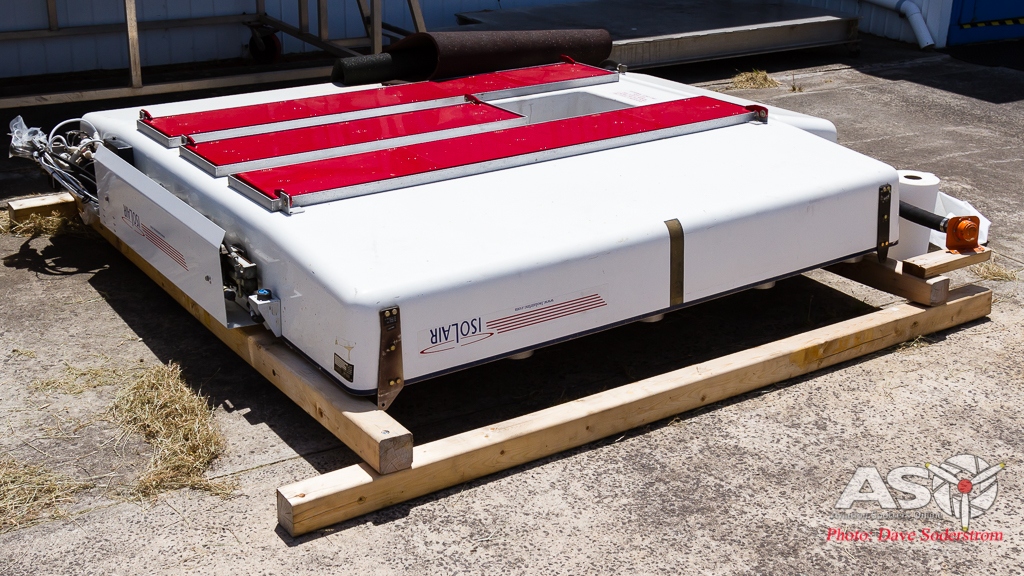
C-FNTR can operate with a Bambi bucket or a Isolair 4600-205 ELIMINATOR II underslung tank. Isolair have been producing tanks for Fire fighting tasks since the early 1980’s. The 1300 litre tank can be fitted in a timely fashion to meet a fire agency’s requirement.
Touchdown Helicopters UH-1H Iroquois VH-OXE based at Illawarra Regional Airport, Wollongong, flying as Helitak 223.
Airbus Helicopters (Eurocopter) Fleet:
Well suited for the fire fighting role the Squirrel has been and will continue to be deployed as its agility and payload make it ideal. Not all Squirrels on contract season are deployed for firebombing the type is well suited for the fire supervision role, winching and general utility work. One local operator Microflight have set two airframes up with highly sophisticated fire monitoring systems.
The Squirrel as a type is operated in both single AS350 and twin engine AS355 versions. The Queensland and Western Australian Governments contracted a single example, each of the Twin Squirrel this season. The Twin is powered by two Rolls Royce Allison 250-C20F turbo shaft engines with 840 HP available at take off.
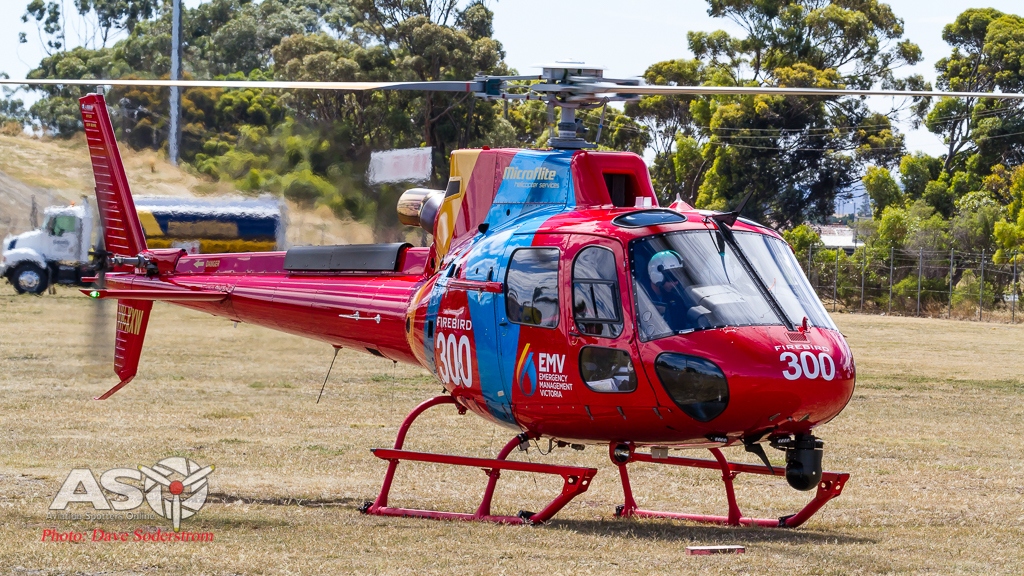
Microflight based in Moorabbin operate two similar configured AS-350 B3 Squirrel’s with fire monitoring equipment which operate with the Wescam MX-10 camera. VH-XXW operated as Firebird 300.
AS350B3 Squirrel Overview:
- Call sign “Firebird”
- Primary roles: Firebombing, supervision, winching
- Other roles: Reconnaissance, utility
- Single engine helicopter
- Single pilot, up to five passengers
- 1100 litre firebombing tank or bucket
- 2800 kg gross weight
- Cruise speed 200 km/h
- Three bladed composite main rotor
- 12.9m length, 10.7m rotor diameter
- Turbomeca Arriel 2D turbo shaft engine 847 HP available at take off
- Fuel consumption 160 litres/h of Jet-A1
- 2+ fire agency radios
- Satellite tracking
Another type employed this season is the Airbus Helicopters EC120B Colibri. The type is suited to the supervision of firebombing operations with its high speed, enabling it to keep up with the largest of firebombing helicopters and the ability to slow down and loiter in the fire area.
Eurocopter AS365N2 Dauphin
The Dauphin is a unique helicopter in the fire fighting fleet. It has several attributes which make it highly useful in an emergency situation, with its high transit speed, large cabin for passengers, and powerful engines for lifting its an extremely adaptable type. The ability to winch fire crews into areas also is another useful capability. McDermott Aviation operates several of the type and these have been seen in New South Wales and Queensland.
- Call sign “Helitak”
- Primary roles: Fire crew insertion, Firebombing Other roles: Transport, utility
- Twin engine helicopter 270kg 100m ‘Air Equipment’ Winch
- Single pilot, up to eight passengers
- 1025 litre firebombing bucket
- 4250 kg gross weight
- Cruise speed 260 km/h
- Four bladed composite main rotor
- 13.7m length, 11.9m rotor diameter
- 2 x 750HP Arriel 1C2 turbo shaft engines
- Fuel consumption 340 litres/h of Jet-A1
- 2+ fire agency radios
- Satellite tracking
EC120B Colibri Overview
The EC-120 design is a five-seat, single-engine, light helicopter. Jointly designed by Eurocopter, China National Aero-Technology Import & Export Corporation (CATIC), Harbin Aviation Industries (Group) India, (HAIG) and Singapore Technologies Aerospace Ltd (STAero) at Eurocopters, Marignane facility, the EC120B is assembled by Eurocopter in France and also in Australia. The first prototype flew in 1995 and in 2002 the Brisbane assembly facility was opened where the MRH-90 was also assembled.

Jayrow Helicopters based at Moorabbin Airport in Victoria operate VH-JYX with flies as Firebird 305, based at Bendigo for the Victorian contract.
- Call sign “Firebird”
- Primary role air attack supervision
- Other roles reconnaissance / utility
- Single engine helicopter
- Single pilot, four passengers
- 1715 kg gross weight
- Cruise speed 220 km/h
- Three bladed main and eight bladed tail rotors
- 11.5 m length, 10.0 rotor diameter
- Turbomeca Arrius 2F Turbo shaft engine
- Fuel consumption 100 litres/h of Jet-A1
- 500 HP available at take off
- 2+ fire agency radios
- Satellite tracking
When working as a ‘firebird’ the primary responsibility for the crew is to supervise aerial fire fighting operations and to collect information about a fire and pass it on to the incident management team. The EC120B is also used for utility missions, including ferrying passengers and cargo.
As we move forward there is already new plans and trials being developed for the 2017-18 Fire Season. A lot of crews are deployed across the globe fighting fires. Locally training and workups with local brigades has begun to further enhance the usefulness of these amazing machines and their crews.
We hope this article highlights the important roles the types operated by the fire services around the country, the crews operating them, maintaining them and protecting the assets we all cherish.
Aviation Spotters Online wishes to thank Stephen Holding, Britt Coulson and Wayne Rigg for their input into this article.
To all members of the fire services both in the air and on the ground stay safe and know that the whole country has your support for the tireless work you all do.
Dave Soderstrom
